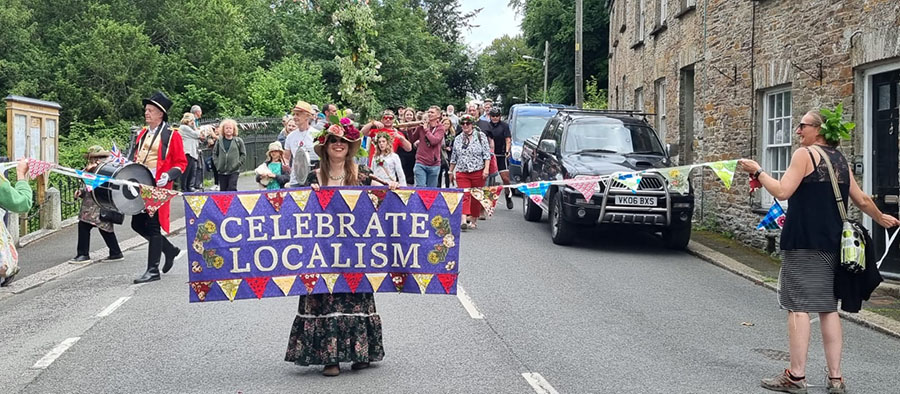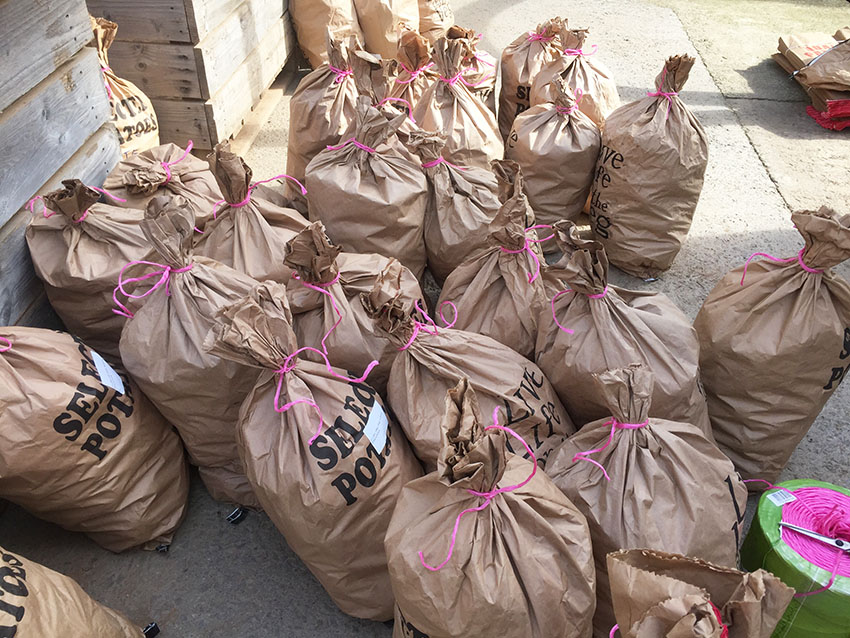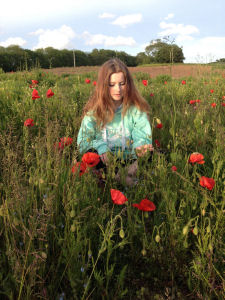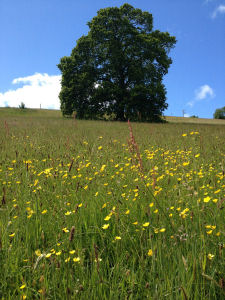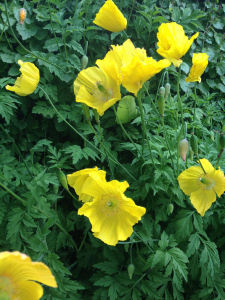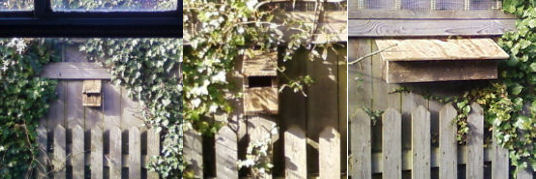The Railholiday Nature and Environment Blog
We now have a new blog page! Please follow this link to go to our new site or click on the image below. All articles prior to mid March 2023 are listed below.
Welcome to our blog - an occasional look at the changing seasons and observations on wildlife spotted in Hayle and St Germans, with a hefty dose of musings on sustainability. This blog includes articles written for our local newsletter under the title of Simple Ways to Save the Planet. I would like these to be open source, so do feel free to use as you wish. If you have a parish magazine or local newspaper, I would be very happy for these to be reused - no permission needed.
Articles (in date order) | On Microplastics | On Seasonal Salads
| Changing Seasons | Positivity and Holiday Planning | Water, Water, Everywhere | A New Year | On Wild Camping | On the Knowledge of Elders | From Rainforests to Municipal Trees | On the Importance of Peaceful Protest | Observations from a bicycle saddle | On Passing the Buck | Adopt a Tree | On Preserving the Abundances of Autumn | Secondhand September | Drought. The New Normal? | Measuring Success | Water Saving Tips | Live and Let Live | A Platinum Jubilee | Decarbonising Food | Holidays | Meaningful Action to Help Ukraine | On waste | On Public Transport and Travel | On Gardening and Tree Planting | On Speaking the Truth | Electric Cars Versus Electric Bikes | A Seasonal Poem | On Reducing Waste at Christmas | Time to Get Political | Celebrating Localism | Electric Cars Versus Electric Bikes | Moving Away from Built in Obsolescence | On Want Versus Need | On Fuel Shortages | The Ecological Crisis | Climate Activism | Cathedral Thinking | Redefining the New Normal | On Public Spaces | Simple Ways to Save the Planet | On Banks and Pensions | Learning to Love Weeds | Snowdrops | Bird Feeding for the Future | Beavers for Ecological Growth | Bags from Rags | Identifying Wild Flowers | Life After Covid | A Covid Poem | Actions Speak Louder Than Words | On Community Stalwarts | Holiday Planning | Tips for a Greener Christmas | Gifting Seeds | A Family Holiday and Community Fun | Reducing Air Miles | Railholiday Declare a Climate Emergency | Differentiating Between Want and Need | Going Plastic Free | More Articles...
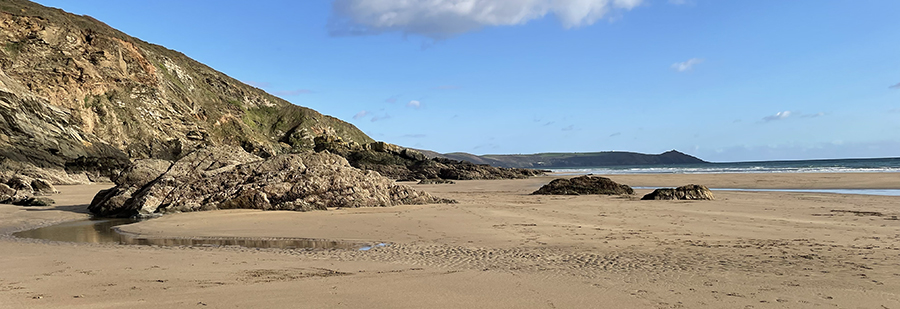
15th March 2023 - On Microplastics
I am an avid beach cleaner, and for years have always taken a bag to the beach whenever I go. After storms there is always a greater concentration of rubbish, and the range of jetsam is fascinating. Most typical are pieces of cut net, plastic tags, discarded cloths and other fishing debris. Plastic bottles are common, as is rubbish that has washed down water courses and found its way to the beach. Despite information campaigns, cotton buds and other plastic items still get washed down the toilet. Then there are items from containers lost at sea. This can be anything from toothbrushes to plastic lighters and pink bleach bottles.
Plastics are very damaging to sea life. Once I found the body of a kittiwake that had a piece of cloth stuck in its throat. Often baby gulls are found dead with their bodies stuffed with plastics unwittingly fed to them by their parents. Then there are the unseen plastics - tiny fibres of plastic based fabrics that contaminate the water when washed.
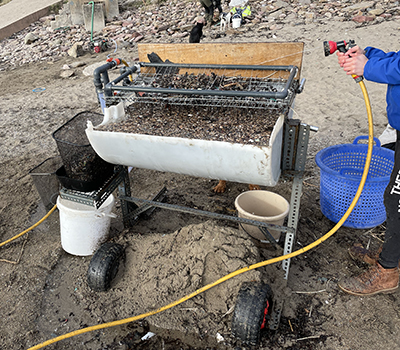 A study by Plymouth University revealed that plastic was found in over a third of UK caught fish. It is estimated that by 2050 there will be more plastic in the sea than fish.
A study by Plymouth University revealed that plastic was found in over a third of UK caught fish. It is estimated that by 2050 there will be more plastic in the sea than fish.
I was born in 1971, so am old enough to remember returning glass bottles for a deposit. I remember a time when shops left out cardboard boxes to put shopping in. My first exposure to plastic water bottles was on a French exchange in the mid 80s; my exchange family would only drink bottled water and were peculiar about my habit of taking water straight from the tap. I would never have guessed that thirty years later water in plastic bottles would become the norm, even in the UK.
When I beach clean I tend to focus on removing the largest items of plastic, to catch them before they break up into tiny pieces and become microplastics. Microplastics are pieces of plastic ranging from 5mm to 10 nanometres. These plastics are particularly damaging because they are so difficult to remove from the environment.
Recently I took part in a beach clean focusing on micro-plastics, that was organised by the wonderful Rame Peninsula Beach Care group. Rame Peninsula Beach Care focus on raising awareness of plastic pollution, and as well as cleaning the beaches have created some spectacular works of art from the rubbish; a couple of their larger pieces can be seen at Plymouth Aquarium and Cawsands.
The experience of sifting sand for microplastics was overwhelming. Despite a machine being provided to filter the plastics from the sand, after three hours I still felt I had barely made an impression on my few feet of sand. And knowing that the next tide will bring more is disheartening; if we had stopped using plastics then the process would be less futile.
Aside from broken fragments of plastic and tiny fabric strands, most of the microplastics were from two culprits; nurdles and bio-beads.
Nurdles are tiny plastic beads that are used for making plastic products; they are the raw ingredient. Some nurdles come from shipping containers lost at sea, others from poor practice in factories where plastic items are made; spillage makes it way onto floors, then inevitably outside, then into water courses. Nurdles can be any colour, but bio-beads are usually blue, black, white or grey. Bio-beads are used in sewage treatment works. These can be traced back by their unique markers, as because our sewage is watered down by run-off water from roads the plastic becomes contaminated with petrochemicals. Although bio-beads are not supposed to make their way to the sea, they still made up a substantial percentage of what we were finding.
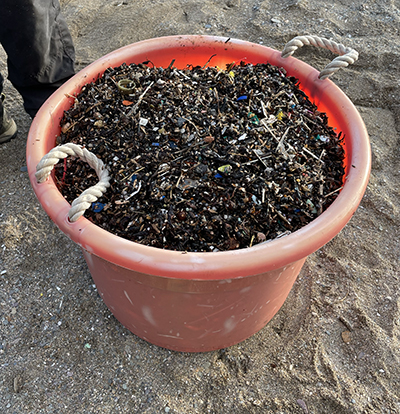 Legislation is what we need most. A UK ban on microbeads (used in cosmetics and toothpastes) has been a very positive move, but we need to go further. Because plastic is not yet legally a pollutant, there are no penalties for contamination by plastics, only voluntary good-practice guidance. We need enforceable rules if we are to have any hope of meaningful change. And inevitably the wheel will turn too slowly.
Legislation is what we need most. A UK ban on microbeads (used in cosmetics and toothpastes) has been a very positive move, but we need to go further. Because plastic is not yet legally a pollutant, there are no penalties for contamination by plastics, only voluntary good-practice guidance. We need enforceable rules if we are to have any hope of meaningful change. And inevitably the wheel will turn too slowly.
In the meantime there are things we can do to help. Be plastic aware. Take containers when shopping and buy unpackaged food. Always keep bags on your person or in your car for shopping. Be aware of what you are flushing down the toilet. Spread the words - what goes down the drain leads to the sea. Always put litter in a bin; even paper takes a while to biodegrade and could potentially be contaminated with traces of plastic. Share your experiences of beach cleaning with the hash tag 2minutebeachclean. Drink water from a tap, and get into the habit of always carrying a reusable water bottle and reusable cup. Get involved with your local beach clean. I highly recommend Rame Peninsula Beach Care. Looe Marine Conservation Group is another local group offering beach cleans and regular events throughout the year.
But most of all campaign for political change, as political change has the ability to add a bandage rather than a plaster to the problem. And remember; every single piece of plastic removed is one less piece doing harm in the sea. We can and we will make a difference.
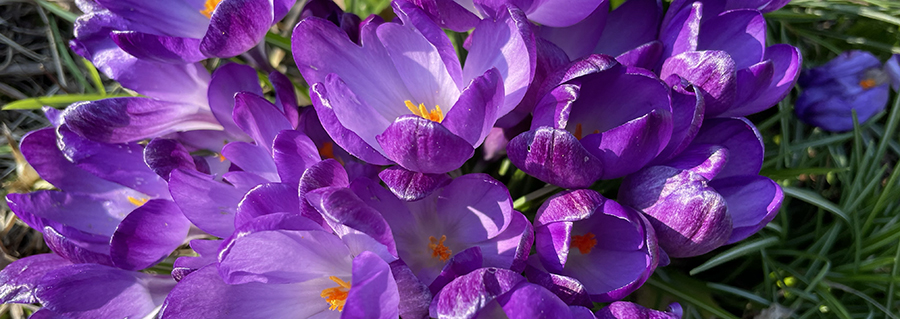
1st March 2023 - On Seasonal Salad Stuffs
A few years ago I gave up supermarkets for lent. For the most part it was a surprisingly easy thing to do, and I haven’t looked back. As a result I have been lucky enough not to be affected by the recent salad shortage. However I have to admit I am rather partial to buying the occasional cucumber and pepper from our well stocked community shop in St Germans.
So this lent I have decided to give up commercially grown salad crops. It is not before time. Salad crops are not great for the environment on a number of levels. They are farmed hydroponically, which means they are grown in nutrient-enriched water and have no contact with soil at all. As a result they are devoid of the trace minerals that are believed to be an important part of a healthy diet.
Commercial salads are grown in vast poly-tunnels, which need to be replaced after a few years. Much of the plastic from the poly-tunnels ends up in stream and river systems, and pollutes the ocean. The products are packaged in more plastic to keep them fresh, and often end up being discarded due to their short shelf life. Post Brexit delays in ports and borders are making the problem worse. I find knowing this helps in the determination to give them up!
At this time of year there are a number of wild alternatives; wild garlic and three cornered leeks are appearing in the hedges, bramble tips are getting large enough to eat (they have a tasty nutty flavour), dandelion leaves will soon be in season and there is no shortage of pennywort (also known as navelwort) in our hedges; look for the round succulent leaf with a dip in the centre. Because wild salads are often more bitter than we are used to, a tasty salad dressing of cider vinegar, mustard, olive oil, honey and herbs is worthwhile having to hand, and with a sprinkling of nuts makes a very tasty meal. Learning to forage has many advantages, including saving money, but it is important to research well first as some plants are very poisonous. Richard Mabey’s Food for Free and Wild Foraging in Cornwall and the Isles of Scilly by Rachel Lambert are my recommendations. It is also important to only pick from uncontaminated places, so avoid road verges or busy footpaths. Growing dandelions in your garden is a good place to start!
Being able to source local food is an important step towards resilience. Buying a veggie box from a local organic supplier such as Keveral Community of Growers is one of the best ways of learning to eat seasonally, and offers good value for money. Tamar Grow Local is another local food coop, who deliver to Saltash. We also have several excellent local fruit and veg shops; Beddoes in Liskeard, Widdicombes in Millbrook, Applejack Barn at Tamar View Nurseries, Tredinnick Farm Shop and Quayside Fresh in Looe are just a few that spring to mind - I know there are many more and apologise that this list is not comprehensive! The important thing is to find the one most local to you and become a regular. If you have a community shop nearby, as we do in St Germans, then becoming a volunteer can be socially enriching.
Along with our fresh food, dried and tinned staples are essential. Local independent shops will often offer services that supermarkets do not. We have developed a good relationship with our village shop, who will source things they don’t normally stock as a special order, so I am able to bulk-buy organic beans, tomatoes, oats etc. for a good price. We are spoilt in South East Cornwall as we have some really excellent local independent food stores, but we do need to use them, or we will lose them.
I have to admit to harbouring a desire to move completely away from commercial food, and have been binge watching a channel on YouTube called No Milk Today. The short films follow the fortunes of Max Cotton, a hobby farmer from Somerset, as he lives for a year solely on food produced on his smallholding. It is an inspirational project, and not one most of us could emulate, but it does have some very useful messages for eating in a sustainable way. One of my favourites is that it is okay to have the same food every day for several days on end - when things are truly fresh they are delicious and don’t become boring. I couldn’t agree more.
9th February 2023 - Changing Seasons
Regular readers of this column will know that I run a business called Railholiday. Last weekend we had an open day, which we really enjoyed, and many thanks to all who came. As well as having the opportunity to show off our carriages, gardens and woods, we raised over £500 for charity, which we were thrilled about.
We chose the last weekend in January because usually it is a time our winter gardens and woodland snowdrop walk are starting to look at their best. Usually in by the end of January the earliest camellias have been flowering since new year, the lungwort is popping up, the pretty yellow and purple crocuses are peeping through the lawn, there’s a few early daffodils in bloom and the snowdrops have fully opened their skirts and are putting on a fine show. However this year proved to be exceptional, and everything is behind.
We noticed a few weeks ago things seemed to be slower. It could be a result of the bulbs becoming very dry during the summer drought, or, more likely, having been knocked back by the very cold weather we had before Christmas.
After the first hard frosts, the temperature soared, going from minus five to double figures in less than two days. This will inevitably have had a negative effect on wildlife, which will have woken up thinking spring was here, only to find there was no food, and be greeted by the return of a hard frost a few weeks later.
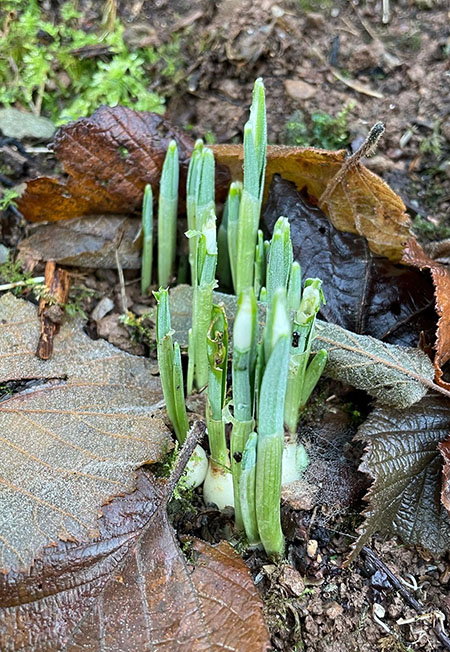 Spring has moved forward over the last few years. A recent study by the Met Office has estimated the growing season is now a month longer than it was between 1961 to 1990, as autumn is delayed and spring is earlier. Records show that the march of spring from south to north was 1.2mph in the 1940s. At the turn of this century it had increased to 1.8mph and now is nearer 2mph.
Spring has moved forward over the last few years. A recent study by the Met Office has estimated the growing season is now a month longer than it was between 1961 to 1990, as autumn is delayed and spring is earlier. Records show that the march of spring from south to north was 1.2mph in the 1940s. At the turn of this century it had increased to 1.8mph and now is nearer 2mph.
We have lost much of our wildlife in recent years. The 2019 State of Nature report says that since 1970 there has been a 13% decline in average abundance of wildlife, with some creatures suffering more than others. There is no doubt that modern agricultural practices have played a large part in this, but so too has the changing climate.
So with this year’s flora appearing so much later can we look forward to spring returning to its original trajectory? Unfortunately what is important is not what happens in an individual year, but trends. It’s easy to be a climate sceptic; I as well as anybody would love to believe it was not real but a storm stirred up by the media. However looking at statistics we can see that the 10 hottest years since records began have all occurred since 2002. We have also seen more extreme weather events, and greater flooding.
There have of course been exceptions throughout history. We had a little ice age between the 17th and 19th centuries, that proved challenging to our ancestors, and a great storm in 1703 that caused thousands of deaths at sea and through collapsing chimneys and falling trees. But freak events do happen. It is the frequency of these events that is important. A graph of the temperatures throughout the ages still shows a fairly small fluctuation in temperature, from -0.5 to 0.5, until the middle of the twentieth century, after which we are presented with a hockey stick effect when suddenly the graph rises quickly upwards.
What can we do? Firstly we really do need to stop burning fossil fuels and reduce our mileage for food, for clothes, for holidays, for white goods, for everything. We need to start using what we already have in the system by buying secondhand and mending. We need to help wildlife in ways we can; planting hedges and building habitat for dormice, reptiles, birds, hedgehogs and hibernating creatures. We need to be mindful that what we are building now is resilience. The genie is out of the pot and we are going to have to be creative in managing it. And manage it we must, for the future of our own survival depends upon it.
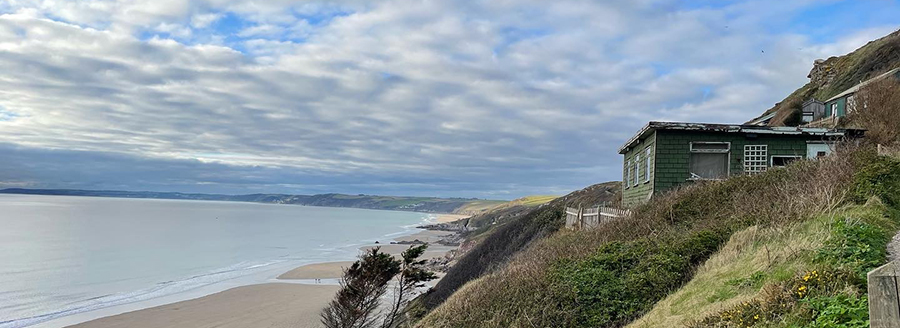
2nd February 2023 - Positivity and Holiday Planning
With January behind us, we are now fully into the new year and looking towards spring. I find this period an interesting one, because I used to dread winter, but in the last few years it has become one of my favourite times of year.
There are two things I attribute to this change in heart, both of equal importance. The first started when I began to see the winter as the period in which to get exciting gardening jobs done. One of these was to create a winter garden, and to fill our woods with snowdrops. I now actively look forward to January, watching the grey green tips splitting through leaf mould, and rejoicing in the bright flowers of hellebores and crocuses, especially when the temperature warms and early bumblebees flit from flower to flower.
The second change was taking up sea swimming. I started one cold November, just over five years ago, when a friend suggested I tried it as a way of dealing with the grief of losing my mother. Cold water has a great way of clearing the mind, offering an outdoors experience that is full of variety and a rush of endorphins that lasts for quite a while afterwards. It also had the added benefit for me of improving what was a fairly rubbish immune system. A few years ago I would have colds lined up one after another, but now get ill far less frequently. Sea swimming does come with a health warning - always go with a friend, never go in when the sea is rough, know the safety of your beach and where there are likely to be currents or rip-tides and at this time of year ten minutes immersion will be enough. Never ever swim after drinking alcohol, and always walk rather than jump into the water to avoid the danger of having a gasp reflex.
If we are to tackle climate change, we need to do it with a strong and positive psyche. For me gardening and swimming have made winter positive. You may find alternatives; use the dark evenings for playing games, writing, art, music, reading or box sets. Try and get out in a social way. Our pub The Eliot Arms does a fortnightly open mic, others do musical jams or quizzes. Music and games evenings are a good way to meet people and reduce the social isolation that winter sometimes brings.
This time of year is also the time we tend to look towards holidays. Tackling climate change means we need to reconsider how we holiday. Flying is damaging to the environment, and often over-tourism can have negative influences, changing the essence of the places we visit. When planning a holiday perhaps we should be asking the question: why?
Why? Why do we want to visit a place? Is it for culture, architecture, nightlife, value for money? Is there a place closer to home that would satisfy just as well? For example could you substitute the rhumba bands of Cuba for the flamenco clubs of Granada, Herez or Seville? Other examples might be swapping the Rocky Mountains for the Pyrenees, New Zealand wine tours for Alsace, skiing in Colorado for the Alps, the indulgences of Dubai for Monaco. The experiences will be different, but they may well be just as good, and perhaps even better or more authentic. If you can, travel overland by train, it is a wonderful way to gain a sense of proportion of how big the world is.
At this time of year we often have a rose tinted view of how a summer holiday will be. With global warming traditional destinations in Southern Europe are now becoming unbearably hot. Holidays earlier and later in the year offer better value for money and may well end up being more enjoyable. Rather than aiming for sun, aim for experiences. In this way you will be less disappointed should the weather fail to please. Search in advance for indoor entertainments, so you have a back-up, and to reduce carbon miles think local to your destination.
Another way you can exert responsibility when travelling is to consider your accommodation choices; B&B, hotels, purpose built lodges or caravans, tents, barn conversions, shepherd’s huts etc. offer an alternative to self-catering cottages, which, as we well know in Cornwall, can strip the heart out of a village by inflating housing prices for local people, which can turn a vibrant community into a winter ghost town.
I have to admit that when we holiday, it is almost always within Cornwall: local holidays can be taken at a whim if the weather is good, and short, frequent holidays, without the stress of a long journey, are a great way of recharging the batteries and keeping money within the Cornish economy.
I was delighted to talk to a Spanish friend recently who has travelled the world in his yacht. He rates the coast of Cornwall as the most beautiful place of all. This sentiment was reinforced on Saturday when I was chatting to a friend about holidays. She commented It is so beautiful where I live, I suddenly realised I was living a holiday, so why would I ever want to go away. She, like me, has discovered the joy of gardening, and immersion in the landscape through walking. If we want to cut our carbon footprint, then excavating the joy there is to be had in everyday life, whatever the season and whatever the weather, is a great place to start.

18th January 2023 - Water, Water, Everywhere
Water, water everywhere, but not a drop to drink. So goes a line in Samuel Taylor Coleridge’s famous poem The Rime of the Ancient Mariner. These words rings too true for comfort today.
Yesterday I travelled from Ludlow back to Cornwall. It was bizarre to see field after flooded field, with the occasional church rising from the mire, gravestones poking through the water like black lily pads. This scenario continued through Shropshire, Hereford and later Somerset where river after river had broken banks and water had spread over the flood plains.
Ironically as I travelled I was reading a rather wonderful book a friend had given me for my birthday, The End We Start From by Megan Hunter, a short poetic novel about flooding. This genre of climate-crisis fiction even has a name - cli-fi and I can’t recommend this novel highly enough - it is thought-provoking, fast moving and beautifully written.
We have had a lot of rain in the last few days. Not yet of biblical proportions, but enough to cause considerable problems. Trains to London had been cancelled from Newport, and I have no doubt that the roads were not much better. Rivers and streams were brown with topsoil, running off fields, stripping them of vital nutrients and filling rivers with toxic nitrates.
One of the problems we face is that the flurry of house building we have seen in recent years inevitably has a knock on effect. Unless very carefully designed, housing estates will inevitably cause flooding downstream because as the ground for the water to soak into is reduced. It then runs off the hard surfaces and overwhelms surface drains. Those houses also need water and are drawing on a system designed for a far smaller populace. Despite the rain, the soil underneath the surface is still surprisingly dry. Hard dry grounds as the result of drought also act like concrete and it can take quite some time for the soil to soften enough to act as a sponge for excess rain.
It is easy to assume that because we have had so much rain, that the problems of last year’s drought is past. However the main reservoir for South East Cornwall, Colliford, was still only 39% full at the last count. Past years have shown a pattern; large rains followed by an extended spring drought, lasting several weeks. Therefore it is still imperative to save water whenever you can.
Try storing excess water in buts in the garden. If you are able to, install a roof capture system that you can use to flush toilets. Shower rather than bath. Keeping the water cooler in your shower will be a good incentive not to stay in too long and save energy too. Set your washing machine to a water-saving setting. In the garden avoid water hungry pots, unless you have a comprehensive system of harvested water to tend them with. In dry spells sprinkle water over the soil before rain is forecast to help prepare it to soak up water.
I have planted a lot of trees over the last few years. I help them conserve water by giving each one a good pile of well rotted wood-chip mulch. Now is a good time to plant trees. Cardboard makes an effective mulch if you do not have access to wood chip.
Finally, I am in the throes of organising an open day for our business, Railholiday, on the 29th January from 12-4pm. So if you would like to see an example of pollinator friendly winter gardens, and have a walk around our woodland to see the newly planted trees and our snowdrop walk, or just have a chat about environmental issues, then come to St Germans station where we are based on Sunday 29th. Wear sturdy shoes and/or bring wellies, and if possible arrive by train as parking is limited. Entrance is free, but there will be the opportunity to buy plants and refreshments. Scholars restaurant just down the road will be open, and they offer a fabulous Sunday carvery. All proceeds from the open day will go to The Cornwall Wildlife Trust, and refreshments will be in aid of local youth groups.
An update on our open day. We raised over £500 for different charities. £370 for local youth groups, £140 for the Cornwall Wildlife Trust and an unknown tally for the St Germans Public Transport Users Group (I didn’t want to prize open the collecting pot!)

4th January 2023 - A New Year
New years always seem to come around very quickly. I am not a great one for making resolutions, as I know I’ll be unlikely to keep them, and setting up for failure never seems a great start to the year.
By this admission, I have to confess like most, I try and avoid failure when I can. Failure however can be a positive thing. William Churchill once said that success is the ability to go from one failure to the next with no loss of enthusiasm. In his book David and Goliath, Malcom Gladwell makes the observation that a common feature of successful people is that at one time they have been told they’ll never be any good. He also observes that success often comes to those who are used to repeatedly failing. The reason; learning to cope with failure leads to a greater willingness to take risks.
I am no stranger to personal failure. As a teenager I managed to fail my grade six, seven and eight piano exams, the later twice. Looking back I can understand the reason for failure; poor preparation, and low self esteem leading to chronic bouts of nerves. I am so glad I didn’t give up!
Despite my run of failures I did get offered a place to study a degree in Music and English. However a last minute loss of confidence led me to change my study instrument to the recorder, an instrument I’d been lucky enough to study to grade eight before teenage anxiety led to exam nerves. In the end this was a very positive outcome; I was able to learn advanced recorder technique from an excellent tutor, who also sorted out my eccentric rhythm. When you play with an accompanist you do need to keep time, which as a solo pianist I hadn’t really bothered about. It also set me up well for teaching. Few things are more pleasurable than passing knowledge on.
I was determined not to let my failures at the piano beat me, and after finishing my degree I took lessons again with my wonderful piano teacher, Gillian Adams. This time I listened to her a bit more, and tackled the core things that had led to my failure. Dealing with nerves led to taking a course in anxiety management, which has been useful in all areas of life. I realised that success means thinking holistically (not just playing three pieces very fast), so I took singing lessons to improve my pitch for the aural tests and even practiced my scales!
Passing my grade eight piano exam with a merit five years after failing it dismally definitely gave me a sense of achievement. I then went on to get an LTCL teaching diploma. This time when I failed the first time (after getting lost in the building and reverting to panic mode during the performance), there was no question but to lick my wounds and try again. My success second time round led to many happy years of teaching the piano and recorder. I now play in a band called Wurlitza. We put live soundtracks to silent films and have done some amazing gigs, including Glastonbury Festival twice. I still feel nervous, but now if I make a slip I am able to put it into context (no-one has died) and keep going. Playing music gives me enormous pleasure.
I used to feel very embarrassed about my failures, but now I recognise that learning to fail is one of the essential tools of life. There will always be people who are better than I am, and usually people who are worse too. That is not important. What is important is the effort, the persistence, the determination, learning to listen to others and being open towards ways to improve.
This is a very longwinded way of explaining that when it comes to greening your lifestyle there will be times when you fail. There will be times when you feel it is all too much, that success is impossible. You will find yourself comparing yourself to others, and concluding that you cannot reach the mark, or on the other side of the coin, if they don’t do it, why should you? Do not despair. It is worthwhile. All the steps we make towards tackling climate change, whether it be travelling less, shopping locally, reducing plastic, joining a campaign group, eating less meat, planting trees or gardening for wildlife will all help in the long run. Keep trying. As it is true that Rome wasn’t built in a day, so we must accept tackling climate change is a long slog.
And good luck! May 2023 be a year of productive failures and satisfying successes. And perhaps I will make a resolution after all - to stay positive and use adversity wisely.
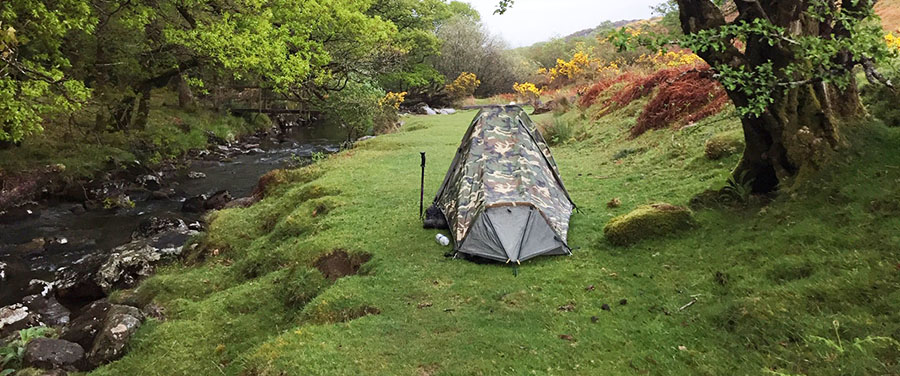
19th December 2022 - On Wild Camping
Did you know that Dartmoor is the only place in the UK where it is legally permitted to wild camp? I did not until it was drawn to my attention that this right is currently being challenged by one of the park’s landowners. This particular landowner is the sixth largest in the Dartmoor, and there are fears that if he is successful, that other landowners will follow suit.
I can understand the importance of protecting nature, and can understand the importance of rules to protect our wild places, and can see how the inconsiderate behaviour of a few might jeopardise the rights of the majority. During lockdown there were cases of people driving to Dartmoor and leaving a mess, but these instances hit the news because they were exceptional, and not the rule.
There are plenty of effective measures that could be put into place to stop antisocial behaviour. I believe an on-the-spot fine for littering of £100 would be effective; this is something that, as a seasoned litter picker, I have felt for a while. Similarly instant fines for lighting fires could be instigated. Clearer guidance could be made on the importance of sticking to paths. Temporary signage could indicate where not to go during nesting season.
Generations of school children have enjoyed Ten Tors. Local schools do their Duke of Edinburgh’s camp on Dartmoor. Dave’s favourite pastime is to catch the train to Ivybridge with his tiny one man tent and strike off into the unknown. He comes back refreshed and reconnected after a night under the stars.
Most importantly camping, and walking, on the moors is free. This is an activity that has no class boundaries, that is available to all. Too many things in life require payment; walking on the moors only offers payment back - fresh air, well being, and wide open spaces to put our own small lives into perspective.
We need more than ever to reconnect with our wild spaces and our dark skies. If we have not thoroughly experienced them, then why would we fight for them? And fight for them we must if we are to survive the climate crisis. Wild spaces are carbon sinks and a place where our ecology can repair itself, a haven for wildlife and recovering species. For humans they are an outdoor gym, and therapy. In our busy lives we rarely have time to take stock and truly breathe.
There is plenty of sensible advice around for making Christmas more eco friendly, most of which will be too late to be useful by the time this column is printed. I am sure you already know to just buy the food you are likely to eat, and to freeze leftovers quickly to reduce waste. Iam sure you will already save wrapping paper to use throughout the year, and box up your decorations for re-use next year. So this year I am just going to make just one plea. During the festive season get outside. Walk on the moors, in the woods, fields, or by the sea, whatever is on your doorstep. Wrap up warm and allow yourself to be immersed in nature. Listen to the sounds around. Look closely at the base of trees for signs of small mammals and insects. Stretch your legs and explore. And have a really happy, healthy Christmas.
For more on public access, visit the Right to Roam Website, and for further reading try The Book Of Trespass by Nick Hayes.

5th December 2022 - On the Knowledge of Elders
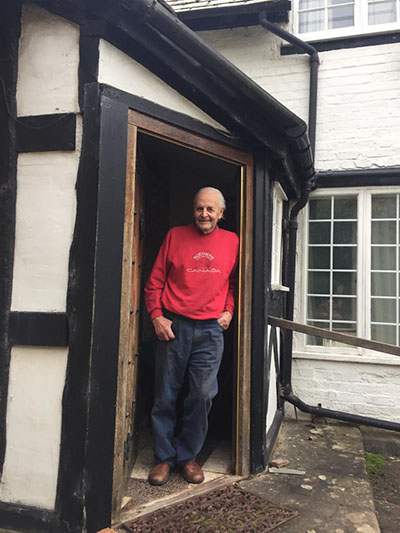 Over the last few years I have been assisting my great uncle John in writing his autobiography. It is finally complete, and over the weekend I will have travelled to Leominster to present it to him as a gift for his 97th birthday.
Over the last few years I have been assisting my great uncle John in writing his autobiography. It is finally complete, and over the weekend I will have travelled to Leominster to present it to him as a gift for his 97th birthday.
The timescale for getting the book together in the end was tight, but as usual our local businesses rallied together to make sure it was done. I had a small run of six copies printed, in advance of a larger run of 100 in the new year. Chris at Print Options in Millbrook dropped everything to push the job through quickly, and then our friend Tom O’ Reilly hand sewed and bound each copy in leather, with a beautiful handmade slipcase. I feel very proud of the finished work, and know he will too.
The process of editing the book has brought me closer to my great uncle. He had written a rough draft, to which we added stories recorded over many months. My great uncle’s family farm was at Biggin Hill, and bordered the airfield. His story begins with traditional farming; the land was worked with horses and large numbers of workmen. His father had a dairy round, so they also made dairy products and kept chickens. During the winter the farm workers would spend four months hedge laying, and all winter feed for the animals was grown on the farm.
The war years were extraordinary times and John’s tales of supplying the airforce with provisions and working as a volunteer fireman (he was too young to serve) are fascinating. On a personal level I find this period of his life very moving as my Grannie was a red cross worker at the Biggin Hill airfield and my grandfather was a war photographer, also based at Biggin Hill.
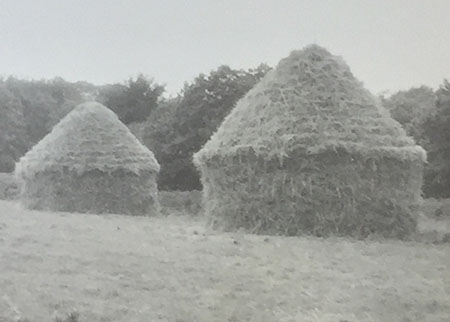 Pre-war farmers understood the importance of healthy soil. The earliest farm leases make cultivation of any previously uncultivated land a serious offence with a hefty fine. After the war, in their drive to feed the nation, the government’s agricultural committee insisted on far more cultivation. This insistence came at a price; because the land at Biggin Hill was unsuitable for cultivation more fertiliser had to be used, and tractors ordered from America, leading to the industrialisation of the countryside.
Pre-war farmers understood the importance of healthy soil. The earliest farm leases make cultivation of any previously uncultivated land a serious offence with a hefty fine. After the war, in their drive to feed the nation, the government’s agricultural committee insisted on far more cultivation. This insistence came at a price; because the land at Biggin Hill was unsuitable for cultivation more fertiliser had to be used, and tractors ordered from America, leading to the industrialisation of the countryside.
The post-war agricultural policy set the pattern for what has now become the farming norm; a disregard for soil health, an increasing reliance on fossil fuel based fertilisers, an expansion of fields for larger and larger machinery, the planting of swathes of mono crops, hedge flaying rather than laying, and feeding livestock on imported food.
Part of the problem is that we now consider modern farming methods as traditional, in the same way that we accept that things we buy won’t last, or that supermarkets are the normal way to shop. A dysfunction in the cost of housing has meant we have needed to earn more and more money just to have shelter, stripping our lives of the time needed to do things in a slower and more mindful way.
My great uncle’s generation have so much to impart. He still grows and cooks his own food, makes preserves, bakes cakes and mends things that break down. He is lucky that his genetics have kept him healthy for so long. But logically I know even his life will be finite.
Spending time with our elders is a privilege that won’t last forever. When we were younger we were drilled with the importance of respect for the old. They have knowledge and experience. They know how to survive without the trappings of modern life, and we need now to draw on their knowledge to create our own way forward; how to cultivate, to darn, to mend, to store, to ration.
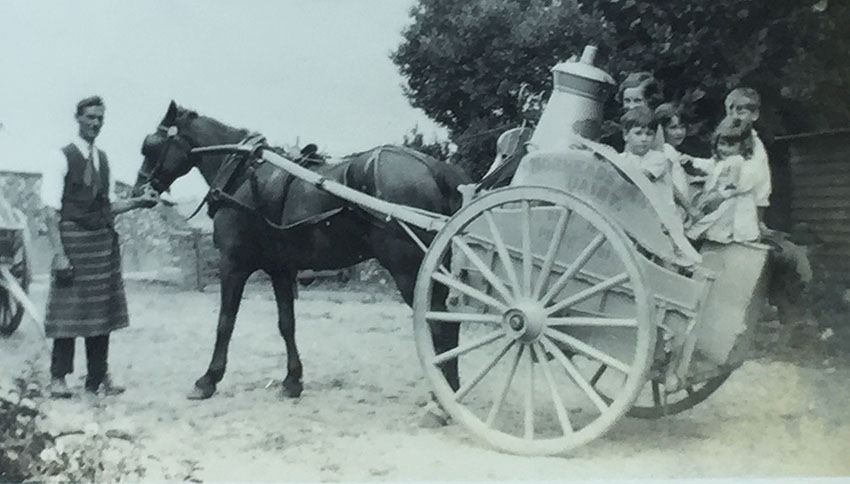
Older people love to tell their stories. Loneliness is often one of the greatest burdens of age. Over this Christmas period, and into the new year, take time to visit someone elderly and listen. Record them if you can. If you don’t have an elderly neighbour or relative, you could volunteer with Age Uk, who offer opportunities to connect with people who need a friend. If you have children or grandchildren, encourage them to connect too, as time with elderly friends is precious and ultimately fleeting.
Your time, and their tales, may well end up being the most cherished gifts of the festive season. And if you can impart some of their experiences to the next generation, then they may well be the gifts that last longest of all.
23rd November 2022 - From Rainforests to Municipal Trees
It seems there are few piece of good news these days; it is hard to stay positive. However one good piece of news on a global scale was the election of Lula as president of Brazil. His predecessor, Bolsonaro, caused damage to the rainforest of eyewatering proportions, but Lula has pledged to turn things around.
Lula was greeted like a rockstar when he made his speech at Cop 27. There is no climate security for the world without a protected Amazon he said. We will spare no efforts to have zero deforestation by 2030.
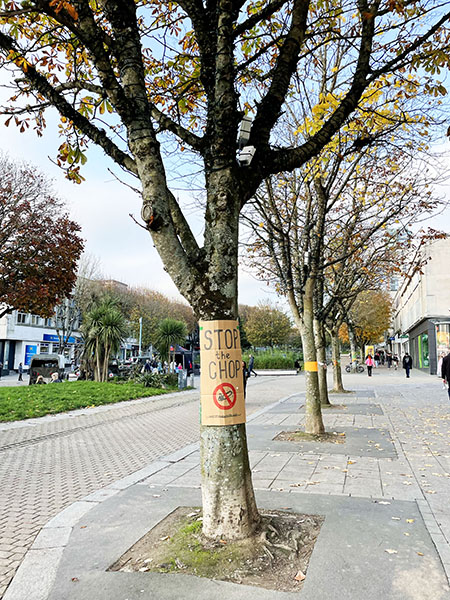 Lula also slammed global leaders for failing to prioritise climate change, saying they had ignored warnings about the plight of the planet while spending trillions of dollars on war. The planet is at every moment alerting us that we need one another to survive, he said.
Lula also slammed global leaders for failing to prioritise climate change, saying they had ignored warnings about the plight of the planet while spending trillions of dollars on war. The planet is at every moment alerting us that we need one another to survive, he said.
This is such a powerful message - to effectively move forward to tackle climate change we need to do so in the spirit of collaboration, humanity and respect.
Lula’s victory is such good news. Will other nations follow the lead of Brazil? I think at the moment there is still a long way to go, but I really do hope so.
A few weeks ago I wrote of the importance of trees, with particular emphasis on adopting and loving our local trees. We are right to condemn the loss of rainforests, yet we still have our own ecological disasters on our doorstep. HS2 has been a prime example of the disregard our civil servants have for ancient woodland and we are still rapidly losing countryside to roads and houses.
Closer to home a travesty is going on. As part of their £12.7 million development plan Plymouth City Council are going to cut down all the mature trees in the city centre. These mature trees all have decades of life left in them.
I remember Plymouth before these trees were planted, and it was a barren and bleak place. The trees in the centre of Plymouth have transformed the feel of the city, and provide a valuable wildlife habitat, as well as improving air quality. A quote on the website says These trees are the green lungs of our city. That is so true.
If you are as horrified as I am about this, then do write to Plymouth City Council and let them know how you feel. For more information have a look at the Save the Trees of Amarda Way (STRAW) website.
If you have not been to Plymouth for a while and are not sure of where these trees are, then do take a trip. I visited last weekend, and the boulevards were a riot of autumn colour; the city looked vibrant, healthy and alive.
Lula’s election victory is amazing. His power for good is enormous, and a restoration of the rainforest would be the most fabulous thing to happen in our lifetimes. But any kind of ecological growth takes time. Far better to preserve and not lose, than to lose and have to start again. I am hoping the next piece of good news will be that Plymouth City Council have seen the light, and we will be able to enjoy the city centre trees for many years to come.
Update. On the night of the 15th March 2023, Plymouth City Council destroyed the trees of Amarda Way. A travesty, and what will probably be a home goal in terms of attracting tourists, as Plymouth’s leafy avenue is no more. A very sad outcome.
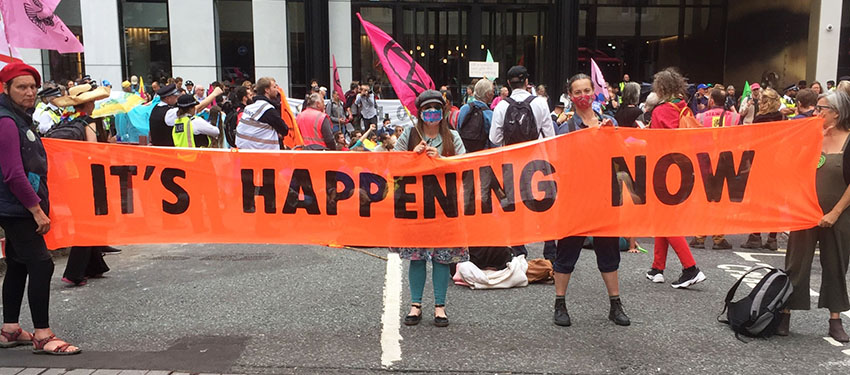
9th November 2022 - On Peaceful Protest
Sometimes it’s hard not to get political. Some of the most important tools of tackling climate change are political. Some of these are on a local level, others national and international.
I am a great believer in fixing at source, and not worrying too much about what we cannot control. So while we can fund charities such as Railway Children, or UNICEF that improve the lot of children worldwide, there is a limit to what we can do to influence other nations. However we are still in a position to influence our own.
A worrying feature of politics of most nations in the last few years has been a radical shift to the right. Too-far right and too-far left are always dangerous places to be, and the outcomes are often similar; dictatorship, loss of trust, racism and a police state. In the UK we have seen an increase in tightening of laws to make protest more difficult.
I am not going to deny that some of the protests in the last few years have not caused inconvenience. Of course they have; they would probably not be effective if they did not. However when placed in context of the inconvenience we are likely to suffer as the world warms, with increased flooding, drought, wildfires, wars and more extreme weather events these inconveniences really are very mild.
We have never needed to protest more. A few months ago (as my poet alter-ego Lizzy Lister) I wrote a poem entitled Too Many Things Are Broken. I was feeing very keenly that although we know things are wrong, our government and industry leaders are still not acting. This has been highlighted this week by the horrific tales of the way our asylum seekers are treated. We need to restore humanity and work out a way of humanely moving forward, because mass migration is going to be one of the stories of climate change.
Another announcement this week was the news that the oil industry has made record profits, despite the cost of living crisis that will continue to hit hard as the weather gets colder. We need to stop using oil and paying into the pockets of profit driven companies, but we need government action to make this happen. They can do this.
Our government has the ability to insist all new-builds have solar panels on the roof and are super insulated. They can make public transport more affordable and tax flying, so that sustainable methods of transport are more competitive. They can ensure well-insulated social housing is available for local families so people can remain within their communities and reduce the need to commute. They can introduce a carbon tax so sustainable options become more attractive, or support community energy initiatives. However our MPs are not choosing to listen to the climate science, so protest is the only option left.
I have just started reading Greta Thunberg’s new publication, The Climate Book, which is a compilation of essays by experts on climate change. Greta writes in a clear and concise way. I found myself nodding when she says This is, after all, the age of communication, where what you say can easily outweigh what you do. She is absolutely right. Sharing things on social media is not the same as action. We need to take to the streets to let our government know we are not satisfied with the status quo.
Getting involved with peaceful protest, or supporting others in doing so, can be very cathartic. It is a great way of meeting new friends too. There are many groups who would love to have your involvement. While XR (Extinction Rebellion) is an umbrella organisation for peaceful climate change protest, there are other organisations, including Saltash Environment Action Group (SEA) who offer group meetings and an opportunity to meet other people who feel passionately about the need to act.
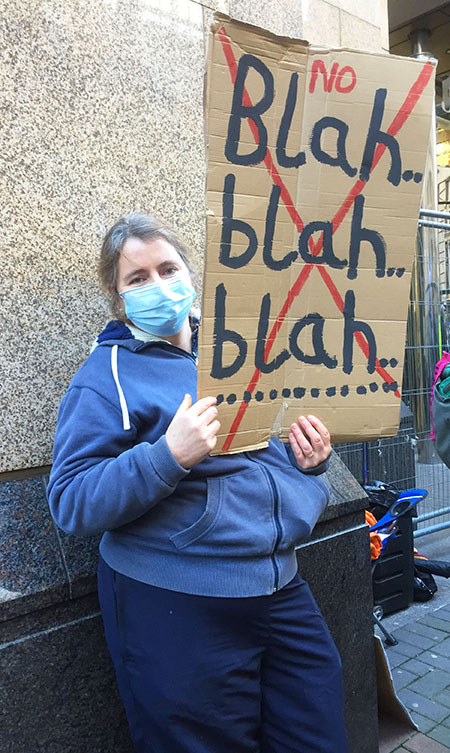 Protest doesn’t have to involve sitting in a road - you could be letter writing, talking to people on the phone, talking part in a procession, joining a samba band, or supporting people who have been arrested. I can tell you from experience that few things are more welcome than a sandwich and a friendly face after several hours in a police cell!
Protest doesn’t have to involve sitting in a road - you could be letter writing, talking to people on the phone, talking part in a procession, joining a samba band, or supporting people who have been arrested. I can tell you from experience that few things are more welcome than a sandwich and a friendly face after several hours in a police cell!
We must not allow government laws to silence our right to peaceful protest. If we do, we lose the freedom of speech that we have always been so proud of. Protest is one thing is available to us all - it doesn’t cost money, but it might, one day, be the thing that our descendants thank us for.
Too many things are broken
Why are we silent? Why not be outspoken?
Is it wrong to speak truths? To fear? To rage?
Too many things are broken.
Financiers rule. Transport timetables run amok.
Food and shelter are unaffordable for a living wage
Why are we silent? Why not be outspoken
when ambulances queue for 23 hours? A token
pay rise won’t suture a staff haemorrhage,
too many things are broken.
Forests on fire as Europe chokes.
Even the weatherman says climate change.
Why are we silent? Why not be outspoken?
Pandemics. War. In Ukraine plumes of smoke
mark bombed fields of wasted grain.
Too many things are broken -
why are we silent? Why not be outspoken?
Too many things are broken.
Lizzy Lister
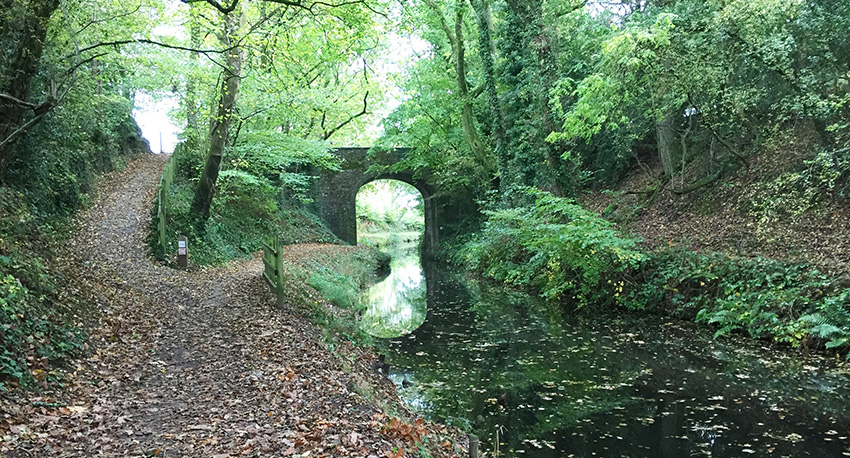
26th October 2022 - Observations from a bicycle saddle
I have just returned from a thoroughly enjoyable holiday; three days cycling around Gloucester and Wales with my husband Dave. There is currently a direct train from Cornwall to Gloucester in the evenings, and on our return we were able to catch a direct train from Newport. The Intercity 125s used by GWR for their stopper services are suited for travelling with bikes, as they have a dedicated bike area, although I have to admit we both felt a bit nervous about relying on bike space on the last train home from Newport!
Journeying away from home and seeing how things are done elsewhere is often useful. Around Gloucester, and later Hereford, much effort has been made to create safe passages for cyclists. By using infrastructure that is already there; tow paths, riverside paths, tiny lanes, it was possible to confidently cycle and still feel safe. As a result there were a lots of others out and about on foot and wheels. We are not always very good at holistic thinking, but it struck me that the cost of cycle and footpath infrastructure could probably be balanced by savings in the NHS, as promoting healthy ways of travel and access to outdoor exercise will inevitably lead to a healthier population who need less medical care for both physical and mental health. And wealthier for not having to pay for fuel or gym membership.
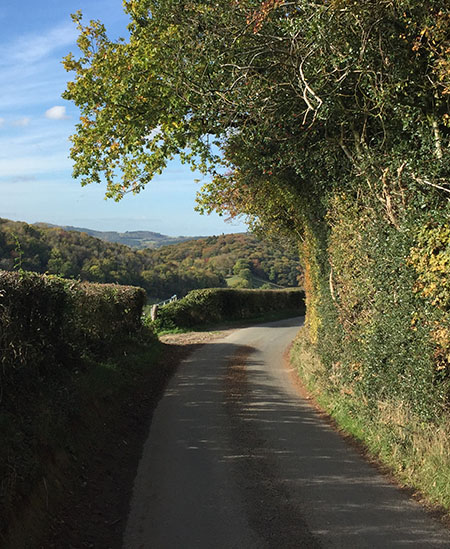 Cycling offers a fast enough pace to cover ground, but slow enough to observe. The countryside around Gloucester is wealthy, but terribly neat. Hedges have been clipped short even when they are set back from the roads, or simply dividing fields. Neatness is often not the best solution for nature, which likes wild and messy; cutting hedges short at this time of year means a loss of haws, nuts, berries and hips, all of which are valuable bird food. There is also the loss of habitat too, as birds need shrubby places to shelter. It is time to celebrate the wild, and to find beauty in unkempt hedges.
Cycling offers a fast enough pace to cover ground, but slow enough to observe. The countryside around Gloucester is wealthy, but terribly neat. Hedges have been clipped short even when they are set back from the roads, or simply dividing fields. Neatness is often not the best solution for nature, which likes wild and messy; cutting hedges short at this time of year means a loss of haws, nuts, berries and hips, all of which are valuable bird food. There is also the loss of habitat too, as birds need shrubby places to shelter. It is time to celebrate the wild, and to find beauty in unkempt hedges.
The ride also reminded me of how lucky we are in Cornwall to have strong communities, and I do hope this is something we can hang on to - quite a challenge when villages succumb to second-home ownership. From Gloucester we cycled for forty miles, through several small villages, without seeing a single village shop or an open pub. Luckily we had emergency provisions and were able to pick up roadside apples along the way, but it did make me think. Self sufficient communities are resilient ones - a village store and pub will negate the need for longer journeys to spend money in supermarkets where the profit is taken out of the community. We need to support our village stores, otherwise we do risk losing them.
Part of our purpose was to visit my extraordinary great uncle, a 96yr old farmer who is writing his autobiography. As we neared his home village of Hope-Under-Dinmore all the lovely small lanes and cycle paths vanished, and for seven miles we battled to survive on A roads that clearly had no provision at all for cyclists or walkers. It was not an experience I would readily repeat.
In South East Cornwall we have a similar problem - there are very few cycle lanes and busy roads can be hard to avoid. Often what is needed is not a big scheme, but a small one; a 100m footpath to join lanes, or a safe crossing. I often use the footpath by the A38 that joins Tideford to the back lane towards Lantallack. A cycleway between Crafthole and Tregantle would make the world of difference to the safety of cyclists wanting to access the cliff road. Money is always short, but what we need most is not new roads, but safer ways of green travel.
Travelling is always an eye-opener. We don’t need expensive and carbon-costly journeys to far-away places to have a good time, we just need a change of scene; a time to get away from the normal and reflect on what we have, and ways in which we can improve and preserve the status quo.
8th October 2022 - On Passing the Buck
I am having one of those days where I would love to flick a switch and have everything sorted for me; the climate crisis solved, the cost of living crisis a distant memory. Sadly life is not like this, but sometimes we like to pretend it is. This often ends up with passing the buck, rather than accepting responsibility head-on.
Our plastic recycling is a good case in point. I am pleased to see an increase in recycled plastic goods; outside tables and chairs, bottles, children’s playground surfaces, even roads. However we still have a long way to go before we recycle everything, and what we do not recycle will inevitably be placed on a ship and taken away from the UK where it will be out of sight and out of mind.
The problem is that while very little of the UK’s waste plastic ends up in water courses in the UK, when it is sent to countries like Malaysia, Indonesia or Bangladesh much of what is shipped does end up polluting rivers and seas, which causes a crisis worldwide, as well as a horrific problem locally. Once this is taken into account, then sending plastic to landfill is better for the environment, which is contrary to the message we are given. It is another good reason for reducing plastic use as much as possible. Metal recycling however is definitely a good idea, so should be done wherever possible.
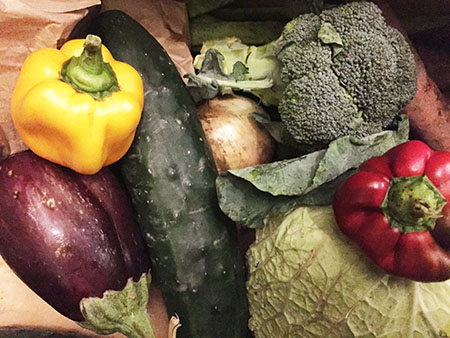 So how can we reduce our plastic? It is not easy if you shop in a supermarket, but being plastic aware is a good first step. Have a look at your weekly shop. What is the biggest source of plastic? If you buy ready-meals, could you learn some simple cookery? Can you subscribe to a veg box? We have ours from Keveral Community of Growers; the veg is organic, and comes with almost no plastic packaging, the only exception being summer salads. Avoid out of season salad items from Spain, which are grown hydroponically in poly-tunnels that end their lives in rivers and ultimately the sea.
So how can we reduce our plastic? It is not easy if you shop in a supermarket, but being plastic aware is a good first step. Have a look at your weekly shop. What is the biggest source of plastic? If you buy ready-meals, could you learn some simple cookery? Can you subscribe to a veg box? We have ours from Keveral Community of Growers; the veg is organic, and comes with almost no plastic packaging, the only exception being summer salads. Avoid out of season salad items from Spain, which are grown hydroponically in poly-tunnels that end their lives in rivers and ultimately the sea.
Another place we pass the buck on is emissions. We are very good at shouting about our country’s reduction in emissions, but that is simply because we have, over the last few decades, closed down our industries. It is less expensive to import from countries like China where labour is so much cheaper. However this is a false economy; by buying goods from abroad we simply move our emissions to countries that might turn a blind eye to pollution laws, and once the carbon cost of moving goods is also taken into account the problem of emissions is much worse than it would be, were we to reinstate our home industries.
Again the same adage stands: reduce wherever possible and reuse by buying secondhand. Try and keep everything as local as possible, from sourcing materials, to disposing of them at the end of their lives. Community pages where you can pass on unwanted goods are a great way of creating a circular economy. To be sustainable we need to find local solutions to worldwide problems, which means the buck stops with us.
28th September 2022 - Adopt a Tree
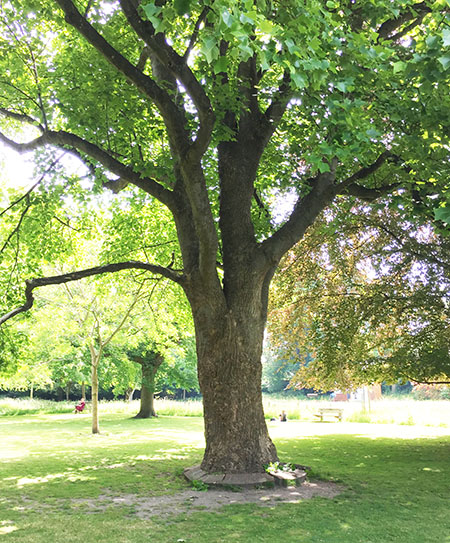 Trees are amazing. They breathe in carbon dioxide, and give us oxygen in return. They provide shade in hot weather, and shelter in wet. What is there not to love about a tree? But how often do we really stop and observe, and appreciate them?
Trees are amazing. They breathe in carbon dioxide, and give us oxygen in return. They provide shade in hot weather, and shelter in wet. What is there not to love about a tree? But how often do we really stop and observe, and appreciate them?
All trees host a variety of life, from insects, to birds, small mammals, ferns, mosses and lichens. Some will be specialists; they may not support a wide range of species, but for those they do they are essential. Others, like the oak, are superheroes, hosting a massive 342 different species of invertebrate, and offering 600 years of wildlife value - 200 growing, 200 at maturity, and 200 as it slowly dies and provides habitat rich deadwood. The ivy that trees support also is a wildlife superhero, with flowers offering late pollen and nectar to the ivy bee, which has designed its life cycle around the ivy flowering period, and for many other pollinators. Later ivy seeds are valuable winter feed for birds.
Sadly many of our trees are sick; the pathogen phytophthora ramorum has destroyed larch plantations and many fine conifers, and ash die-back is now so prevalent there will soon be very little ash left in our hedges and woods. Droughts and other extreme weather events bought on by climate change are putting stress on our trees. So how do we connect more with trees? What can we do to protect them?
A friend had an inspired suggestion that if every person were to informally adopt a tree or two, this would be wonderfully beneficial. There would be no need to own this tree. Simply chose a tree near to where you live, in a park or a hedge, and start to observe what you see. Get up close. At this time of year you may find abandoned nests. Where wood has been damaged can you see insects? What visits the tree? What is growing on it?
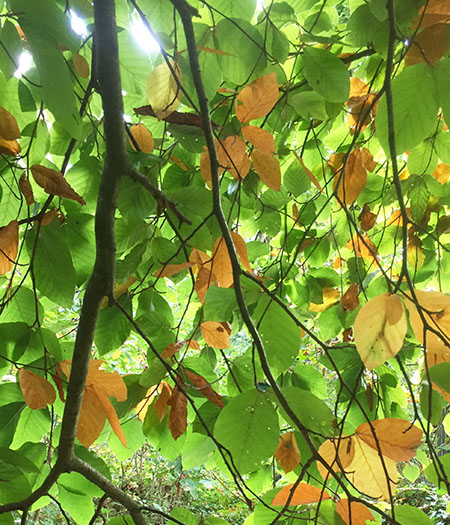 Spend some time with your tree. Draw small details, or write a bit of poetry or prose. With all art forms it doesn’t matter if it is good or not - it’s about the doing and the creativity that provides connectivity. If your tree is a young sapling you could keep an eye for drought stress and give it a bucket of water every once in a while. For an older tree, become its protector. Moving forward preserving what we have is an enormously important factor in tackling climate change.
Spend some time with your tree. Draw small details, or write a bit of poetry or prose. With all art forms it doesn’t matter if it is good or not - it’s about the doing and the creativity that provides connectivity. If your tree is a young sapling you could keep an eye for drought stress and give it a bucket of water every once in a while. For an older tree, become its protector. Moving forward preserving what we have is an enormously important factor in tackling climate change.
Of all the fruit trees, the apple has the greatest wildlife benefit. If you do not have an apple tree in your garden, but have space, do think about planting one this winter. Now is also a good time to order bare rooted hedge plants.
So pick a tree and adopt it this winter. Watch it as the seasons change. Make a note of when the leaves come out, and when the last ones drop. How many species of flora and fauna does it support? When does it flower? A healthy tree is a gift that keeps on giving, and getting to know one really well is a pleasure that is readily accessible to all.
Here are a few of my favourite tree facts:
- Many trees trees are monoecious. This means they have both male and female parts on the same tree. The hazel is a good example. Look in spring for tiny red female flowers along the stem, that will be wind pollinated by the male golden yellow catkins.
- Historically the elder was known as the mother tree. Every part of the elder has beneficial medicinal qualities.
- Sweet Chestnuts were introduced into the UK by the Romans, who used their fruit to make flour.
- The holm oak is named after the ancient word for holly, on account of its evergreen leaves.
- The Fortingall Yew in Perthshire is the oldest living tree in the UK, believed to be between 2000-3000 years old. Locally, in Dartington there is a yew that is over 1500 years old.
14th September 2022 - Autumn Abundance
Frugality is a tool for saving the planet. By learning tradition ways from our ancestors we can reduce our economic spend. At this time of year, that means harvesting and preparing perishable fruit and vegetables in anticipation of the hungry gap early next year.
I love foraging and eating food for free. With this hot dry summer fruit has ripened earlier, and many apples are ready for picking. Blackberries should be harvested as soon as possible as they are rapidly going over. It often amazes me that during the hot sunny days, when trees are losing leaves early and saplings die for lack of water, blackberries still produce large juicy fruit.
Blackberries freeze well, but if, like me, you are wanting to move away from needing freezer space, they can either be turned into jam, with the sugar acting as a preservative, or bottled and pasteurised.

When carefully stored, apples can last until April. However not all apples will. Early sweet apples, such as Pig’s Nose and Discovery, are not usually keepers. Mid to late season apples like Cornish Aromatic, Bramleys and Pippins will store well. You do not need to know the names of the apples, just their qualities. If they are sweet and fluffy, the chances are they will quickly spoil. If they are hard and sharp they will probably keep. Experiment this year by boxing up different varieties and checking them regularly, and it will quickly become apparent which are eaters.
Apples should be stored in a cool space in cardboard, with paper between layers to separate the fruit. Once one apple goes bad it will quickly turn the others, but by spacing out your fruit and dividing the layers the damage can be mitigated. Never store bruised or maggot damaged apples as they will rot and cause problems with the rest of the crop. Damaged apples can be cooked, then frozen or bottled. I like to turn them into chutney with the addition of sugar, onions, spices and cider vinegar, plus any other vegetables that need using up.
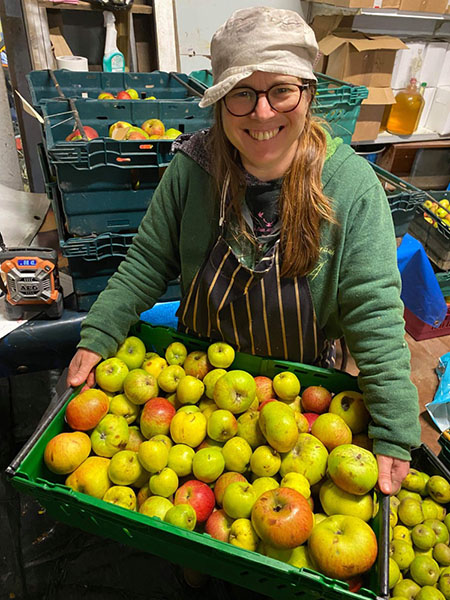 If you have a glut of apples you cannot use, why not offer them up to the community? A box outside the door with a help yourself sign will often be much appreciated. There is a Cornish business called Wasted Apple, who will collect your unwanted apples and give you apple juice or cider in return - a win-win all round. Alternatively you may wish to donate your apples to the Cornwall Gleaning Network, who will redistribute the fruit to community kitchens and food boxes - visit . The Cornwall Gleaning network are always looking for volunteers. There are few better ways to while away a sunny autumn afternoon than picking apples in a beautiful orchard with new friends.
If you have a glut of apples you cannot use, why not offer them up to the community? A box outside the door with a help yourself sign will often be much appreciated. There is a Cornish business called Wasted Apple, who will collect your unwanted apples and give you apple juice or cider in return - a win-win all round. Alternatively you may wish to donate your apples to the Cornwall Gleaning Network, who will redistribute the fruit to community kitchens and food boxes - visit . The Cornwall Gleaning network are always looking for volunteers. There are few better ways to while away a sunny autumn afternoon than picking apples in a beautiful orchard with new friends.
Fruit trees, and particularly apple trees, make excellent habitat for a wide variety of wildlife. Now is a good time to consider getting one, as they are best planted bare-rooted, between November and March. 25 years ago my parents planted two apple tree orchards, using only traditional Cornish varieties, which are suited to our climate. My personal favourites are Cornish Aromatic, a delicious mid-late season eater, and Tommy Knight, another late season eating apple that is also excellent for making cider. Both keep well. Tommy Knight produces small apples just the right size for a child’s packed lunch, while Cornish Aromatic will hold onto its apples on the tree until well into the spring, making it a popular food for blackbirds. Ben’s Red is a good early-mid season eating apple, but is not a keeper, while King Baird produces massive fruit; tart, but perfect for pies.
Winter lettuces, onions, radishes and other hardy vegetables can also be planted now. If you have a vegetable patch, or are thinking of cultivating one, give some thought to crop rotation, to ensure the soil gets the nutrients it needs. Always use organic methods of gardening. Any loss of crop is more than made up for by the pleasure of seeing a garden full of life, and the food you produce will be much healthier for it.
This joy of the harvesting is wonderful, and life enriching. This year, if you can, try and harvest something, even if it is only a few cups of blackberries. And in doing so we connect with a tradition that has gone back for millennia. It is true that simple pleasures are often the best.
31st August 2022 - Secondhand September
As humans we are creatures of habit. Routine helps us to shape our daily life. So when we are forced to change we naturally resist. Unfortunately we know that in order to make meaningful progress in tackling climate change, a new way of life is needed, which means the breaking of old habits and routines.
It is much easier to commit to trying a new thing if it is temporary change. So you can try for a while to see if it works. This is why schemes such as Veganuary and Movember are popular, and why, despite not being a churchgoer, I like to commit to giving something up over lent.
This September Oxfam are spearheading a campaign called Secondhand September. The concept is simple - do not buy new in September, but make do with what you have and buy secondhand when you need to.
Given that a sizeable percentage of our emissions come from things we buy, and there is a continual problem with how to deal with waste, then committing to buy secondhand makes perfect sense. It really is amazing what you can get, and now with the internet it has never been easier. Try Gum Tree for local large goods, like fridges or washing machines, charity shops or eBay for clothes and smaller items and car boots for everything in between, from bric a brac to small items of furniture.
A friend recently commented that car boots are a wonderful because they are so much about human contact, and can throw up the most wonderful surprises. Locally there is a weather-permitting car boot sale at St Mellion on Saturdays and Sundays at the civilised start time of 11.30am for sellers, with gates opening at 1pm for buyers.
Like car boot sales, one of the pleasures of secondhand shopping along the high street is that it is a social event, and social interactions have never been more important. If you have time to spare, volunteering in a charity shop can be fun. And as more people may be shopping for secondhand goods, it could be the perfect opportunity to have a clear out, and donate your unwanted goods to a good cause.
Buying secondhand should save you money. And with the new fuel tariffs we are going to need every penny. Our personal electricity tariff has gone up 300% over the last year, which over winter will be painful. Now is the time to consider how efficiently you use electric. Do you switch off the heating when you are not in the house? Could you wear an additional jumper, or use a hot water bottle and extra blankets at night? Simple things like reducing the number of showers you take, only washing hands in cold water, keeping a flask by your kettle to save any excess hot water, turning computers and TVs off at the wall rather than leaving them on standby will all shave a little off your bill and be good for the planet.
Insulating the house well is also important. There are grants, the main government one being the Energy Company Obligation grant (ECO), which promises to assist those on low incomes with the cost of insulating houses. Cornwall Council has a comprehensive page about this and other grants available. For more information visit: Cornwall Council Grants Page. Do be very wary of anything you may find on the internet that does not come from a completely reliable source. There are a lot of scammers out there and it is easy to become caught out.
A stuffed draught excluder or thicker curtains might help if you live in an old house. No need to buy new - an old curtain or duvet rolled into a tube will do the job, albeit in a slightly eccentric way.
To be self sustaining we need to learn traditional mending skills. A draught excluder is the perfect first sewing project, that even I, who was firmly advised not to take up needlework at GCSE, can manage. Take an old curtain. Cut to about the right length for your door, allowing for seams at the end, and about 30cm wide. Fold in half lengthways with the back of the material uppermost (so the pattern is on the inside) and sew along one end and the long side to make a tube. Turn out so the inside is now the outside. Stuff with whatever material you have to hand - old clothes will do. Sew up the end. Job done! And draught excluders make great Christmas presents too.
There are some things, like electricity and fuel, that we cannot buy second hand, but there are plenty of things that we can. So save money with Secondhand September, get mending and making, and hopefully you’ll also have fun along the way.
18th August 2022 - Drought. The New Normal?
I am very much hoping that by the time this article is published we will have had some much needed rain. I have to confess that I have found the high temperatures and extended drought troubling. Even if we do have rain, keep saving your water and reduce consumption as much as possible, as it will be a long time before our reservoirs recover. And it was also save money!
With climate change we can expect more extremes: periods of drought, followed by periods of heavy rain. Warm air can hold more water than cold, so as temperatures change, then we can expect greater deluges of rain. This can cause our sewage infrastructure to suffer. Because dry soil is unable to absorb moisture, ground water run-off can overwhelm drains, leading to pollution incidents as sewage enters our rivers.
We can help to avoid this by making sure our drains are kept clear of potential sewage-pipe cloggers. Never flush wet wipes, sanitary products, condoms or cotton buds down the toilet. Flushable wipes are not as sewage friendly as the manufactures advertise and should be avoided. Grease is a problem; keep a pot with some newspaper in it beside your sink and pour any waste oil or pan fat into it. This can be then thrown into the bin. Fat is a big problem down drains, and when combined with other detritus can cause fatbergs, that completely clog the system.
We cannot control the water that comes from the sky, but we can control how we store it. As individuals we can collect roof water run-off water in butts, but for large scale storage we need an engineer. And nature has provided one in the beaver. While we have struggled with our water tables falling, owners of beavers have reported that their ponds are thriving.
Beavers need deep water to escape predators, and to slow fast flowing water, as it can drown their young. In headwaters they work magic, capturing and storing water. A side product of this is ecological growth, because water equates life; not only do we need water to survive, but water hosts algae, which feeds insects, which in turn feed bats, birds, and mammals. If we are to be serious about tackling climate change, a rapid reintroduction of beavers needs to be top of the list.
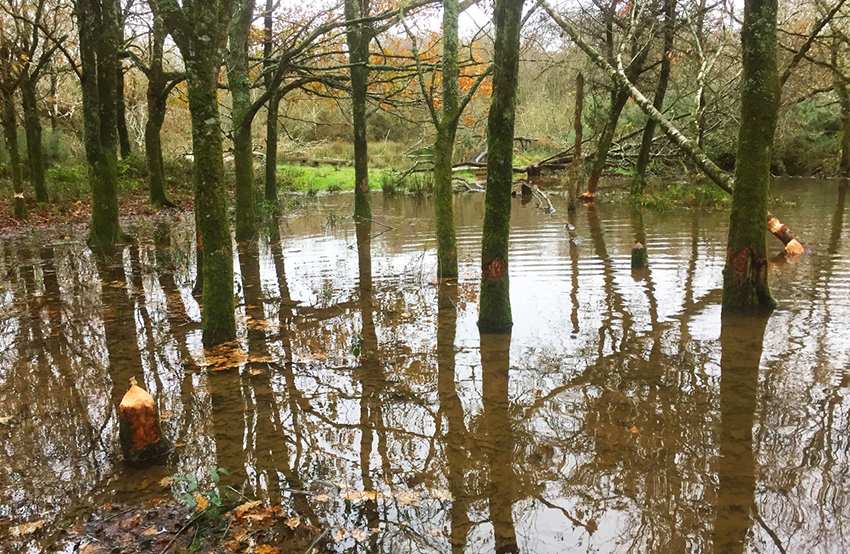
One of the reasons this dry summer has troubled me is that it feels like a portent of things to come. Having spent several days in the winter planting trees, I have watched in dismay as the rain they so desperately need has failed to arrive. Because there is no water source in the woods many have suffered, as watering them is not practical. This week I finally accepted I had to do something, so we filled a bowser and laboriously carted buckets of water to the saplings. It was interesting to see the difference in resilience; my oaks were hanging in there, but the birch, rowan and beech were really suffering. Where I had mulched around the base the trees were healthier. I have made the decision that this winter instead of embarking on another big tree plant I will focus on the health of those already planted.
Mitigation is important in long term survival. We need to build resilience into the things that are important; our homes, our environment, our communities. This means looking at what we use carefully. We cannot wait to be saved; we need to make the changes ourselves. This means moving away from oil, preserving energy and water, growing our environment and supporting our local communities. We cannot look back with regret - positive change is the only way forward now.
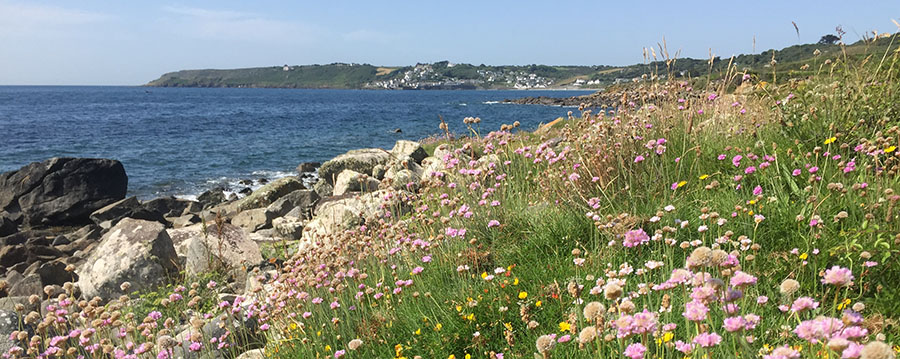
2nd August 2022 - Measuring Success
In the last few days I have been mulling over what success is, and how it is measured. Is success only measurable in economic terms, or is it happiness? How do we measure happiness? Are we happy as individuals? Are we happy as a society?
It frightens me that, despite ferocious heatwaves and fires, none of our major parties seem to understand the climate emergency, or the importance of acting not tomorrow, but today. And I feel a major sticking point is the measuring of success through growth.
The problem with growth is that it is almost impossible to spend money without involving carbon. Building houses uses carbon, industry uses carbon, transport uses carbon. It also produces waste; obsolete white goods, out of fashion clothes, unloved sofas. We are sold a fallacy that if we are wealthier, and can afford more, that we will be happier. However I am unconvinced this is the case.
I know from personal experience that being poor is not fun. Not having enough to live on is not a situation we as a society would wish on anyone. Within communities schemes such as village larders and pay-what-you-can cafes can be enriching. However when the sweet spot of earning enough to live on comfortably is reached, there is inevitably a desire for more, and our expenditure expands accordingly. Part of the reason for desiring more is the gap between the have and have nots; it is well recorded that in countries where the disparity between rich and poor is smallest people are happier.
And what constitutes growth? There is a push for low cost housing, and housing estates are filling our countryside at an alarming rate. However affordable housing is still well beyond the budget of most of our young people. If housing must be built, why not social housing, that cannot fall into second home ownership, and will allow young families to stay within their communities? Why not tackle the crisis of homelessness by making it less acceptable to have two homes, with all the additional carbon costs?
There is one type of growth that is to be lauded, and that is ecological growth. But this is often in direct competition of economic growth, especially where house building is concerned. We are lucky to have the fabulous Cornwall Wildlife Trust preserving wild places in our county, but we need to keep fighting for our wilderness, and building upon it by supporting the reintroduction of keystone species such as the beaver, which has the ability to bring about rapid and positive ecological change.
I had a very interesting chat last year with a teacher of economics. He said economics is not about money, but about resources. And our resources in Cornwall are natural ones; the sea, the countryside, our rivers, our heritage. Instead of thinking about growth, why not look at what we already have; tackling waste by creating new products out of recycled materials, celebrating nature by immersing ourselves in free pastimes such as walking, sea swimming and cycling, taking pleasure in singing and dancing and spending time with friends. Spend money on less things, but of better quality; organic vegetables, well-made products that will last.
And let’s redefine the word growth, and ask our politicians to do the same. Let’s fight for personal growth through education, curiosity, the environment, community. If we are to have any hope of fighting this crisis, we need to do so from a position of personal strength, and for that we need to grow our Cornish landscapes, our health, happiness and communities in a way that will be fitting for generations to come.
19th July 2022 - Water Saving Tips
As I write this, we are just at the tail end of the hottest weekend for some time. A spell of hot weather often means water becomes short, and given the dry spring and reservoirs already being lower than usual, it is more important than ever that we preserve water where we can. So this week I’d like to pass on a few water saving tips, that were passed to me by my friend and fellow eco-guru Rebecca Pearce.
It helps to first know how much water you are using. You can check your meter at weekly intervals. Divide by seven, then by the number of people in your household. If you are using more than 130 litres a day per person, you are using too much. The following tips are worth following however, whatever your water usage.
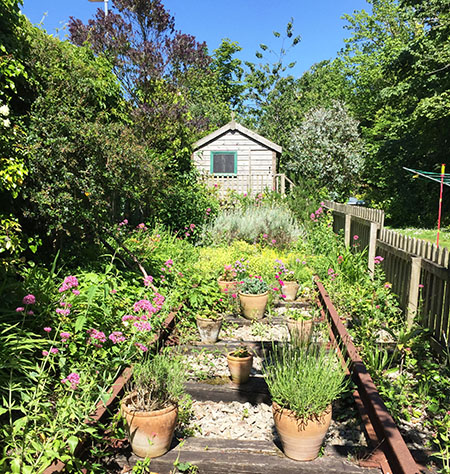 1. Stop watering the garden. Reduce plants in pots, unless they are filled with drought friendly plants like sedums or pelargoniums. Please don’t think of replacing your lawn with fake grass - it is no solution in the long run, creating a wildlife desert and unnecessary use of plastic. Instead let your grass grow longer, and allow it to go brown rather than watering it; it will quickly recover. Fit water buts for essential watering of newly planted shrubs, trees and pots. A generous weekly water will encourage plants to put their roots down deeply.
1. Stop watering the garden. Reduce plants in pots, unless they are filled with drought friendly plants like sedums or pelargoniums. Please don’t think of replacing your lawn with fake grass - it is no solution in the long run, creating a wildlife desert and unnecessary use of plastic. Instead let your grass grow longer, and allow it to go brown rather than watering it; it will quickly recover. Fit water buts for essential watering of newly planted shrubs, trees and pots. A generous weekly water will encourage plants to put their roots down deeply.
2. Keep borders well mulched and full of plants (even if it means welcoming the odd weed or two). This avoids water loss and keeps soil healthy. We use a mixture of wood chip, home-made compost and leaf mould and choose drought resistant plants for any sunny spots.
3. Check your water pressure. If it is high, you may be able to turn it down a little and still have a good enough water flow.
4. Check for leaks. You can do this by taking before and after meter readings when you are going out for the day. If you are still using water there will be a leak somewhere. Finding a leak and repairing it will save you money in the long run, and may be covered by your household insurance. If the leak is in the ground tell South West Water immediately. Modern toilets overflow into the toilet pan - check your toilets for leaks, and you may qualify for a free fix from South West Water. Shut your toilet seat to avoid evaporation. Only flush the toilet when you need to - the old adage still stands - if it’s yellow let it mellow, if it’s brown, flush it down.
5. Compost toilets are brilliant and save lots of water. If it is not practical to have one inside your house, then consider having one in the garden.
6. When refitting your bathroom go for a deep conical basin, which will take less water for hand and face washing than a shallow flat basin.
7. Fix leaking basin taps, replace washers and ensure they shut off fully.
8. Use a pulsating water-saving shower, like the ecopulse (https://pulseecoshower.com) which feels like a power shower, but uses up to 60% less water. Pulsating shower heads can be retro-fitted to your shower hose. Limit the time you spend in the shower. I find a cold water shower does this perfectly for me! If you are less die-hard in your approach, set a timer for three minutes and stick to it. Turning the shower off while you wash your hair also helps.
9. Keep bath water shallow, or make it an occasional treat. It is better for the skin and hair not to over shower; flannel washing and showering less often is a good way to conserve water.
10. Only wash clothes when you have a full load, and only when they are dirty. A quick airing outside on a washing line may well be all your clothes need to freshen them up.
11. Usually a well packed dishwasher will be more water efficient than washing by hand.
12. Rather than using a pressure washer, scrub paths with sand and a hard brush. Alternatively brush paths when it is raining, and make use of the free water. Use a bucket rather than a hose for washing windows. Taking your vehicle to a car wash will ensure the toxic dusts picked up from the road do not make their way into your drains.
13. Avoid the temptation to invest in a water (and chemical) hungry hot-tub or swimming pool.
14. Keeping a covered jug of water in the fridge will give a ready supply of cool water, so there is no need to run tap water until it is cold. If you find you need to run water to get it hot or cold enough, then save the run-off for the garden.
Remember - there are some exceptional circumstances where a lot of water is needed such as for people with certain medical conditions. Never go without if it will affect the health and wellbeing of a member of the family. If we are all cautious and sensible with our water use, there really is no reason why there should not be plenty to go around.
1st July 2022 - Live and Let Live
For me midsummer is a time of contemplation. Evenings are long, so immersion in nature, whether walking through the countryside or spending time on the beach, is a regular pastime. It is festival season, so a time for connecting with people through music and arts. It is also the time of year that my mother, Frankie Lister, died, and this for me adds poignancy.
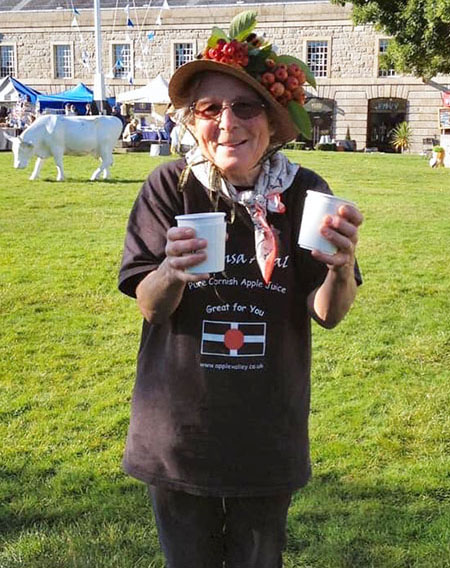 Mum was a teacher and a conservation advisor, who was passionate about all natural things. She lectured on Countryside Management at Duchy college and helped farmers with stewardship schemes. Mum was always full of sage advice and practical guidance, so I have been giving thought this week as to what she might want to communicate in this column, and have concluded that her favourite saying live and let live’ would be a good place to start.
Mum was a teacher and a conservation advisor, who was passionate about all natural things. She lectured on Countryside Management at Duchy college and helped farmers with stewardship schemes. Mum was always full of sage advice and practical guidance, so I have been giving thought this week as to what she might want to communicate in this column, and have concluded that her favourite saying live and let live’ would be a good place to start.
As I write I am speeding up the Cornish mainline from Hayle to St Germans. Seeing nature from the train is a great way to observe; the railway provides a natural wildlife barrier. It is noticeable how ash die-back has crippled many trees, but also how some are resisting. I like seeing fields where large trees still punctuate the hedge line. All along the way I am accompanied by willow herb, dog daisies, valerian, hog weed and vetches.
Left to its own devices nature is very capable of restoring itself, providing food for wildlife of all sizes. However as a species we have become accustomed to believing it is our right to shape nature. Our desire to own more houses, build faster roads and farm on an industrial scale inevitably has a destructive effect on the countryside. There is a drive to plant more trees, and while this is commendable, there is a lot to be said for looking after what we already have.
Looking after what we have starts in our own homes. Look at your garden. Our combined gardens are larger in area than all the national parks combined, so how we treat them matters. So often established gardens are transformed into unimaginative labour-intensive lawns and tanalised fences in the name of progress. If you are thinking of overhauling your garden, before you do stop and ask does it really need fixing?
If you have an established hedge but feels it takes up too much garden, have a go at turning it into a feature by planting clematis and roses through it, and underplanting with shade tolerant plants like violets, lily of the valley or geraniums. Hedges can be cut back after the nesting season, so now is a good time if it needs a trim.
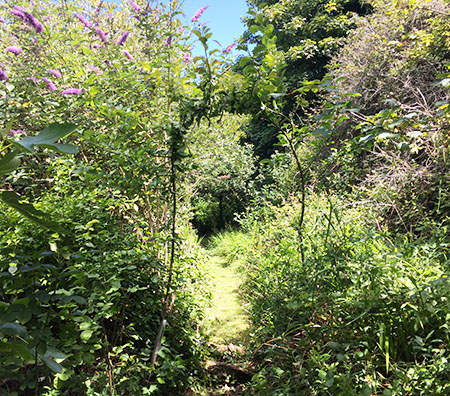 If you have an old tree, then it will provide far more habitat than any young replacement will. If you have a tree that is dead, but not risking anything should it fall, then leave it as dead wood for insects, which will provide a feast for garden birds, as well as good nesting habitat. That old pond that seems like a waste of space will be full of amphibians and insects, as well as providing water and food for birds.
If you have an old tree, then it will provide far more habitat than any young replacement will. If you have a tree that is dead, but not risking anything should it fall, then leave it as dead wood for insects, which will provide a feast for garden birds, as well as good nesting habitat. That old pond that seems like a waste of space will be full of amphibians and insects, as well as providing water and food for birds.
We are often good at loving birds, but failing to understand that birds need insects, small mammals and less loveable wildlife in order to survive. This is one of the difficulties in returning to organic farming; a loss of insects has led to a loss of birds, so when food is grown organically the imbalance leads to a plague of pests, thus we feel the need to reach for pesticides. We do need to break this vicious circle, and by inviting wildlife into our garden in the long run we help repair nature, that in turn will help organic growers.
If maintaining a space is too much, why not let areas grow wild and see what happens? You may end up with a space that at first glance seems messy, but the wildlife that accompanies it will be worth it. Long areas of grass cut once a year at the end of September will quickly populate with hawksbeards, knapweed, daisies and sometimes even orchids. Nettles in a sunny patch are a butterfly superfood, so cutting them down late in the season will help.
So let us move the focus away from shaping nature, and let nature shape us. A new tree will take many decades before it anything like replaces a mature tree. With oaks they say two hundred years to grow, two hundred at maturity, and two hundred to die. Let’s be custodian to our hedges, mature trees and wild spaces, and pass them on intact to the next generation. Live and let live. A legacy for our children to pass on to theirs, so they can continue to enjoy the countryside for many more years to come.
7th June 2022 - A Platinum Jubilee
By the time you read this article, the country will be in the aftermath of a hedonistic weekend of partying and celebrations. I love national holidays. They unite communities like nothing else. We have just returned from a holiday cycling around the Lizard peninsula, and every tiny village seemed to have a plethora of live music and street parties planned. In St Germans our annual May Tree Festival has been extended to include a street party, with all the usual fun activities, gathering all ages in a truly inclusive way.
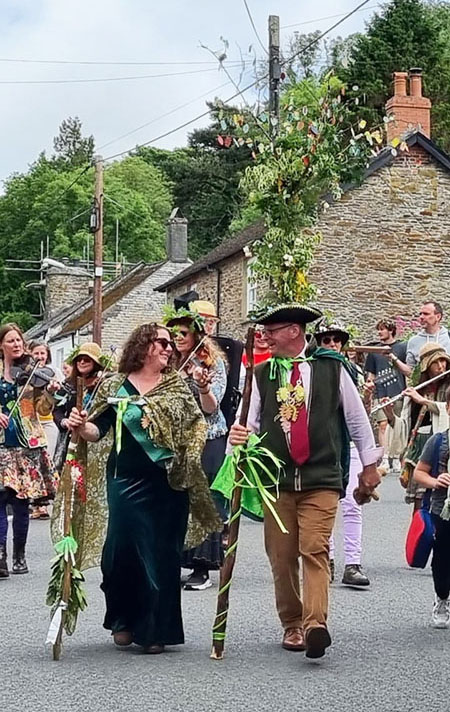 I think one of the reasons I love these jubilees so much is because they take me back to the carnivals and jubilees of my childhood, which were such enjoyable community events. I think it’s fair to say that in the late seventies and eighties life was a little slower than it is now. Life revolved around the village shop, hall, school and pub. Housing wasn’t so expensive that both parents were obliged to work. There were three channels on mainstream TV, which had restricted transmission hours.
I think one of the reasons I love these jubilees so much is because they take me back to the carnivals and jubilees of my childhood, which were such enjoyable community events. I think it’s fair to say that in the late seventies and eighties life was a little slower than it is now. Life revolved around the village shop, hall, school and pub. Housing wasn’t so expensive that both parents were obliged to work. There were three channels on mainstream TV, which had restricted transmission hours.
I think it is also fair to say there was probably less money and material goods about, but more time to enjoy things. Holidays were taken in the UK - I only knew one person in our primary school who had gone to the Mediterranean, and most families only had one car. There was a growing awareness of climate problems, mainly through pollution and acid rain. By the late 80s it was being recognised that CFCs in spray cans and refrigeration units were thinning the ozone layer, but climate change was not the urgent issue it is now, and the rain forest was still fairly intact. I wish there was a way to turn back the clock and do things differently, because at that time we did have the leisure of time to turn things around, which is sadly lacking now.
If we go back further again to the time of Queen Elizabeth’s coronation things were radically different again. This was a time of austerity, when few people owned a car, let alone a colour TV. The question is were they less happy? They were certainly leaner and fitter! It was safer to cycle and walk, public transport was well used, and the rail network covered the country with an effective infrastructure that progressive governments have allowed to be destroyed.
There was plenty of pollution though. Steam trains chuffed out plumes of dirty smoke, a pall of dense smog filled cities on still cold days, and factories poured pollutants into dead rivers. But at least we owned our dirty industry, rather than neatly passing it on to China, where it is out of sight, out of mind. Plastic was still in its infancy, and so seas were cleaner. We still had the skills to make do and mend, economy was circular with money staying within communities, rather than into the pockets of corporate supermarkets and big businesses. Our population was scarcer; second homes were not a thing for anyone other than the landed gentry, a class that has dwindled. As a result there were far more wild, unspoilt places. Food was traditionally grown, including in the garden, and so soil, and edible produce, was healthier.
So for both ends of the Queen’s tenure of the throne there are good elements and bad. What if we could pick and choose? Technology has given us an opportunity to end coal and oil burning worldwide, but to enable this we need to use the thrifty model of the 50’s where holidays were taken locally, public transport was used and farming was more ecologically managed. We need cleaner industries on our doorsteps and an end to obsoletion in manufacture. We also need to be prepared to pay more for better quality goods that will last longer and be repairable (which in the long run is better for our pockets). Advances in building materials mean we could have super-insulated houses that retain a steady temperature year round. We could keep our spend within our communities, with a return to old fashioned skills that utilise the advances of technology to increase efficiency. If we could action this, and I believe that with a few lifestyle and political tweaks we could, then we would be well armed to tackle the crisis on our doorstep. And that really would be something to celebrate!
26th May 2022 - On food
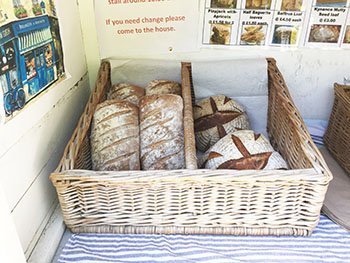 When it comes to choices on decarbonising our lifestyles there are some things we can cut out, and some we cannot survive without. Food is one of them. A wise person once said to me we should eat only what we need, and what is in season. It is a simple but powerful message. Here, in a slightly longer-winded way I would like to explore how we can green our diet.
When it comes to choices on decarbonising our lifestyles there are some things we can cut out, and some we cannot survive without. Food is one of them. A wise person once said to me we should eat only what we need, and what is in season. It is a simple but powerful message. Here, in a slightly longer-winded way I would like to explore how we can green our diet.
My first tip is to start ordering a weekly vegetable box. For reasons that I’ll cover later we need to increase our vegetable and fruit consumption and move away from a meat based diet. It is difficult in supermarkets to shop for vegetables without excessive packaging, and often supermarket vegetables and fruit on offer are air freighted. Vegetables in a veggie box, having come straight from a field, will be fresher than those in supermarkets, which have had a series of processes to go through before they reach the shelves, including being driven to a processing plant in the north before being distributed to stores. So Cornish cabbages may have travelled many hundreds of miles before they enter your basket!
The best option is an organic veg box, as no petrochemicals have been used in cultivation, so it is better both for the environment and our bodies. We get ours from Keveral Farm - Keveral Farm - a farming cooperative based near Looe. I find our box saves us money and is a source of delight; I love the element of surprise, there is no getting distracted in shops by things we do not need, and eating seasonally means that things become a treat to be savoured. Last week we had asparagus, which tastes all the better for only being available for a short time. They also offer the option of a fruit box.
Farm shops and farmers’ markets are a good option for fresh local produce. You can find your nearest options at Cornwall Markets. An excellent scheme locally is Tamar Grow Local, an online shop offering in-season produce from local, small growers.
Traditionally we would have preserved short season crops to eat throughout the year - hence the invention of jams and chutneys. We can still do this. Things like wild garlic and foraged foods can be easily preserved in oil or vinegar - just make sure jars are airtight.
If you live in a town, a cheap (but not necessarily healthy!) way of greening your diet is to buy discounted products at the end of their sell-by date, that would otherwise be discarded.
You are probably already aware of the message that a powerful reduction in our carbon footprint can be made by reducing the quantity of meat we eat. This is undoubtedly true, but we still need to take care that we are not replacing animal produce with air-freighted alternatives.
So what is the argument for reducing meat? The first is that any animal will consume calories in order to make a few grammes of flesh, eggs or milk. If we consume these calories directly from the field, rather than putting them through an animal first, then inevitably the process is more efficient. The second problem with animal products is a management one. Intensively reared animals need to be fed while living indoors. The food is often soya based. Soya production for animal food has led to massive rainforest deforestation. However soya for human consumption in Britain tends to be grown in Europe, and accounts for a tiny percentage of the soya that is used overall, so soya products can be eaten with a clear conscience.
Bovine animals produce methane, which is a potent but short lived greenhouse gas. I dislike the argument about cattle being the culprits for global warming because of the methane effect; we have reared cows for centuries without problems and they have become a useful scapegoat for our addiction to fossil fuel, which is the biggest elephant in the room. However I do also accept that at this moment in time while greenhouse gasses run unchecked, that reducing the number of cows worldwide is necessary - again it comes down to the importance of practicing extensive not intensive farming.
Cattle and sheep living outdoors on a grass fed diet, particularly in places like Cornwall where the soil is not suited to crop growing, can be reared in a way that actually benefits the environment; well managed mixed grasslands with an mix of chicory, clover and other soil enriching plants, can sequester carbon if they are not overgrazed. And therein lies the crux - management must be extensive. And extensive farming leads to a lower yield, so we need to get used to eating less animal products of a higher quality. Reducing your meat or cheese consumption to just once or twice a week will make a big difference. But a word of caution; grass fed beef from abroad is not good, as again rainforests are being destroyed in order to create grazing land. So back to the old adage - eat just what you need, and eat local!
12th May 2022 - On green holidays
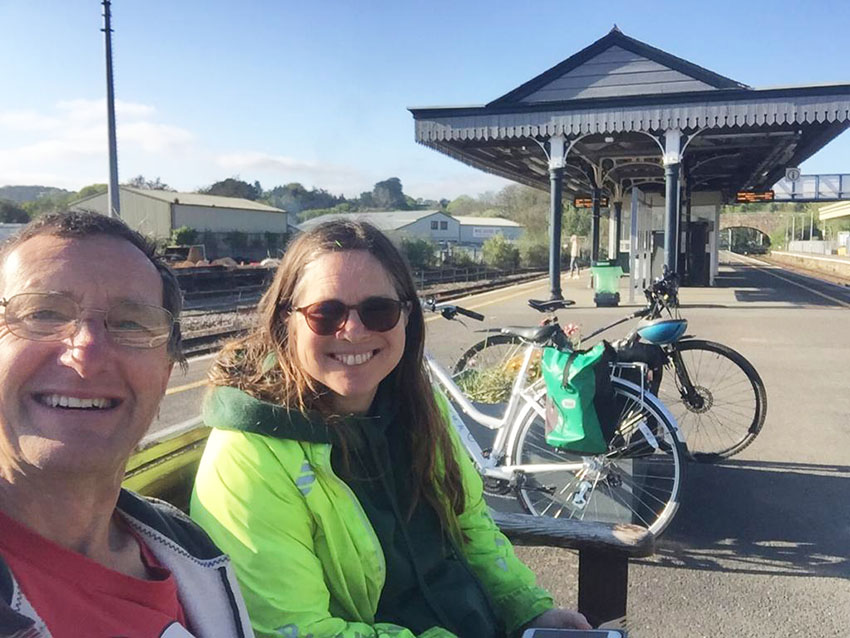
Don’t we all love a holiday? With lengthening days the prospect of getting away becomes an enticing one.
Green tourism is a subject close to my heart. For my day job I co-direct Railholiday, restoring and renting railway carriages for holiday accommodation, so over the years have immersed myself into greening our business, and have given what sustainable tourism means a lot of thought. So here are my top tips for greening your holiday.
Go local. Much of a holiday is about spending time with loved ones, and this can be done as easily on your doorstep as it can be further afield. We all have hidden pockets of Cornwall and Devon that we have not yet experienced, and when you live in the most beautiful place in the world, it is not hard to have a good time without going far.
Chose sustainable options for staying in. B&Bs, hotels, camp sites, caravan parks and lodges all offer accommodation that do not take housing out of the local market and often supports micro- entrepreneurs. Do you really need to book a self-catering cottage in Polzeath, Polperro or Padstow? Holiday property investment by wealthy people, often from outside the area, has led to a housing crisis for our communities, and ghost villages in winter. Barn conversions and lodges built specifically for the tourism market are far more sustainable options.
Explore your sustainable travel options. Pick somewhere to stay with good public transport links, or that offers walking from the door. Are there cycle networks you can explore? You are rarely far from a bike shop, and electric bikes now offer the option of travelling a bit further than you might manage under your own steam. Some bike shops also offer a delivery service. Can you leave the car behind, or at least only use it occasionally? Investing in a walking app or OS maps is also a good idea. Try setting yourself a fifteen mile circumference for day trips that involve a drive. If the countryside is not your thing, choose a city break that is easily accessible by train or bus. A useful resource for train information, especially if you decide to go further afield, is The Man in Seat 61.
Support local businesses when on holiday. Find the nearest farm or local shop to buy your food from, rather than stocking up at a supermarket. Use a local guide - they can be a great source of information. If visiting the beach, take a bag with you and do a mini beach clean. Visit local nature reserves and immerse yourself in the beauty of the natural environment. The more we appreciate it, the greater will be our desire to save it. What can you take home from your experience? Can you make your own home and garden more wildlife friendly? Use holiday time to gently assess what others are doing. Admire, or be critical. Both are fine.
Go for longer. One of the biggest carbon costs of a holiday is the journey there. By moving away from micro breaks and taking a week or more you can reduce your footprint considerably.
Holiday time is precious for what it offers. It is a chance to recharge, and enjoy the head space that comes from escaping your normal environment. It is a chance to take stock and rethink what direction life is heading. It is allowing time not only to listen to the birds, but to get out the binoculars and see them too. We do not need to do lots of things or travel vast distances to unwind and view life differently. Getting away is as much a state of mind as a physical adventure. Bon voyage!
20th April 2022 - On meaningful action to assist Ukraine
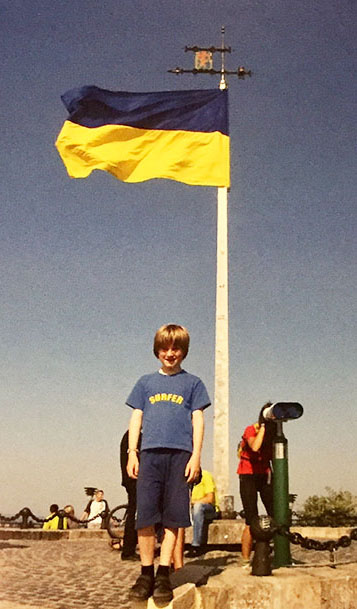 It is sometimes difficult to keep cheerful when there seems to be so much bad news about. With a war going on in Ukraine it can be hard to focus on anything else. We travelled around Ukraine by train in 2011 and have found news of the atrocities absolutely heartbreaking. So how can we help?
It is sometimes difficult to keep cheerful when there seems to be so much bad news about. With a war going on in Ukraine it can be hard to focus on anything else. We travelled around Ukraine by train in 2011 and have found news of the atrocities absolutely heartbreaking. So how can we help?
Our government has been slow to embargo oil, so one of the first actions I took was to consciously cut out all journeys by car, unless absolutely necessary. We already have an excellent village shop and veggie box for food, and are lucky to have a good bus and train service in our village. However the things I cannot do by public transport - sea swims, writing classes and visits to Dad’s orchard, I am now doing on bike, and I feel fitter for it. We must reduce our oil use if we are to help Ukraine, as without money from oil Russia would not be able to raise the funds needed for its military. If the armed forces are not paid, they will not be so willing to risk their lives killing their neighbours. This is a war with huge civilian casualties. Not driving seems a small price to pay. And of course the environmental and financial benefits that come with cutting out oil are positive too. If you have oil-fired heating, wear a jumper and turn it down as much as you can.
Alongside oil, Russia supplies the UK with coal, and this is something our government will not be boycotting until the end of 2022, thus ensuring we continue to fill Russian coffers. We need to end our reliance on fossil fuels quickly, not just for the environment, but also for the people of Ukraine. One short term option is to change energy providers to those who only offer 100% renewable energy, like Octopus or Good Energy. We can also burn wood rather than coal on open fires and stoves. In the longer term we should be campaigning for all new builds to be highly insulated, have their own solar power for electricity generation and good off-road connections to local schools, shops and surgeries. I was told that in Cornwall there is a weighting - the need for low cost housing means builders are allowed to cut corners, and environmental factors are not prioritised, leading to a continued reliance on fossil fuels by those who can least afford it. If you do not feel this is acceptable, write to your MP, and your local parish or town and county councillors.
At times like this we need to reach deep into our reserves of compassion. Engagement in compassion opens the eyes and allows us to access humanity, which is desperately needed. Some of us can open our homes to refugees, but this is not possible for everyone. However something we can all do is think about how we can tackle the housing crisis so that shelter is more readily available for all. Despite an epidemic of homelessness, many perfectly good houses lie empty. If you have a second home give some serious thought as to how much you need it. If you go on holiday chose a sustainable option such as a barn conversion, caravan or lodge, that has not taken housing out of the community. The problem is not with immigration, but with our desire to own more than we need. And as the larger crisis we face is ecological, we need to seriously question how we are also going to make more space for nature alongside shelter and halt the flow of poor quality housing estates concreting our countryside.
The visa process enabling Ukranians to come to the UK is painfully slow, and comes at a time when other refugees are being very poorly treated. With global warming there will inevitably be more conflict, and more population displacement, especially in places such as Rwanda, which, despite its dismal human rights record, has recently signed a £120 million deal with our government to relocate asylum seekers. The journeys of Ukrainians to the UK is hard, but think also of those coming from the African countries, travelling on foot across continents and risking their lives in dangerous passages. Our government is consistently cruel in its treatment of people who have fled war-torn countries, but sending them to Rwanda must be their cruelest and most unethical policy to date. Put yourself in their shoes. How many of us have taken the opportunity to emigrate to France, Spain, New Zealand, Australia? We need to pressure the government to review how they treat asylum seekers, because at the moment our system is nothing short of inhumane.
War is a terrible thing. In the past war has created change. We can choose the change. We can use this horror to reassess our own relationship with fossil fuels. By boycotting oil and coal and by showing humanity we may not be able to fix the situation, but at least we will be doing the best we can.
30th March 2022 - On waste
Remember the days when we stockpiled toilet paper, so much so that shops sold out, and those who did not stockpile, did not get? Or how the same scenario played out at the fuel pumps last year? With the desperate situation in Ukraine and rising fuel costs, it is likely that in the foreseeable future that food shortages are going to hit us, and with it the inevitable surge of panic buying as we protect ourselves and our loved ones. However instead of panic, perhaps we should we considering resilience, and looking at reducing waste as a means of making food go further.
Currently more than 900 million tonnes of food is thrown away every year. Last year the UN Environment Programme's Food Waste Index revealed that 17% of the food available to consumers - in shops, households and restaurants - goes directly into the bin. Some 60% of that waste is in the home. Curiously lockdown was a time of reduced food waste, which I feel was probably down to households having more time to cook. So how can we reduced our waste?
1. Go local! Get a veggie box and make this your staple to which you add things. A lot of waste is created by supermarkets, and many perishables are lost in transit. A box of freshly picked produce directly from the field is going to be much less wasteful. Shop at local shops, little and often if possible, as although you may spend a little more on each item you will be less tempted to buy things you do not need.
2. Make a shopping list and stick to it. Supermarkets have one goal - to make you part with money. And so they entice with multi-buy offers, which are often impossible to resist. Overbuying is a false economy in the long run.
3. Cut down on plastic waste by bringing along your own reusable bags and containers. We have a number of excellent independent shops in Cornwall that do loose food by weight.
4. Learn to forage. In season at the moment are wild garlic, three cornered leek, Alexanders, dandelion leaves, mint, navelwort and bramble tips. Add a scattering of primrose flowers and a cider vinegar, honey and mustard dressing and you have a delicious salad. There are some excellent books to help; start with Richard Mabey’s Food for Free, or Rachel Lamberts Wild Food Foraging in Cornwall and the Isles of Scilly.
5. Remember use by is not the same as best before. Best before is simply a guidance that food producers are obliged to add to their produce, and many foods will be fine for months and sometimes years beyond this date if kept sealed. Because my family used to produce apple juice, we are working through bottles that are ten years past their BBE date, but the juice is absolutely fine. Use by is different - that is reserved for perishables that could become toxic (eg. meat and fish) and should be discarded when the date has passed.
6. Join the Cornish gleaning movement which is also on Facebook. This is a brilliant scheme that involves going to farms and food processing plants to rescue surplus foods that would otherwise be wasted. There are many reasons for this waste; sometimes farms produce more than they are contracted to, as a means of ensuring they fulfil their orders, and don’t have a market for the surplus. Sometimes the harvesting machines do not manage to get all the crop, or there is a shortage of farm labour. Sometimes food is rejected because it is not practical to process or sell due to damage, but is still perfectly useable. Last week I helped bag up potatoes that had splits in them. They were not good enough to be sold to shops, the splits meant they could not easily be processed by machines for chips or crisps, but in all other ways they were perfect. So they have now been sent to food banks and community kitchens. Gleaning is a good fun way of meeting people too. If you have a farm or food surplus of any kind, then the Gleaning movement would love to hear from you.
By helping to reduce your own food waste, you can help to take pressure off the coming food crisis, so that food can continue to be readily available to all. And as a bonus you will no longer be spending money on food that is not being used, so a win-win all round.
14th March 2022 - On public transport
Living beside a railway station, and having travelled extensively across Europe and into Africa and Asia by train, has meant that train travel has long been close to my heart. I am a great advocate of public transport, despite all its flaws, or which unarguably there are many.
One thing is absolutely true - we consistently underestimate the cost of running a car, which can be almost as expensive as shelter, and with current fuel prices, far more than food. And while public transport has a carbon cost, it is generally less than other types of transport, and the more of us that use it, the lower the footprint.
I am chair of our local public transport group, and we are surveying the uses (and non uses) of public transport at the moment. We would be very grateful to hear from all residents living in the St Germans and Rame Peninsula area, which includes Torpoint, and spreading as far as Landrake and Blunts in the Saltash direction. There is a cash prize of £100 to be won which will be awarded at random to a participant at the end of the survey.
What we are trying to establish is not just what works, but also what does not work. We are as interested in hearing from people who do not use public transport as we are from those who do. What are the success stories? Where can you get? Where can you not get? What are the barriers? Are they physical, or financial? Are there alternative types of public transport we don’t yet have in this country that should be explored? Do please let us know!
And if you have a bit of time to spread the word, do please encourage your friends and family to do the survey. If you have picked up a flyer from your local pub or shop, please pass it on to someone else. The more information we have, the more power we have when it comes to negotiating with service providers and councils to get what we need.
When travelling abroad, we have come across some excellent public transport initiatives that are not available over here, but work very well. In Turkey Dolmus (meaning stuffed) minibuses go from A to B, stopping absolutely anywhere on route to pick up passengers who flag it down at the roadside, until it is so full no-one else can get in. In Morocco cheap taxis do the same; they pick up extra passengers if they are going in approximately the same direction. Imagine how quickly the taxi queues in Looe on a Saturday would go down if they were able to dispense passengers at Sandplace and Duloe on the way back to Liskeard, or Nomansland, Widegates and Hessenford in one run. This would make for an efficient and cheap form of transport, and reduce carbon miles. Sadly Covid makes the development of such arrangements. At the moment we have large buses on country lanes. During the season they may fill, but in winter are often almost empty. What would entice us to use them more, and thus keep the facility? Do they serve us in the way we need them to? I personally find myself in need of public transport in the evenings when buses do not run, and suspect I am not alone in this.
Trains rarely take us to where we need to go, and this is where improved cycleways, more options for hiring bikes and cars at stations, and lift shares could be woven into an incorporated transport system.
One of the most commonly cited criticisms of public transport is cost. On the train there are ways of tackling this; a Devon and Cornwall railway (available from manned train stations for £12, with proof of address) will knock 1/3 off your ticket price when travelling off-peak (any time after 9am). For those of us younger than 60, but who regularly travel with a partner or friend, then it is worth investing in a Two Together Railcard, available at Great Scenic Railways to find out more -
Of course one of the best things about public transport is meeting people. It is an adventure, and each time different; something that can never be replicated in a car. And adventure makes life fun! Which is often just the tonic.
21st February 2022 - On gardening and tree planting
At this time of year I am rarely seen without a spade in my hand. We are lucky enough to have ten acres of woodland, and Dad has a small holding, so for me winter is tree and bulb planting season. It is a small thing that I can do to help our planet.
The climate crisis we have on our hands is not just environmental, but also ecological. We are losing flora and fauna at an alarming rate due to changes in farming practices, industry, house and road building and poor environmental management.
To counteract this we as individuals need to do more than just reduce what we consume. We also need to build more ecology into our lives. Our gardens account for more land than all the national parks combined. So what we do can make a difference. Simple ecology building in a garden could be replacing a fence with a hedge (there is still time to do this before April). It could be putting in a small pond, planting pollinator friendly perennials, adding trees (even a small fruit tree has good benefit), letting grass grow long, or filling window boxes with herbs.
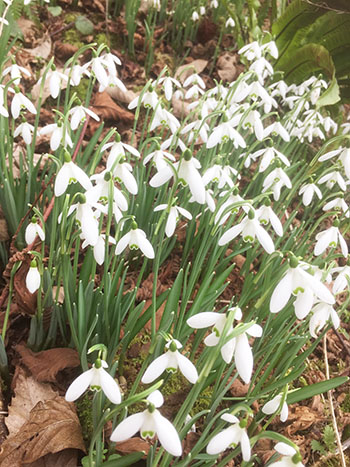 Because we have a woodland, one of my projects over the last few years has been to increase the spread of snowdrops and bluebells. Every year in February and March I dig buckets of snowdrops and move them around. (They are best moved in the green, just after flowering.) I started five years ago, and the result now is very satisfying.
Because we have a woodland, one of my projects over the last few years has been to increase the spread of snowdrops and bluebells. Every year in February and March I dig buckets of snowdrops and move them around. (They are best moved in the green, just after flowering.) I started five years ago, and the result now is very satisfying.
I was showing a walking group around this week, and one of them asked why go to all this effort for something that only flowers for a few weeks a year? It was a good question, and I felt one worth exploring in this article.
To combat the climate crisis we need to reduce our carbon usage. It really is as simple as that. Fossil fuels need to stay in the ground. One of the biggest carbon spends we have is in travel. Why do we feel the need to have exotic foreign holidays? Frequently it is because we are dissatisfied with our own busy lives, and are looking for fulfilment in other ways.
I find by gardening I feel grounded into my environment. From the end of December when the snowdrops first poke their heads up, until early March, I walk around the woods and delight in the little changes that come each day. I could not bear to take time away during this period. In the garden at home I am also enchanted by the hellebores, lungwort, crocuses, hyacinths, narcissi, winter honeysuckle and much more.
When all these go over, they are replaced by the promise of apple blossom, tulips, roses, clematis, then michaelmas daisies, rudbeckias, walnuts, autumn fruits, and finally the joy of mulching with anticipation of enjoying another year in the garden. With each season comes another reward. Seeing saplings grow into maturing trees is a wonder.
Providing an environment we love to live in, becoming immersed into our local communities, finding the special places on your doorstep that you can enjoy on a daily basis; all of these things will reduce the need to travel, and save money.
I appreciate that not everyone is as lucky as I am in terms of access to land. However there are many ways into gardening. My grandfather used to volunteer as a gardener for the elderly - perhaps you have an infirm neighbour who might need help? Cornwall Wildlife Trust, and many of our heritage houses have opportunities for voluntary gardeners. There are also community agricultural schemes. To find out more visit Community Supported Agriculture. Back to TOP
9th February 2022 - On speaking the truth
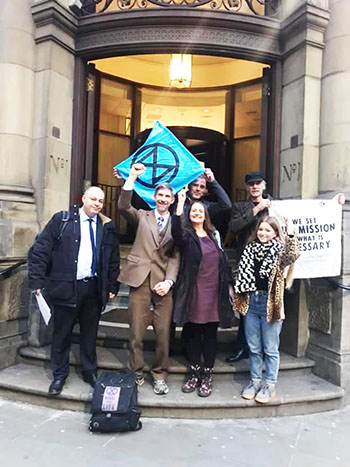 On Saturday I had a chance meeting on a train with Dr. Larch Maxey, the co-founder of the Network of Well-being (NOW), which is devoted to building personal, social and environmental wellbeing. Larch is a well-known environmental campaigner, who gives talks on the climate crisis across the UK. Although Larch wouldn't have known who I was, our daughter Poppy testified in a trial for Larch against unfair arrest, for which he was acquitted on the grounds of Poppy's evidence. A real proud parents' moment for us.
On Saturday I had a chance meeting on a train with Dr. Larch Maxey, the co-founder of the Network of Well-being (NOW), which is devoted to building personal, social and environmental wellbeing. Larch is a well-known environmental campaigner, who gives talks on the climate crisis across the UK. Although Larch wouldn't have known who I was, our daughter Poppy testified in a trial for Larch against unfair arrest, for which he was acquitted on the grounds of Poppy's evidence. A real proud parents' moment for us.
The opportunity to canvas Larch for his opinion was too great not to miss, so I posed the question What do you think is the single most important thing we as individuals can do to avert the crisis? His answer Tell the truth.
While I think we will all agree that telling the truth is central to our human moral and social code, actually doing so is more complex. For starters how do we even know what the truth is? We are bombarded with conflicting information and constant background noise from social media. The majority of our mainstream newspapers are owned by four wealthy individuals who have never let honesty get in the way of a good story. Our corporations have an incentive to keep the truth hidden in order to preserve profit. And it’s been clearly demonstrated over the past few weeks that expecting our government to be honest is a farce. Even our scientists have openly admitted to covering truth because of pressure from media, business and politics. How do we trust anyone any more?
Larch bought to my attention that we are living in a time of soft climate denial. We acknowledge that climate change is happening, but behave as though it is not fully real; playing down the severity of the situation and overestimating scientific uncertainty, thus not enacting the level of change needed to mitigate climate change. And who can blame us? Facing the facts is scary.
One person you can reliably trust is yourself. We have a tendency to mythologise how things used to be (remember those long hot summers). Make an effort to observe how things are now, because although we are far from the frontline, signs are filtering through. Learn about the extreme weather that is affecting the UK and beyond (remember there has always been extreme weather, but frequency is the key). Record the birds, look around at the wildlife on your doorstep. Did you see swallows last summer? When did you last hear a cuckoo? Have you noticed the spring droughts? The way trees are increasingly susceptible to disease?
Now think more widely. How do you feel about the terrible tragedy of migrants in the channel? Why have we got mass migration? The war in Syria is just the start of climate-change conflict where resources simply cannot support a nation. Look at satellite pictures and notice the change in ice over the years. What will happen to low lying nations like China, India and Bangladesh when they become flooded? Where will those people go, and where will staple foods like rice be produced when agricultural land is under water?
The problem with truth is that it is hard! This is why it is easiest to dismiss it. And why we need support each other as we journey to understand what is happening. Part of the process involves grief, anger, fear and anxiety. While we need the truth, we also need to be kind to ourselves. Take on bite-sized pieces of information and learn when to stop. Balance fact-finding with positive action; find others in the community who are going through the process of learning about climate change so you can talk through your concerns (Saltash Environmental Action Group are friendly and welcoming.) Start to work out ways of building resilience. Avoid blame (we are all guilty) but imagine the future as you would like to see it. If you can, volunteer within your community as this is a great way of enhancing well-being and widening your social circle.
Removing division and being open-hearted helps. If fear of migration bothers you, join Open Hearts Open Borders who help repatriate people who have had to flee their homes and talk to people about their experiences. If loss of nature is a fear, volunteer for Cornwall Wildlife Trust, campaign for better planning laws, or support organic farmers by buying a local veggie box. Join a litter picking group. Pledge to go flight free.
Balance your absorption of the truth with actions to keep your psyche positive; listen to music, dance, walk, cycle, stay healthy. Despair is no good to anyone. Accept inconsistency will be part of the process. As humans we are all fallible!
Finding the truth, knowing the truth, learning how to communicate the truth, none of it is easy. But it is something every one of us can, and should, do. And then, strengthened by the truth we can look towards positive action in building the resilience we need.
26th January 2022 - Why electric cars are not the solution, but electric bikes might be
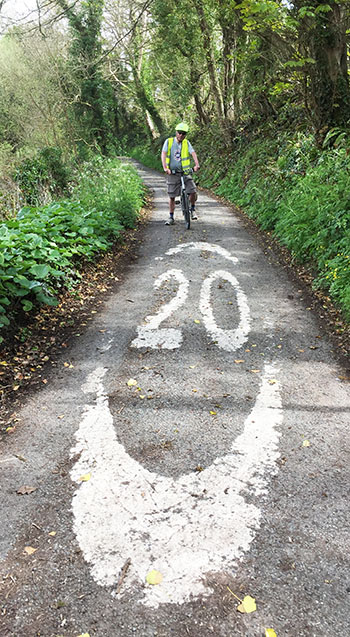 Over the Christmas period I watched the clever film Don’t Look Up, which has a plot that focuses on systematic denial that a meteorite was on trajectory to hit planet earth. There were chilling parallels with our current political and social apathy to the climate crisis.
Over the Christmas period I watched the clever film Don’t Look Up, which has a plot that focuses on systematic denial that a meteorite was on trajectory to hit planet earth. There were chilling parallels with our current political and social apathy to the climate crisis.
One problem is that it is very difficult to accept we cannot continue in the same way, but need a complete systems rethink. Acknowledging this is massive. I would like to use the push for electric cars to illustrate this.
Being able to drive a car in our rural areas is often essential. But the reason for this is because we have moved away from local food production and sales, and local facilities that are easy to access by public transport. The first problem is a planning one; estates have been built that do not have schools, shops, walking and cycling infrastructures to serve their residents. Planners have time and time again supported out-of-town supermarkets and American-style corporate shopping centres with large carparks that are only easily accessible by car But the solution to this problem is easy. Electric cars! So we can build back better and life continues as normal.
But with the same old choices come the same old problems. In this country we have not yet reached 100% renewable energy generation. The additional pressure on the grid from electric car-charging will inevitably lead to a continued reliance on fossil-fuel power stations, and it is also inevitable that there will be pollution involved in lithium mining, particularly in countries where regulation is lax.
With any large man-made object, the greatest carbon cost comes in the building of it. So with cars, using your old car until it is no longer functioning will always be a sounder option than replacing with new. However, when you use that car you will be creating pollution and greenhouse gases. In reality the only sound way forward is to reduce.
Take a critical look at your car usage. Do you have to drive to work, or could you sometimes work from home? Do you do lots of small shopping trips, when a well organised weekly one would be more efficient? Do you drive to the north coast, when you have south coast beaches on your doorstep? Do you always take local options when it comes to walking and day trips? Do you fill your car with passengers, or are most of your journeys solo? Do you do journeys that other people in your locality also do, that you could pair up for? (For example taking children to school, or driving to the train station for a regular commute) Are there times you could catch a lift or take public transport? Are you using the car for short journeys that could be done on foot or bike? In our rural communities this is one of our flaws; we have a car, so we use it even when it is not really necessary to do so.
There are many compelling environmental reasons for reducing car use; pollution (both from the journey and from road building), danger to wildlife and safety for those on foot or bike, being three that spring to mind. There is a good alternative though that has taken off in recent years, and that is the electric bike.
The great thing about electric bikes is that you do not have to be super fit to use them. With panniers you can do shopping with them, they are cheap to run and a great alternative to a car. The carbon build cost, and price, is a fraction of a car, as is the energy they require. And being out on a bike in the fresh air will contribute to your sense of wellbeing and improve your fitness. Your biggest bug-bear will be cars. In which case you may wish to cut out this article and pass it on, as if we were all to take to riding bikes and walking, only using a car when absolutely necessary, our roads would be far safer. Which can only be a good thing for everyone.
31st December 2021 - A Seasonal Poem
Being a bit of a writer, I could not resist the opportunity to share a little Christmas mulling over the environment, and our part in it.
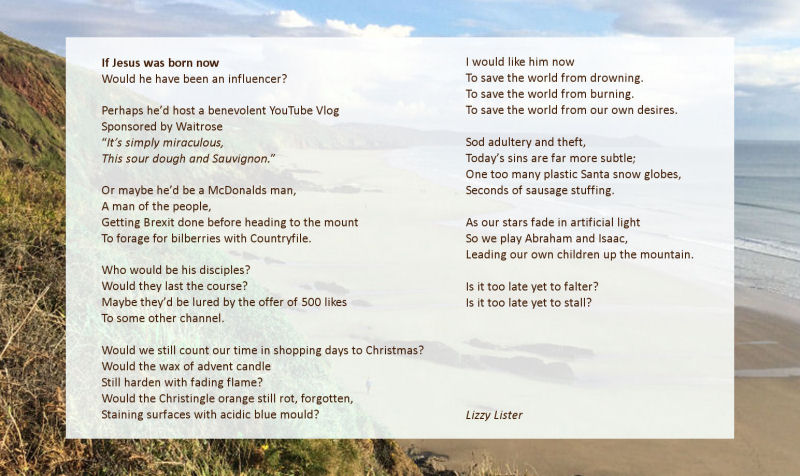
22nd December 2021 - Reducing waste over Christmas
 I hope this article finds you well and enjoying Christmas. I am looking forward to my children returning from university and being able to spend time both physically and online with family and friends.
I hope this article finds you well and enjoying Christmas. I am looking forward to my children returning from university and being able to spend time both physically and online with family and friends.
Christmas is often a time when we do have a little more time than usual to give. And your time will be precious to someone during a season when loneliness can be overwhelming for some. COVID has made face to face meeting much harder, but a phone call can really brighten someone’s day. And at this time of crisis we do need emotional support, love, and of course a recharging of batteries.
One of the chief problems of Christmas is waste. In our enthusiasm to make everything perfect we buy too much. I am sure you will have heard the sage phrase that to combat waste we need to Reduce, Reuse, Recycle. Reduce is the most important, and hopefully this Christmas this has already been considered; by the time you read this article the Christmas shop will probably be sorted. However there are ways you can avoid throwing too much in the bin. Here are my tips.
Compost any peelings. If you do not have a garden do you know anyone who has an allotment? They may be happy to take your waste. Freeze any left over food as soon as you can. Food left in the fridge can often linger well past its usable date. Buy stock cubes and make lots of soup to freeze for later in the season. And before you do your next shop, see if there is anything that needs to be eaten first.
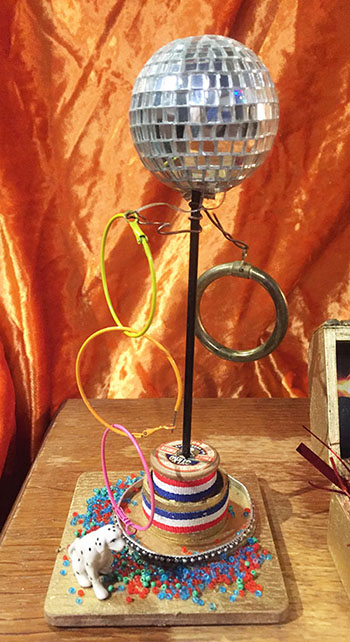 An excellent initiative is run by Cafe Abundance, whose strapline is saving food from landfill by feeding our community. Cafe Abundance take waste food and use it to feed those in need. It also runs a compost service; caddies cost £8 to buy and £3.50 to empty (most small households do this once a fortnight).
An excellent initiative is run by Cafe Abundance, whose strapline is saving food from landfill by feeding our community. Cafe Abundance take waste food and use it to feed those in need. It also runs a compost service; caddies cost £8 to buy and £3.50 to empty (most small households do this once a fortnight).
We tend to use newspapers and ribbons for parcels, but if you unwrap presents carefully you can save any quality paper for another occasion, and ditto with ribbons. Keep any gifts you are not sure you will use in their boxes, for redistribution later. And when the decorations come down do store tinsel etc in a box for next year. There is a great joy in unwrapping decorations that have an emotional connection with the past. I also love making gifts and trophies from unwanted bric-a-brac, and homemade crackers, which always go down well.
Finally enjoy what is around you, those wonderful natural gifts that do not cost the earth. Get out for brisk walks, cycle, sea swim (with caution and with company!), play games, dance, sing and enjoy the companionship of your closest friends and family. Because in these dark days and long nights loving what we have will nurture and sustain us until days lengthen and spring begins.
So Joyful Solstice, Merry Christmas, a Happy New Year and see you in 2022!
8th December - Time to get political
It could be argued that everything we do is political, but I try in my discussions about the environment to focus on what matters most to our communities, our wellbeing and our children’s future, rather than focusing on politics per-say. There are, however, sometimes things that happen on our doorstep that are extraordinarily short sighted and damaging. This is where we do need to get political in the traditional sense, if we want to exert influence. And the funding of our local leisure centres is a case in point.

I hope we all know about the dire future some of our local leisure centres are facing. However you may not know that Cornwall Council has offered funding to Newquay airport of the same total that would save our leisure centres. When it comes to aviation and space, which are both desperately bad for the environment, there seems to be diplomatic immunity from criticism. Much is made of employment. And yet, particularly for the space industry, the employment is not likely to go to our local populace, but to draw in expertise from outside our area.
Compare this to our leisure centres, which not only offer stable employment and job opportunities for school leavers and beyond, but train our young people in life-guarding and fitness skills. In a county surrounded by water the ability to swim is essential, and our schools use these leisure centres for all their students, not just those who can afford it. Consider the environmental cost of travel to leisure centres outside the area, and the on-the-street social cost of removing yet more things for our young people to do.
Why is this happening, and what can we do about it? I am a great believer in getting out onto the streets and making a noise. Worryingly if the Police, Crime, Sentencing and Courts Bill is passed in its current form, then potentially peaceful protest could result in an ASBO or a jail term. I am hoping it will not come to this! If you prefer to campaign from home, you can sign a petition (although the effectiveness of petitions are not always as powerful as we might like them to be). Or you could get involved with politics at a town or parish level. I have joined my local council, and it has very much bought home to me that we desperately need good, environmentally sound councillors, otherwise poor decisions will continue to be made at a local level.
If you do not want to be on a council, then why not attend a meeting or two as an observer? It will sharpen the mind of those making the decisions. Work out what your local area needs to make it better - a footpath or cycleway, better planning laws, support for local shops, improved public transport, a community newsletter etc. then campaign to make them happen. Join forces with other green-minded people around you. Saltash Environmental Action Group (SEA) would be an excellent place to start. We can make change, but only if we are prepared to move away from criticising on the side-lines and join in the scrum.
And let us keep fighting for our local leisure centres, because if we are serious about climate change, then we need good facilities that are accessible for all on our doorstep.
24th November - Celebrating Localism
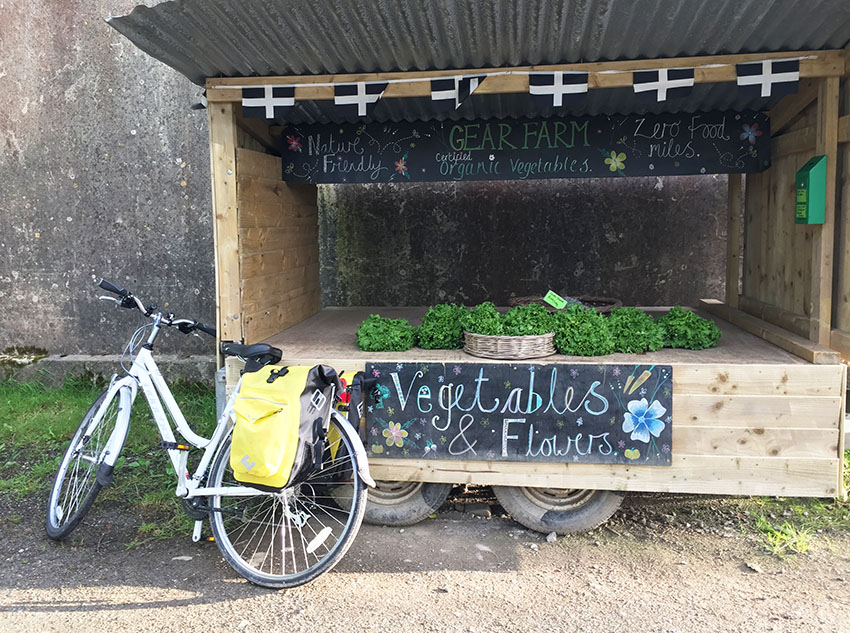
Of all the things we can do to save the planet that will also add a better quality to our own lives, localism has to be right up there. So what is localism? And how does it work to reduce our carbon spend?
Localism is about supporting the community you live in. It is also about regaining control of our home environment.
In buying a local paper you have committed an act of localism by supporting local journalism. You probably bought it from a local independent newsagent. Local shops may not always sell local produce, but their profits support local families rather than shareholders. And your trade will be appreciated. Similarly using tradespeople who live and work locally not only keeps skills within the community it also means that when you have an emergency you are more likely to get a quick response, as loyalty works both ways.
Buying groceries from a local shop will mean you can form a relationship with your vendor. If what I need is not stocked in our village shop, they will always make a special order, and being independent have access to ranges that might not be readily available elsewhere.
Being from a farming background I have grown up with stories of supermarkets treating their suppliers badly with little regard to the small-holder at the end of the chain. I have also seen excellent examples of local stores taking my parents produce and treating them well. We have a veggie box. It is delivered to the door, organic, local, seasonal and good value. And easy.
I have also found that, contrary to what might seem logical, eschewing supermarkets saves money. I am not persuaded to buy things I do not need by seductive offers that lead to greater waste. I save on fuel and time.
When I call into our village shop I am greeted by name and have a chance to catch up on neighbours and friends. And if I am looking for a babysitter, plumber, builder, a recipe for chocolate brownies, where to find an upholsterer or the cheapest way to get to London, the chances are there will be someone there who knows. And if they don’t this time they will by my next visit. And that is a service you won’t get anywhere else!
The run up to Christmas is an excellent time to switch to local buying. Our towns are depleted of tourist trade, so really need local spend at this time of year. Years ago we set ourselves the challenge of doing all our Christmas shopping in Looe, Saltash and Liskeard. We have never been let down yet, and the process is actually quite fun, even for someone like me who hates shopping with a vengeance.
So in a nutshell how does localism work? It keeps money spent within the community, creating a circular economy. It reduces carbon miles. It gives communities power to be what they want to be. It reduces isolation and keeps us fit. And when things go awry as they did in early 2020 the community has the capacity to support itself.
My book recommendation this week is a beautiful read by Raynor Winn - The Salt Path. I picked this up from Liskeard bookshop on a whim and was utterly entranced by Raynor’s moving story of he she and her ill husband took to the coast path when they became homeless. I challenge anyone who reads this not to be overwhelmed by the desire to reconnect with our beautiful Cornish landscape. We are so lucky.
10th November - Moving away from built in obsolescence
My generation is one where most of our grandparents were involved in war, and all were familiar with post-war austerity. Our baby-boomer parents spent their early years in a time of rationing, eating home-grown vegetables and wearing homemade clothes. My grandmother’s family farmed the land around Biggin Hill airfield, so they really were in the thick of it.
I am lucky to have a very bright 95 year old uncle and am in the process of helping him complete his autobiography. Farming in the 30s and 40s was fascinating; they understood the land and ecology in a way we are only now now beginning to appreciate. Cutting hedges by hand took all winter, so there was always bushy growth for birds to shelter and feed in. Any cultivated land was considered less valuable and had to be returned to pasture by the end of the lease. My father often says the only way to save the planet will be to live like peasants. This does not have the negative connotations we might presume, as a simple life grounded in nature is in fact satisfying for the soul. We have just lost sight of it behind our continued desire for economic growth.
 I always like to honour the memory of my grandparents with a poppy at this time of year.
I decided some time ago I would no longer buy disposable poppies, but just put a donation in the pot, and last year bought myself a pin badge I could use indefinitely. These pin badges used to be a simple, plain poppy. However someone clever in the sales department has clearly decided to run with our 21st century agenda of more is best, and stamped a date on the poppy, offering immediate obsolescence. Presumably any 2021 poppies left will have to be disposed of, and we will all need to get the latest one.
I always like to honour the memory of my grandparents with a poppy at this time of year.
I decided some time ago I would no longer buy disposable poppies, but just put a donation in the pot, and last year bought myself a pin badge I could use indefinitely. These pin badges used to be a simple, plain poppy. However someone clever in the sales department has clearly decided to run with our 21st century agenda of more is best, and stamped a date on the poppy, offering immediate obsolescence. Presumably any 2021 poppies left will have to be disposed of, and we will all need to get the latest one.
Although I can see the attraction of dated poppies, I think this is a great shame. I am all for vintage things, so will continue to honour my pledge of putting a donation in the box without needing a poppy in exchange, and wear my 2020 poppy with pride. I know my grandparents would approve.
This inclination towards built-in obsolescence is everywhere, from phones to ever increasingly complicated white goods that can only be fixed by the company technician. We accept our toasters or kettles will die after a few years. Yet I have Mum’s Kenwood Chef from the 1960s that is still going strong. From electrical goods to clothes, in our desire to buy cheaper we have sacrificed quality. In the long run it is a false economy, as rather than buying once we buy many times, with the associated implications of carbon spend and waste that comes with it.
So in a nutshell if you do need to buy new it is better to save and buy the best quality you can, and only do so once.
Finally, in a nod to my grannie’s farming past my book recommendation this fortnight is Orchard by Benedict Macdonald and Nicholas Gates. This beautiful written book explores the wide variety of nature found in a traditional orchard over the course of a year, with fascinating insight into the habits of birds, insects and small mammals that are often invisible to us until we stop to really observe.
27th October - On Want versus Need
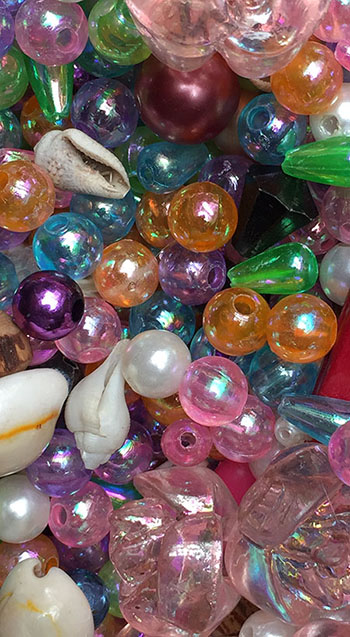 Apologies to be mentioning the C word before the end of October, but now is the time many of us turn our thoughts to present buying. Christmas can be wonderful, but can be a time of financial stress. Already we are being bombarded by advertisements that entice us to spend, and to desire things that we may want but do not need. And the difference between want and need is one of the fundamental concepts in reducing waste and tackling the climate crisis.
Apologies to be mentioning the C word before the end of October, but now is the time many of us turn our thoughts to present buying. Christmas can be wonderful, but can be a time of financial stress. Already we are being bombarded by advertisements that entice us to spend, and to desire things that we may want but do not need. And the difference between want and need is one of the fundamental concepts in reducing waste and tackling the climate crisis.
Too often we are persuaded to buy things we do not need. So next time you go to spend money ask yourself the question Is this something I actually need? Can I make do with what I already have? Most adults when asked will agree they already have too much stuff, and most would like less rather than more!
So how do we negotiate the season of giving? The hard thing about Christmas is that we naturally like to give presents. It is an easy way of demonstrating love. However our time is often a more precious gift, and this is too easily overlooked. If you do not need money to buy commodities then you can afford to spend less time working, which can then free up time to spend with loved ones, which is something money cannot buy.
I have a large family. Years ago we put a rule on our Christmas gift giving. Presents have to cost less than £10 (and preferably less than £5), be home or locally made or from a charity shop. As a result we have had some fabulously inventive presents. There is no embarrassment because one person has clearly spent more on gifts than another. And we all have a lot of fun. And joy is what life is all about.
Finally, as we do all like to give gifts, here is an idea you can do now. As autumn offers us its abundances, it is the perfect time to make chutney. As a base use any glut of surplus fruit or veg, such as apples, marrows, pears, squash, pumpkins, quinces or tomatoes (green or red). No need for a recipe - just add some chopped onions, a few spices (eg mustard seeds, cumin, peppercorns, coriander seeds, fenugreek or pickling spice from your local deli). I like a chopped chilli to give a bit of heat and some dried fruit for added sweetness but that is absolutely optional. Add a teaspoon or two of salt, and plenty of brown sugar and vinegar to taste; these act as a preservative (I use local cider vinegar). Simmer for a few hours on a low heat until thick. Spoon into preheated clean jars, cover with a circle of greaseproof paper, screw the lid on firmly and leave to mature. By Christmas you will have a delicious gift to give to your loved ones.
In the next few columns I’ll be suggesting books for curling up with as the days grow shorter. My suggestion this week is Mike Berners-Lee’s How Bad Are Bananas - The Carbon Footprint of Everything. It is a good introduction to the carbon cost of day to day living and provides plenty of food for thought. And the newest edition is readily available from your local bookshop!
13th October - Fuel Shortages.
What a couple of weeks it has been. COVID has still dominated the Cornish headlines, and fuel shortages have seen great long queues in fuel station forecourts.
We have been lucky enough not to have been badly affected by the fuel crisis. We work from home, live beside the railway station and have an excellent village shop. However I have to admit that had our band had a gig in north Devon, as we did a few weeks ago, we might have struggled. We also had two holiday bookings cancelled as a result of guests not being able to travel.
Which leads me to philosophise - why are we so reliant on fuel, which is causing so much damage to our environment, and what can we do about it?
Along with the climate crisis we have a parallel health problem. We are all getting fatter and less fit (I include myself in this!) The two problems go hand in glove. How has it happened?
For years we have built our communities around the car, and commuting. Instead of walking to the shops, and building strong town and village centres, big impersonal shopping centres on the edges of town have been built, where the only easy access has been by car. Add large free car-parks, and parking charges in centre of town car-parks then bingo, we change our shopping habits accordingly.
As a result town centres die. Big corporate businesses mop up the profit, with cheap prices because they have the power to drive down the price they pay to farmers. Small farms get swallowed by larger ones in the quest to survive. Land becomes managed for optimum yield a way that is damaging for wildlife, we learn to buy strawberries at Christmas time because they can be cheaply flown from Kenya and everyone is happy because it is all so convenient. Until we have a fuel crisis. And the effects of global heating hit the fan.
I was interested to learn recently that there are more deaths as a result of pollution than there are from road traffic accidents. So what can we do to improve this, and how can we protect ourselves from the next fuel crisis?
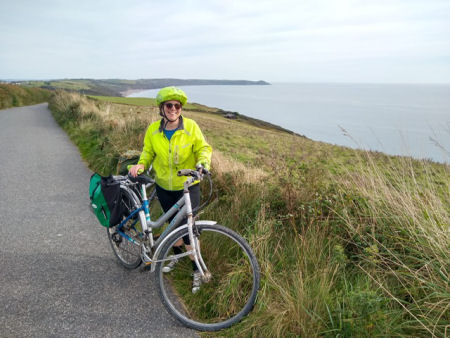 The first is to shop locally in shops owned and managed by local people. There are several excellent ones in our locality, with most offering local produce and plastic free packaging options. See if you can get there by green modes of transport; invest in panniers, a shopping trolley or a good quality rucksack to make carrying easier. It is the old adage - use it or lose it, so let us support those businesses that deserve our trade.
The first is to shop locally in shops owned and managed by local people. There are several excellent ones in our locality, with most offering local produce and plastic free packaging options. See if you can get there by green modes of transport; invest in panniers, a shopping trolley or a good quality rucksack to make carrying easier. It is the old adage - use it or lose it, so let us support those businesses that deserve our trade.
The second is to work out how to change your work commute. Can you get to work by public transport or find something closer to home? Can you persuade your workplace to fit a shower for commuting by bike?
Thirdly we need to fight any plans for new out-of-town shopping centres. We are in the midst of a crisis. It should be the role of our councils, who have declared their commitment to tackling the climate emergency, not to let them pass. But unless they have a backing of public dissent they can feel powerless, or inclined to follow the fallacy of job creation while studiously ignoring the good quality jobs that will be lost in other places.
Finally let’s see a push for ever more public footpaths and cycleways that will allow us to travel from A to B in a healthy way, and open up green routes to our shopping and working places. Then when the next fuel crisis hits we can all be smug together.
27th September - On the Ecological Crisis.
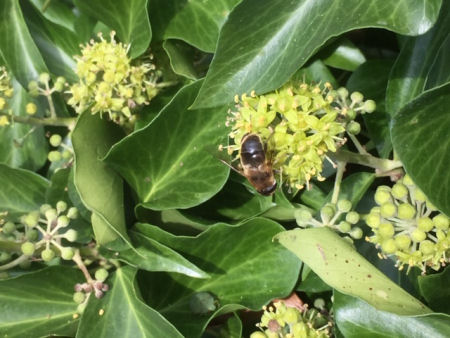 I was reminded yesterday that the current crisis is not just environmental, but also ecological. To me the two go hand in hand; reduced emissions will mean cleaner air, and a healthier planet. But of course the most effective way of improving air quality is to add plants of all sizes, and the best and easiest way of doing so is to plant or preserve a hedge.
I was reminded yesterday that the current crisis is not just environmental, but also ecological. To me the two go hand in hand; reduced emissions will mean cleaner air, and a healthier planet. But of course the most effective way of improving air quality is to add plants of all sizes, and the best and easiest way of doing so is to plant or preserve a hedge.
Hedges are great. They are versatile and can be slipped onto a boundary where they will need little attention other than the occasional trim. There they will add a living windbreak, privacy, a home for birds, and a climbing frame for ivy, which is one of the best wildlife plants. Traditionally a few trees would be allowed to grow taller and become standards, offering shade, structure and another layer of habitat. These standards could be oaks, which support a greater number of life forms than any other tree, fruit trees such as damsons, perfect for autumn foraging, or hawthorns, with their fabulous pollinator friendly blossoms and bird nourishing haws. Hedges also provide enormously important wildlife corridors, food and shelter for birds and small mammals in the winter, and blossom in the spring.
We are lucky in Cornwall to have a number of nature reserves; in Saltash we have Timcombe and Churchtown, and other popular areas such as Coombe Woods and Latchbrook, that are full of wonderful native plants and wildlife. To bring these things into the town and everyone’s gardens we need to extend our connecting green corridors. This means caring for and protecting the last remnants of ancient hedgerows.
As we expand our communities with developments there is a danger that we may swallow up the farmland and hedges we need to care for. Look out in your locality for cris-crossing old hedges, which are great refuges for hedgehogs and support a wide variety of songbirds, especially when well managed and litter free. It is important to avoid disturbing hedges during the nesting season, but it is equally important to leave hedges bushy enough over winter to offer shelter to overwintering birds.
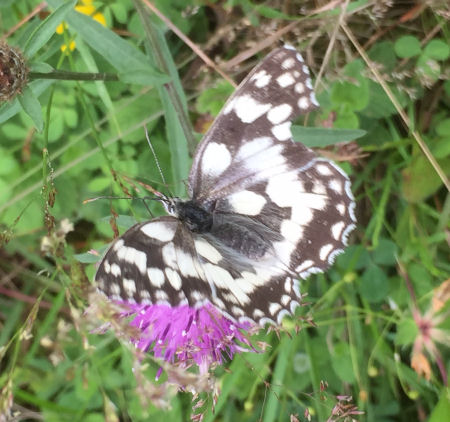 If you do not yet have a hedge, but do have a little space in your garden, now is the time to start planning. Bare-rooted hedge bundles can be planted between November and March. There are many companies offering wildlife friendly mixes of hawthorn, crab apple, field maple, blackthorn, bird cherry, hazel, guelder rose and dog rose. I planted a boundary hedge six years ago which is now a colourful, busy place that is a joy to behold.
If you do not yet have a hedge, but do have a little space in your garden, now is the time to start planning. Bare-rooted hedge bundles can be planted between November and March. There are many companies offering wildlife friendly mixes of hawthorn, crab apple, field maple, blackthorn, bird cherry, hazel, guelder rose and dog rose. I planted a boundary hedge six years ago which is now a colourful, busy place that is a joy to behold.
If you already have a hedge, it is worth layering it for optimum wildlife benefit. I am lucky enough to have champion hedge-laying father, but if you do not have one of these, then Duchy college offers a two day course. If you are in the fortunate position of owning a small holding or larger piece of land, then allowing your hedges to grow big and bushy will protect field margins from excess run off and offer a home for birds that predate on crop pests, reducing the need for sprays.
So in a nutshell grow and celebrate hedges. Instead of a feeding station, give birds a home and sustenance in one package. Rejoice in those bushy tangles of hawthorn, hazel and ivy, for they will provide food for the future for all kinds of wildlife long after we can.
15th September - On Climate Activism
 Last Saturday Dave and I travelled to London to take part in the Extinction Rebellion March for Nature. In my desire to do something that would look spectacular I found myself up all night, sewing feathers on my hat and cloak, which led to the inevitable question; why am I doing this and what do I hope it will achieve?
Last Saturday Dave and I travelled to London to take part in the Extinction Rebellion March for Nature. In my desire to do something that would look spectacular I found myself up all night, sewing feathers on my hat and cloak, which led to the inevitable question; why am I doing this and what do I hope it will achieve?
Protests and marches have a long history of precipitating change. Joining a procession or a protest is also a great way of meeting like-minded individuals and recharging the batteries. It is a way of being able to have a voice, a tool to publicly question the status quo. But with that we also open ourselves to public criticism and stilted representation by news hubs and social media.
Heading home after the demonstration I thought I would do a search to see if there was anything about the XR nature march on the internet and came across the shocking headline XR activist drives a diesel car! This lead me to conclude that the media have somewhat missed the point. So for the uninitiated, just what is Extinction Rebellion, otherwise known as XR, and what is their purpose?
XR are fighting to combat climate change. They have three demands; that the government must speak the truth about climate change, achieve zero carbon emissions by 2025 and to form citizens assemblies so that the broadest cross section of society has a say in the process. There is no doubt that achieving zero carbon emissions by 2025 would require massive transformations, but experts say that these would be dwarfed by the ensuing chaos of failing to act, and we have been dragging our heels for a very long time now.
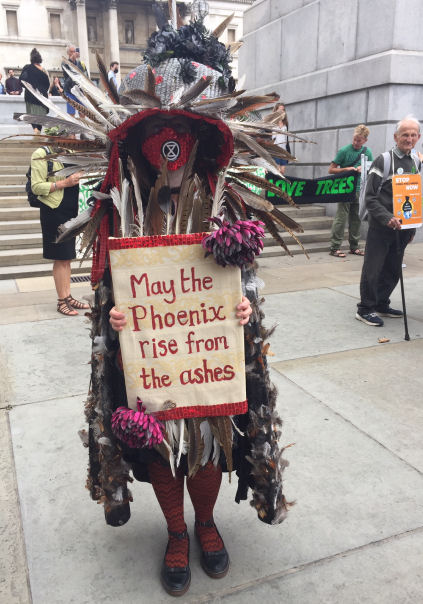 Essentially the XR actions are about systems change. They are not about pointing the finger at individuals. I drive a diesel car, and will inevitably do so until we have a coherent network of cycle paths, workable public transport for rural areas, shared car ports, community based shops and services etc. Electric cars do not solve the problem - there is a sizeable carbon cost in building anything new. As an individual I can chose to use my car as little as possible, but we do need governments and big businesses to act.
Essentially the XR actions are about systems change. They are not about pointing the finger at individuals. I drive a diesel car, and will inevitably do so until we have a coherent network of cycle paths, workable public transport for rural areas, shared car ports, community based shops and services etc. Electric cars do not solve the problem - there is a sizeable carbon cost in building anything new. As an individual I can chose to use my car as little as possible, but we do need governments and big businesses to act.
This movement is not about laying guilt or denying an annual holiday abroad or stopping people travelling to see relatives or friends, but to ask for legislation that will sensibly tax those who fly multiple times in a year without regard to anyone else. It is not about forcing veganism, but to encourage mindfulness in a diet by eating local and seasonal food with minimum packaging and avoiding waste. Again legislation that charged for the carbon cost of blueberries from South Africa, and legislation to reduce plastic packaging would help. I do not have these tools, but governments do.
So in short this movement is not about picking over the trivial and demonising the individual, but about asking governments and businesses to do what they were elected to do; lead in a way that will ensure a quality of life, both now and for future generations. Because like it or not we are already committed to a certain degree of global heating, and without care and decisive leadership this could soon become very bad. Not in eighty years time, but in ten or twenty. Which is a sobering thought indeed.
23rd August - On Staying Sane
What a month it has been for extreme weather worldwide. Fires have raged in America and Canada, and floods caused catastrophic damage in Germany, Belgium and China. Even the underground in parts of London was affected by unusually heavy rainfall. The high temperatures in the North Pacific states are greater than any of the scientists predicted. However one views the climate emergency, it is becoming increasingly difficult to deny it is happening. Big weather events will become more frequent, as higher temperatures lead to greater evaporation and thus more water in the sky.
So in this situation, how do we stay calm and sane? How do we keep our own momentum for caring for the environment when our government and others around the world are not acting to make meaningful change? What is the point?
Here is the point. As individuals we are small, but collectively we have strength. If we all chose, for example, to stop buying air-freighted produce, then air-freighted produce would become economically unviable and be replaced by more local options. If we all moved our money to ethical banks, then mainstream banks would be forced to rethink where they made their investments. If we all opted to buy organic, more farmers would become organic. If we only bought energy from 100% renewable energy companies, then coal and nuclear plants would no longer be viable. We live in a market economy, and while this may not be ideal, it does give us some power.
There is a lovely story about a boy throwing stranded starfish back in the sea. When asked why he was doing so, when there so many he couldn’t possibly save them all, he picks one up and throws it into the sea, making the comment “Well I’ve made a difference for that one.” So remember, no matter how insignificant your part may be in fighting climate heating, it is still essential you do it, for ultimately it will make a difference.
I am a great believer in Leonard Cohen’s line from his song Anthem; “There is a crack in everything. That’s how the light gets in.” When you find the news overwhelming, please don’t despair. Take a walk. Revel in the beautiful world we live in. And do whatever you can in your life to make positive changes happen.
27th July - Cathedral thinking.
“How wonderful it is that nobody need wait a single minute before starting to improve the world.” Ann Frank
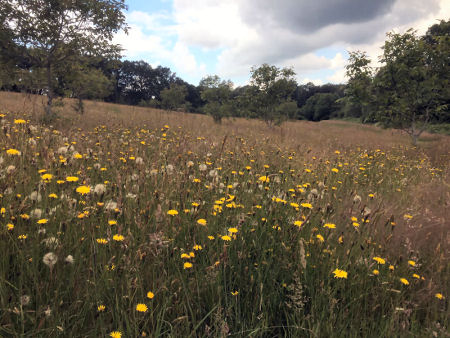 I try to practice what I preach (which is not always easy - falling short is an inevitable part of the process), so over the winter I planted over 450 trees and hedge whips, that I hope will provide sustenance and shelter for wildlife for many years to come.
I try to practice what I preach (which is not always easy - falling short is an inevitable part of the process), so over the winter I planted over 450 trees and hedge whips, that I hope will provide sustenance and shelter for wildlife for many years to come.
Among the trees I planted were some walnuts in Dad’s orchard, organised and ordered by Dad. The more expensive walnut trees were grafted, so should produce fruit in five or ten years, but we also put in a number of two year old whips that are unlikely to fruit for at least twenty years or more, by which time Dad will be well into his nineties. And this is a fine example of what Greta Thunberg calls ‘cathedral thinking’. The building of something big that will be of benefit for generations to come. We all have benefitted from our ancestors’ cathedral thinking. Look at our beautiful priory, or the fabulous parkland around St Germans, designed by Humphrey Repton. His vision was not for his lifetime, but for many lifetimes in the future.
Another example of cathedral thinking is the American-Indian concept of the children’s fire. This advocates decisions based on the seventh generation to come. I am sure that, knowing what we know, if we had followed this concept seven generations ago we would not be facing a climate emergency. However, knowing what we know, we continue to make the same mistakes, and we need now to act. Hindsight is a great thing, but foresight is surely even better.
So my plea to you this month is to adopt cathedral thinking. Reduce your spend on new things, drive less, waste less, immerse yourself into the community you live in, plant trees and invest in landscapes that you know you will never see grow to maturity. And most of all make your decisions on behalf of the seventh generation we hope will still come.
“Defend them. Protect them. They are helpless, they are in your hands. That is your duty. Your responsibility. You do that, you yourself will have peace.” – Chief Oren Lyons quoting the Peacemaker
10th July - On Redefining the New Normal
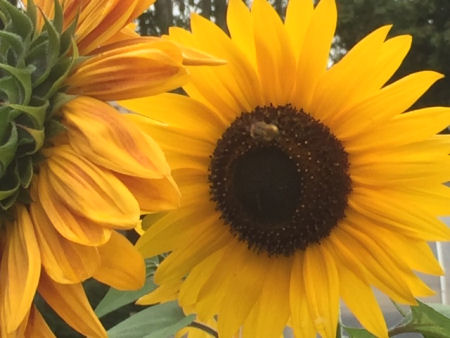 It may be that by the time you read this that all COVID restrictions have eased and life is almost back to normal, albeit with masks and sanitisers.
It may be that by the time you read this that all COVID restrictions have eased and life is almost back to normal, albeit with masks and sanitisers.
These last 17 months have been hard for everyone. However there have been some bonuses as communities have pulled together. In particular our local shops have served us proud, and some local pubs and restaurants have brightened our evenings with takeaways. I would like to say a particular thanks to Jennie, the manager of St Germans Community shop, and to Jon and Lesley, who worked tirelessly behind the scenes to make sure everything ran like clockwork. St Germans community shop and other village shops in Nut Tree land offered a lifeline for the elderly during these challenging times, delivering provisions to people stuck at home, and always offering service with a smile. This continued throughout, despite a dramatic dip in the numbers of available volunteers in the community shop, and I am sure this kindness was echoed in other shops throughout our parishes.
So now, as life resumes normality, why not reassess what we want normality to be? Why not change shopping patterns so that rather than thinking of the supermarket as the default place to shop, why not consider your local shop as the primary place to buy food, with supermarkets becoming the emergency option? You will be surprised at the range and competitive prices of our local stores, and they are a great place for local advice too - where to find a plumber or electrician, or who might offer babysitting services etc. And there’s savings to be made on time and fuel. Or better still, offer an hour or two as a volunteer in one of our two local community shops and make new friends to boot.
Similarly now is the time our local restaurants, cafes and pubs need your support. They’ve had the hardest time of all and your custom will make all the difference.
And by supporting those businesses in the community who have supported us throughout the pandemic, there’s a much greater chance of them surviving to offer us a lifeline should we need one in the future. Let’s just hope we don’t!
20th June - on gardens and public spaces.
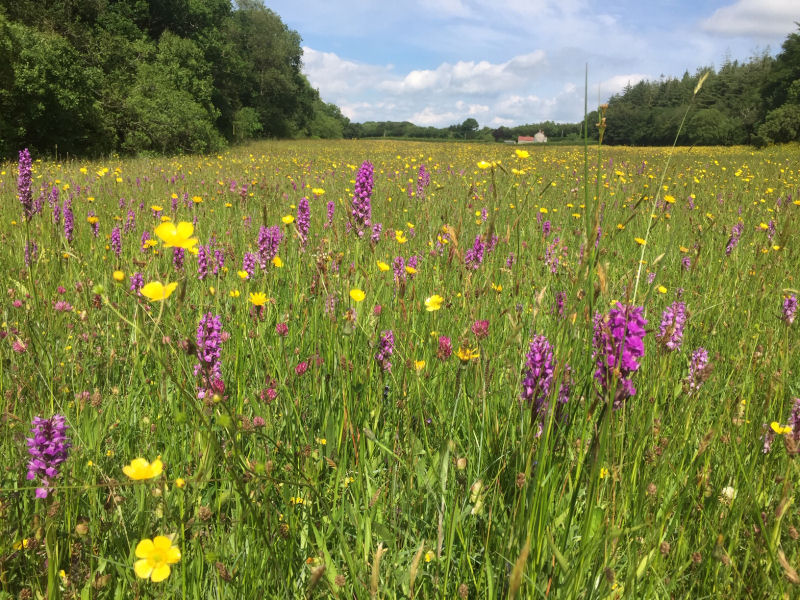
Few things are more beautiful than hedges in May and June. Stop for a while and you’ll see they are a hive of industry; creamy May blossom, campions, buttercups, bluebells, comfrey, cow parsley, vetch, all loved by pollinators. In the last twenty years pollinator numbers have taken a huge hit; primarily because of industrial farming and loss of habitat. But the good news is that we can help turn this around. Collectively our gardens make up more area than all the national parks combined. Add to this municipally managed spaces, and we are looking at a sizeable area. So how can we help?
In your own garden, why not let areas of grass grow long? This will provide habitat for small mammals, as well as pollinator food. Plant pollinator friendly flowers; lavender, any type of daisies, cosmos, viper’s bugloss, sedums, sunflowers, geraniums, marigolds, dahlias - the list is endless, but for a great source of inspiration have a look at Beekind Bumblebee Conservation .
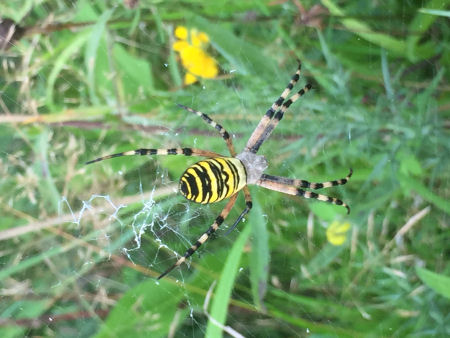 Having a range of different plant heights in your garden will also help; ground cover, grass, taller perennials, shrubs and trees make for the perfect mix. And admire rather than fear stinging insects. Like all wild creatures they will always choose to avoid confrontation.
Having a range of different plant heights in your garden will also help; ground cover, grass, taller perennials, shrubs and trees make for the perfect mix. And admire rather than fear stinging insects. Like all wild creatures they will always choose to avoid confrontation.
Hedges are just one example of public spaces that can host wildlife. But there are many others; churchyards, roadside verges, parks. Left unattended these areas will naturally support biodiversity; look closely at a small patch of long grass and you’ll be amazed at the variety within. You should find yarrow, clover, cheery yellow birds foot trefoil, ribwort plantain, the bright blue eyes of field speedwell, and orange poor man’s weathervane. Our national obsession with tidiness has meant often our plant knowledge is rusty, but there are some excellent wild flower books and apps, so information is easy to find.
So why are we mowing and spraying our public spaces until they become wildlife deserts? Why indeed. I think we have become too accustomed to thinking that neat and tidy is in some way superior. And yet if we as a species are to survive we need to look after our pollinators, who after all are responsible for giving us food. Without pollinators there would be almost no fruit or vegetables, and very few trees.
Due to COVID Cornwall council were obliged to reduce the number of times they mowed verges, and found that the ensuing regeneration of native plants was positive all round. They plan to continue with this low maintenance regime, cutting only after flowers have had time to set seed. You can read more at Cornwall Council Making Space for Nature We need to celebrate nature in all her wildness; rather than fighting for floral sterility, celebrate our long verges and encourage our local councils to stop spraying toxic chemicals. Then we can all enjoy the wealth of wildlife that comes from letting a little bit of scruffiness into our lives, and ensure a healthy future for generations to come.
22nd May - Simple Ways to Save the Planet in a Nutshell
Climate change is such a big and confusing subject it can often be overwhelming, and very difficult to know where to make a start when it comes to making lifestyle changes. Here are my top tips.
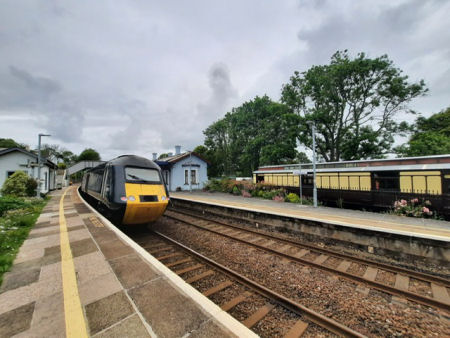 1. Switch to renewable energy providers and green your commute - walk or cycle if you can, use public transport or car share if you can't. We are lucky to have train stations in Saltash and St Germans and regular buses to Plymouth and into Cornwall. Using these services will help them grow.
1. Switch to renewable energy providers and green your commute - walk or cycle if you can, use public transport or car share if you can't. We are lucky to have train stations in Saltash and St Germans and regular buses to Plymouth and into Cornwall. Using these services will help them grow.
2. Buy local food and buy more local fruit and vegetables - especially if they're grown in a good way, without chemicals (all of which use fossil fuels). Support your local small shops and not only are you doing your bit, but also keeping your money in the local economy.
3. Don't throw any food away! We waste so much - give yourself the challenge to waste nothing.
4. Get informed: there are several web-pages that are worth a visit. Try Friends of the Earth or Project Drawdown.
5. Write to your local councillors and MP to let them know you would like climate change to be at the top the agenda. And join the Climate Vision Pledge Group.
6. Change your internet search engine to Ecosia. In return for your web-searches, Ecosia plants trees. At the moment they have planted over 131 million trees, and this is rising daily.
Then join the bigger movement! In Saltash we are incredibly lucky to have Saltash Environmental Action (SEA) who are an amazing group. They organise a number of environmental initiatives in Saltash and the surrounding area including monthly litterpicks, tree planting and helping to maintain public green spaces, campaigning on a variety of environmental issues and holding regular film nights and social events. Check out their website for more information.
And remember – do something. It doesn't matter how small, how insignificant it may seem, but your actions will make a difference. Together we can change the world.
23rd April 21 - On banks and pensions
Remember local banking? I do. There was a time when we chose our banks according to who had a local branch, or where our parents and grandparents banked. We knew the manager personally. How times change! However with the digitalisation of banking does come greater choice, and there are good reasons for investing your money in the right place.
When you place money into banks or pension schemes you are trusting the fund managers to make wise investments. Traditionally this means where they can make most money. But what if that money is being spent on environmentally damaging fossil fuels and other ecologically unfriendly companies? You may be able to save a wadge of cash for your grandchildren, but if they have no future, what’s the point?
The good news is that it is possible to choose banks that specialise in ecological sound investment. I use Triodos, an ethical bank, and the Cooperative, as both have sound environmental policies towards investment. Nationwide is another good choice. Local credit unions, such as Cornwall’s own Kernow Credit Union, keep money local. Most pension schemes have flexibility - why not ask for a green option (but be wary of greenwash) or better still go for a pension scheme that allows you to choose who you invest in. In this way we can ensure our money is spent well; on ethical, wildlife and people friendly projects that won’t cost the planet.
21st March - Learning to love weeds
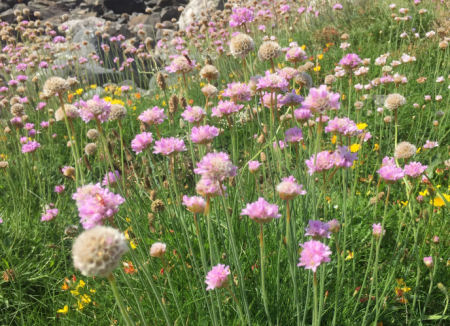 Weeds are curious things. We have a very mixed relationship with them. What can be more cheering than banks of primroses, fields of dandelions, playing What's The Time Mr Wolf as children with dandelion clocks? They can be enormously useful – at the moment I am collecting armfuls of wild garlic and handfuls of bramble tips (the fresh shoots have a nutty taste) to make wild garlic pesto. Grasses provide excellent cover for small mammals, which in turn help feed our owl population. I always look forward to seeing scarlet pimpernels, also known as poor man's weathervane, that closes when the atmospheric pressure drops, warning of rain. Umbellifers such as cow parsley, alexanders and hogweed provide useful flowers for pollinators. For me the scent of early summer is that of herb robert, as I pull this wild geranium from places I no longer want it in my flowerbeds. What can be more beautiful than scarlet poppies, or hedges of buttercups, red campions and bluebells?
Weeds are curious things. We have a very mixed relationship with them. What can be more cheering than banks of primroses, fields of dandelions, playing What's The Time Mr Wolf as children with dandelion clocks? They can be enormously useful – at the moment I am collecting armfuls of wild garlic and handfuls of bramble tips (the fresh shoots have a nutty taste) to make wild garlic pesto. Grasses provide excellent cover for small mammals, which in turn help feed our owl population. I always look forward to seeing scarlet pimpernels, also known as poor man's weathervane, that closes when the atmospheric pressure drops, warning of rain. Umbellifers such as cow parsley, alexanders and hogweed provide useful flowers for pollinators. For me the scent of early summer is that of herb robert, as I pull this wild geranium from places I no longer want it in my flowerbeds. What can be more beautiful than scarlet poppies, or hedges of buttercups, red campions and bluebells?
Nature has a wonderful way of creating a palette of beauty and food, without needing our interference. Which leads me to wonder how much we really need to strim or weed-kill our public places. In a time when nature needs all the help it can get, reducing strimming or abstaining from sprays could be an easy way of assisting it, and for free. Imagine the saving in council money if verges were only cut twice a year, or we no longer sprayed every inch of tarmac. I feel now is the time to embrace some of our many wild flowers, and let them be. If you don't like them outside your house, simply remove them with a trowel. But let's enjoy wildness while we can.
To quote the wonderful poet Gerald Manley Hopkins from his poem Inversnaid;“What would the world be, once bereft Of wet and wildness? Let them be left, O let them be left, wildness and wet; Long live the weeds and the wilderness yet.”
On an aside, if you need a wild flower guide I can highly recommend the wonderful Majorie Blamey's Wild Flowers by Colour, or any of her other guides. They are all excellent.
21st February 2021
We’ve had a lovely display of snowdrops this year, and I've been very busy moving snowdrops to make sure the display is even better next year. The snowdrops started coming up in early January, but were definitely at their best between mid January and late February. Here is a video, made on the 20th February.
23rd January 2021 - On feeding birds
In this cold weather, nothing beats looking out of the window and watching the birds. However we know birds are increasingly under threat from the ecological emergency we find ourselves in. So what can we do as individuals to help?
It is well known that modern agricultural methods have been a major cause of bird decline in the 20th century, as hedges have been removed for efficiency and pesticides have killed small insects that make up their diet. Buying organic food can help to support sustainable farming methods.
Feeding birds in the winter may help birds to survive temporarily, and squirrel proof nesting boxes can also be helpful. However, and here is the biggest crux and where our influence is most important; birds need more than food and nesting boxes. Birds need habitats. Our gardens collectively make up more space than all the national parks combined. Add into the mix municipal parks and verges, and we have a very decent area. And there are lots of things you can do in your garden, and neighbourhood, to help.
Birds need hedges and trees. As bushy as possible. If you already have a hedge in your garden celebrate it. Allow it to grow bushy and full of ivy. This will be a rich habitat for all sorts of living creatures. Cutting it down may make your garden bigger, but ecologically much less rich. Similarly with trees; the older the better. Avoid tidying dead wood, unless it poses a danger, as this will be filled with all sorts of invertebrate bird food, as well as holes and soft wood perfect for nesting purposes. If you don’t have a hedge but have space, then planting one will be the best thing you could do. And now is the best time to do so. There are some excellent places selling hedging packs; a mix of hawthorn, crab apple, field maple, dog rose, hazel and guelder rose will provide habitat and healthy food for birds well into the future. A small pond, fruit trees and bushy shrubs to offer cover will also create the perfect mini ecosystem and ensure you have birds to watch all year round.
Even without a garden of our own, as citizens we can play our part in restoring biodiversity. Rather than viewing long verges, overgrown churchyards and pockets of shrub as untidy, celebrate the ecology they support. Campaign for spray free verges and buy organic food. Adopt an allotment. Talk to your council about how you feel about the importance of a habitat rich environment. In this way our towns, cities and villages can once again become a riotous party of bird song.
On Beavers and Ecological Growth – December 2020.
What a year this has been! As 2020 draws to a close I find myself rounding up the year’s events and considering where the environment stands in it all. Forest fires, floods and the plague have made 2020 feel like a chapter from the Old Testament. However there have been positives among the chaos; more of us have been walking and connecting with wildlife. More of us have been growing our own food. Flying has taken a much needed nosedive, albeit possibly temporarily until a vaccine is developed.
For my part I have been immersed in the question of environmental growth, most recently contemplating how we can reinstate the keystone species our landscapes so desperately need to counterbalance the frenzy of house building. Keystone species are animals that can have a marked positive benefit on the environment, and one that has rightly been hitting the news recently is the beaver.
Beavers are amazing because they create water and, alongside clean air, water is the fundamental essence of life; from water grows algae, which provides food for insects, which feed amphibians, bats and birds, which feed larger predators. The other advantage of creating ponds and wetlands from streams is that they offer somewhere for the rain to go, slowing down peak flow and reducing flooding downstream. There are carbon benefits too, but explaining them may be beyond the word count of this article! Our woodland valleys are perfect for beavers.
There are of course some conflicts; there may be fields where cultivation goes right to the river bank, and beavers do enjoy munching vegetation. A good way around this would be for all farmers to be paid to leave a 20m buffer strip around waterways. This would reduce any chemical run off going into our rivers, so would be a win win all round.
At the moment the reintroduction of beavers is beset with paperwork, but I for one am hopeful that 2021 may be the year that we start to see these amazing animals doing their magic in a waterway in our locality.
For more about beavers, visit the excellent Beaver Trust site.
1st September 2020 - Bag Making
We have taken lots of Covid measures to ensure our guests stay safe, from finding eco friendly Covid killing sanitisers, so steam cleaning and sorting systems for quarantining laundry. As a result we have discovered the perfect use for all the old blinds and curtains that are too scruffy to remain in use, but too good to throw away - laundry bags. We have made this video to show how easy it is. We have also been glad of all the rope and string we have saved from our beach cleans, as they have come in very handy to make ties. To begin our bags were works of art, made of many panels in bright and glorious colours, but I have to admit that by the time we came to make this video speed had become of the essence, and I can now rattle of a bag in half an hour, rather than taking all day. Here is how we do it at Railholiday...
23rd May 2020 - Identifying Wild Flowers
During the lockdown I found myself out and about in the Countryside a lot, so made a few videos of the flowers I saw. The first of these is short and sweet, the second gives more details about the flowers.
May 2020 - Rebuilding life after Covid
I hope this article finds you all well. These are certainly unprecedented times. For many of us who are unable to work this has meant time to contemplate and think about what is important in life, and what we want when ‘normal’ life resumes. I have thoroughly enjoyed walking in and cycling in the lanes with very little traffic, having leisure time to chat in the queue to the village shop. The community spirit that was once the lifeblood of villages seems to be returning in spades.
Now could be the time when we decide we no longer want a sky filled with vapour trails, that we want investment on schemes such as HS2 spent instead on improving local community networks to make low carbon transport such as cycling and walking safer. We may wish to think more of self sufficiency; growing more of our food locally. Eating seasonally, rushing less and buying less. We may want to think more of how money dedicated to economic growth could instead be diverted to ecological growth, or local schemes to support the NHS, which despite years of cuts has been the real hero of this crisis.
For the first time in most of our lives we have been given an opportunity to say “Let’s not return to the hamster wheel. Let’s think how we can go forward for the best benefit of our local society and the environment. What do we want next?” Answers on a postcard to be sent to your MP, parish and county councillors.
In the meantime I’m hoping you all stay safe and well, and raising a big cheer for all those who have stepped up and gone the extra mile to help us through this crisis.
As an addition, can I add an especially big thanks to Jennie and the team for their sterling work in keeping St Germans community shop open and offering vital supplies to all who need it, and to everyone who has been volunteering at Quay Lane surgery.
1st May 2020
What a rollercoaster this month has been! From having to close the business and all the ensuing anxiety that went with it, came several weeks of glorious sunshine, and the opportunity to take a big breath and think about what really matters. A lack of traffic on the roads and aeroplanes in the sky made for a refreshing change, and an optomism that this could be what life might be like was balanced by the fear that with the pandemic had come a series of worrying laws being passed that could have long reaching implications on freedom of speech and the right to protest. With this is mind I made this tongue in cheek poem and video about Covid 19.
Actions are louder than words - 2nd April 2020
My very wise mother always said “actions speak louder than words.” This may be true, but it can sometimes feel like a hard mantra to follow. By sharing things on social media we can feel like we’ve achieved something, but I have a suspicion that social media platforms have the opposite effect; by manipulating and eroding our time we leave less room for actually doing physical actions. And it is actions that count; planting, mending, making. Sometimes words can be actions; for example writing this article, or canvassing a councillor or MP, but ultimately they are only effective if the end result is action. So the question must always be ‘what do we want to achieve?’ If tree planting is your thing, make sure you leave space in your life to plant trees, or to change your energy supplier to a green one, or to plan a holiday that doesn’t involve flying, or to set up Ecosia as a web browser, or to put up bird boxes and make log piles etc etc. However none of us are superhuman, so by all means share things that you know you’ll never do. But if you can, see if you can draw them to the attention of someone who may be able to follow it through. Make your words become actions and life will feel much fuller for it.
Tip for April: Now is a good time to let your grass grow long. Bulbs like crocuses and snowdrops will benefit from having their leaves left to die back naturally and small mammals will find shelter. You'll be amazed at the diversity of plants that will grow in a little plot of uncultivated meadow, and the number of moths and butterflies that they will attract.
Simple Ways to Save the Planet - 22nd February 2020
This month it seemed like our local newsletter was going to fold, so I wrote my article thanking those who had kept it going for so long. I do have a long connection with the Nut Tree, having been asigned the post of editor at the tender age of 15, when it first started in 1986. I think the title was more honorary than anything else, as the founder member Ron Daniel was the driving force behind it all, and did a huge amount of work to make it successful.
A few weeks later someone else has stepped in to take the helm, so my position as eco tips writer remains, with a break of a month or two for the changeover.I won’t repeat all the thanks in full, but the spirit of my article was thus:
It is the stalwarts of the community that will build resilience for the future. So in a nutshell BE LOCAL! Volunteer, buy local food, grow local, mend, repair and employ local businesses to do any work you need. Work and holiday as locally as you can. And plant; trees, shrubs, flowers. Let grass grow long and love where you live. Build friendships locally, and support local events and clubs. Remember friends like Ron who have taken active parts in improving our locality, and thank all those community minded people like Ron’s wife Jenny and daughter Biddy who work so hard to make where we live a better place.
3rd January 2020
I'm not great at making resolutions. I always find that January, with its dark evenings and wild weather, just makes me want to retreat into the comforts of old habits. However dark evenings do offer time for contemplation, and are often a time for holiday planning. And so perhaps there is space for one resolution that really will make a difference to your carbon footprint; to find alternative ways of travel that do not involve flying.
Last summer we had a thoroughly enjoyable exploration of Europe by rail. This was not as difficult as it sounds; there are many fine websites that can help with holiday planning by train, The Man in Seat 61 being my favourite. Alternatively you may like to cut out the travel altogether and look at holiday options closer to home. In chasing an ideal of exploration, we often fail to recognise the beauty on our doorstep. And travel could never be easier! Cornwall Council is subsidising bus travel and in December 2019 a new GWR timetable was published which has over 22 trains from St Germans in each direction. So as we enter the new year I will be making a simple resolution; never to lose sight of what a beautiful place we live in, but always be grateful for lightening evenings, fresh air, rain, sunshine and the emergence of spring.
2nd December 1919
Simple Ways to Save the Planet at Christmas
I have to admit I often feel torn at Christmas time. I love the family gatherings, the shared meals, the community social events. On the flip side I find the pressure to spend difficult. Christmas with friends and family can be wonderful, but it can also be isolating for some, especially older people, who do not have family close, or a place to go.
What can we do to make Christmas special and meaningful, without the pain of spending too much or inducing isolation?
Much of our life is spent in the pursuit of money. We need money to buy presents. But if we reduce how much we buy we need less money. Less money means less time spent working and more time to do things that make us human. And this is the magical thing. It is virtually impossible to spend money without having some impact on the environment. But the same is not true of time. In fact to the contrary. A key component to mending our environment is to build local connections, so travel is no longer a necessity and self sufficiency starts to become an attainable dream.
I have to say our Christmases have been much more fun since we put a limit to present buying and focused on home made chocolates and crafts. Your time could make a neighbour happy by paying a visit or inviting them around for a meal. You could turn those slightly over ripe apples into chutney, or an old pair of curtains into bags. You could spend time making your garden a haven for wildlife. Or simply go for a walk as a reminder of how lucky we are to live in such a beautiful place.
And if you do still want to give a present, then there are some excellent charities offering gift options that won't clutter up your friend's houses, but that give a glow in the gifting.
Merry Christmas to you all. And thank you for all you are doing to make the world a better place.
11th November 19 - A first court appearance.
 In our enthusiasm to do all we can to help reduce the effect of climate change, we have been taking part in Extinction Rebellion actions in London. In April on Easter Sunday this led to Poppy and I being arrested. Poppy’s charges were dropped just before she was due to go to court, possibly because at 17 she is still a minor. I however was summoned to court and on the charge of obstruction and was given a six month conditional discharge. Here is the speech I gave in my defence.
In our enthusiasm to do all we can to help reduce the effect of climate change, we have been taking part in Extinction Rebellion actions in London. In April on Easter Sunday this led to Poppy and I being arrested. Poppy’s charges were dropped just before she was due to go to court, possibly because at 17 she is still a minor. I however was summoned to court and on the charge of obstruction and was given a six month conditional discharge. Here is the speech I gave in my defence.
I would like to start by saying I would never choose to break the law, but I did so in April because I am terrified. I am terrified by the IPCC’s report on the catastrophic effects of global warming. I am terrified my children will be on the frontline of the social breakdown climate change will cause. I am also desperate. Desperate because I have been campaigning on environmental issues since the late '80s when it became clear the ozone layer was thinning. I find it unthinkable, and completely unacceptable, that the actions of successive governments of all colours has been business as usual.
Growing up in the countryside I have seen first hand the damage caused by the industrialisation of land. More recently I have been involved in regenerative farming. I have seen how damage can be reversed, how nature recovers when balance is restored. And it is due to this I have hope. However the hope is growing thinner.
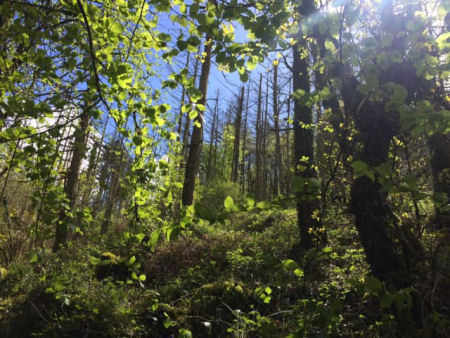 We have ten acres of woodlands. In the last few years our larch has been threatened by phytophthora, ash dieback is prevalent and micro moths are attacking our horse chestnuts. The climate that yo-yos from drought to heavy rain is placing our trees under stress. Much is made of tree planting schemes, but it takes over a hundred years to establish the biodiversity of an ancient woodland. And what if it doesn’t work?
We have ten acres of woodlands. In the last few years our larch has been threatened by phytophthora, ash dieback is prevalent and micro moths are attacking our horse chestnuts. The climate that yo-yos from drought to heavy rain is placing our trees under stress. Much is made of tree planting schemes, but it takes over a hundred years to establish the biodiversity of an ancient woodland. And what if it doesn’t work?
In the 90’s my parents planted a thirty acre orchard. Normally at harvest time we are plagued by wasps, but this year they were disconcertingly absent. On the 1st August the New Scientist published a study that shows wasps have been shrinking in response to climate change, and proportionately their wings have shrunk fastest of all, leading to problems with flight. What if other insects are responding in a similar way? We know that if our pollinators die, then humans will follow less than four years later.
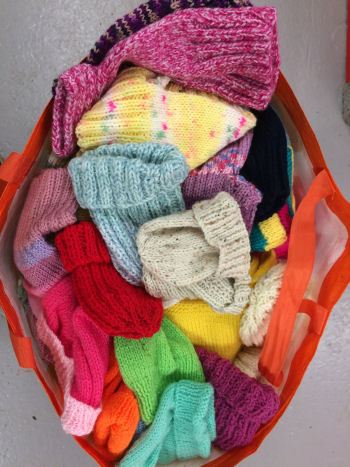 We run a collection point for refugee aid, which is sent to Calais and Greece. Originally we sent containers directly to Syria, but there is no longer a safe passage there. When the charity was established a few years ago it was an emergency response to a crisis. It is now an ongoing project with no end in sight. I believe this just the tip of the iceberg. When rising sea levels submerge islands, with the subsequent loss of homes and farming land, we are likely to experience mass migration and anarchy on a previously unseen level, that will require far than a community collection of nappies and tinned food.
We run a collection point for refugee aid, which is sent to Calais and Greece. Originally we sent containers directly to Syria, but there is no longer a safe passage there. When the charity was established a few years ago it was an emergency response to a crisis. It is now an ongoing project with no end in sight. I believe this just the tip of the iceberg. When rising sea levels submerge islands, with the subsequent loss of homes and farming land, we are likely to experience mass migration and anarchy on a previously unseen level, that will require far than a community collection of nappies and tinned food.
But I despair that none of this is taken seriously at a governmental level.
In Cornwall we've recently seen a huge growth in development. We once had legislation that made it a legal requirement to make all new housing carbon neutral. This legislation was removed and planning regulations on greenfield sites were relaxed in 2015 in a document titled ‘Fixing the foundations - making a more prosperous society.’ This document was designed to increase the coffers of large building firms, despite going directly against the government's promise to reduce carbon. And this is the crux of the problem. All the time we are living within a system that measures success in terms of economic growth we are doomed.
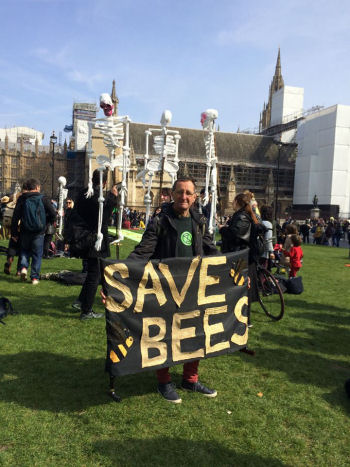 For many years I have been involved in promoting rail travel. I run a sustainable tourism business and am chair of our local Rail Users group. But I despair as our local tourism industry rushes to market Cornwall to America and beyond, while our own populace flies to cheap foreign destinations that are being ruined by over-tourism. Why is it socially acceptable to ignore the carbon cost of flying? Why does no one have the courage to tax aviation fuel, so more sustainable travel options such as travelling by rail, or holidaying more locally, can compete?
For many years I have been involved in promoting rail travel. I run a sustainable tourism business and am chair of our local Rail Users group. But I despair as our local tourism industry rushes to market Cornwall to America and beyond, while our own populace flies to cheap foreign destinations that are being ruined by over-tourism. Why is it socially acceptable to ignore the carbon cost of flying? Why does no one have the courage to tax aviation fuel, so more sustainable travel options such as travelling by rail, or holidaying more locally, can compete?
To summarise, I took part in public disruption in April because I believe we need action now and we need it to be decisive and strong. We need to stop thinking of economic growth and start building ecological growth. To do that we need government help to construct self sufficient local societies. We need a system change that celebrates what we have at our doorstep. We need to change, even though change is painful, because we need our children and grandchildren to be able to live.
I plead guilty to being a part of the system that is causing untold damage to our environment. I need help. We all do. I also plead guilty to sitting in the road at Waterloo Bridge. It was an act of desperation where all else had failed. I know I will have a punishment and request to do local community service, rather than endorsing our economic system by paying a monetary fine.
30th October 19 - Halloween
I like Halloween but I really dislike the way it has become an excuse for selling more disposable tat & individually wrapped plastic wrapped sweets. So for what it’s worth here’s some suggestions...
For treats little apple are good. I make the following bakes which are easy and tasty: simple buns - mix 500g self raising flour, about 200g sugar, 400ml oil, 200ml milk, a teaspoon of vinegar (cider or white wine). Stir. Add to this mix whatever you fancy; chocolate chips, vanilla essence, mixed spice, raisins, lemon rind, marmalade etc. (But not all together!). Spoon into a bun cases (I use the reusable silicone ones, saves having a paper wrapper to dispose of) & cook on a medium heat (about 180) for about 20 minutes & decorate.
Cheese fingers;
Rub in a large knob (about 1-2 oz) local butter into 8oz self raising flour. Add a pinch of salt & mustard (optional) and a big handful or two of grated cheese. Add a beaten egg & enough milk to make a soft dough. Roll out about an inch thick, cut into finger shaped strips, shape so the end is tapered & add a pecan or almond finger nail & some lines on the joints. Bake for about 10-12 mins at about 180C. Serve with a ketchup dip.
15th October 19 - Gifting Seeds
As the evenings are drawing in, it seems the perfect time to do creative indoor things. It also is a time of contemplation. I used to slightly dread the Christmas season; so much waste and expense seems to be generated in the desire to be generous and have a perfect time. I've now realised there is a positive way of approaching the gifting season, that is fun and creative. We now put a limit on spend and either make presents or buy almost exclusively second hand. This might seem a tall order, which is why this article comes in the October issue, as now is the time to start looking in charity shops. We gave and received some fabulous gifts; homemade truffles in cut glass dishes, handmade cushions, and a particular favourite - the somewhat cut throat game of Exploding Kittens. (Now that was a fine charity shop find!).
Another favourite gift has been seeds. Simply put your dried seed heads in a paper bag and let the seeds work their way out. Honesty, Sweet William, wallflowers and poppies are all good for pollinators and easy to grow from seed. It's also time to plant yellow rattle seed in grassy patches to create a wildflower meadow next year. Yellow rattle weakens the grasses to allow native wildflower species to flourish.
This time of mellowness is also the best for eating local. The apple harvest is excellent this year, and marrows and squashes all grow well in this country. A good use of marrow is to stuff it with vegetables and couscous, flavoured with herbs and a stock cube, then bake it in a moderate oven. Delicious.
20th September 19 - A family holiday.
 We took a much needed break in August, and had a thoroughly good time travelling around Europe by train. We even managed to find a train carriage to twin with in Amsterdam! Our journey started in St Germans, then GWR train to London, Eurostar to Amsterdam, where we were delighted to find ourselves in the centre of the Pride weekend celebrations.
We took a much needed break in August, and had a thoroughly good time travelling around Europe by train. We even managed to find a train carriage to twin with in Amsterdam! Our journey started in St Germans, then GWR train to London, Eurostar to Amsterdam, where we were delighted to find ourselves in the centre of the Pride weekend celebrations.
We arrived in Amsterdam by accident. I’d seen a special deal for cheap Eurostar tickets while on a silent film symposium break in London. We had been planning to go to Croatia, so I thought great, I’ll buy those tickets now, failing to refer to a map.
Given that my geography is pretty poor I should have known Amsterdam really is not on the way to Croatia!
In the end it all worked out really well though as a heatwave settled on Europe, so we decided Croatia might be too hot. So instead we went, via a night in Bern, to the eye wateringly expensive town of Zermatt in Switzerland, where we took the extraordinary Gornergrat cog railway to the top of the mountain and swam in glacial melt water pools.
We followed this with a cultural stop in Venice to visit the Art Bienalle, before catching the very good value Thello sleeper train back to Paris. For anyone planning a similar trip, do feel free to call and ask me questions. We bought our tickets in advance from The Train Line and Eurostar, with some expert advice on planning from The Man in Seat 61.
20th July 19 - Community fun.
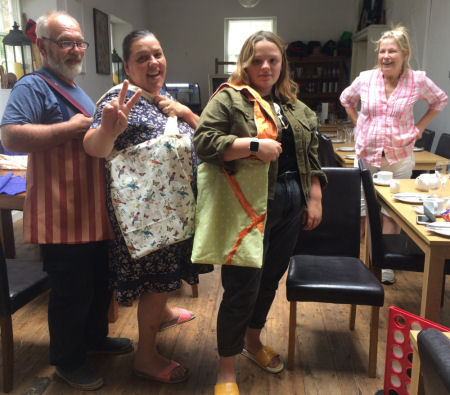 We had a great time making bags with the community at our local cafe/ restaurant/ wine bar Scholars, and there is the photographic proof! Lunch was delicious too.
We had a great time making bags with the community at our local cafe/ restaurant/ wine bar Scholars, and there is the photographic proof! Lunch was delicious too.
We were very grateful to have the expertise of Kim, with her magical interlocking machine. I have to say I knew I was up for a tall order when I organised this event, being naturally hopeless at needlework. But I wanted to show that if I could make a bag, then anyone could. Poppy was also on hand to help, and made a show bag that we used for making our templates. Years of ammassing material, plus some donated on the day, meant we could make a variety of jolly designs. It was great to have a mix of all ages. We all agreed we would like to do it again sometime in the future. Despite the clattering of three machines, there was still plenty of banter!
10th June 19 - Reducing air miles, for leisure, business and food.
The holiday season is upon us, and aren't we lucky to live in Cornwall! For me many of my happiest memories are spending time camping, swimming, barbecuing, cycling and walking with family and friends within a fifty mile radius of home. But there's the weather; it's unpredictable, and not always hot. And experiencing new places is often life enhancing. So how can we do this with minimum impact? The most effective way to be eco friendly is to eschew flying and choose destinations that can be accessed by train or boat.
You may wonder why flying is so damaging. The science is complex, but the problem is that fuel expended in the air is over twice as potent in its warming effect as that on the ground.
Unfortunately price comes into it; there is no tax on aviation fuel, which means flights can be cheaper than trains and buses. If the government is serious about climate change this is something that does need to be tackled.
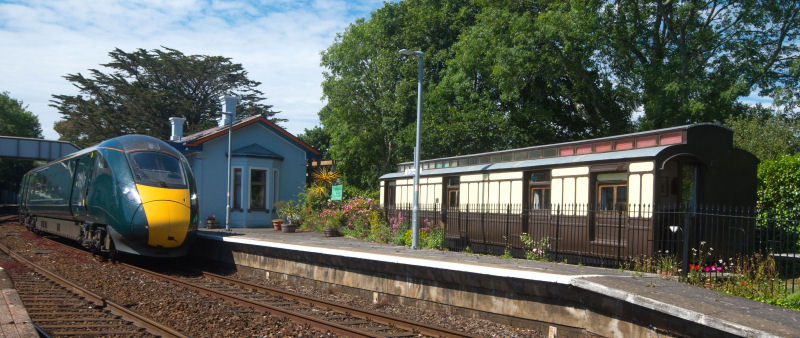
If you prioritise your spending on more sustainable travel, then you will find the journey becomes a big part of the holiday. And it needn't be a headache. An excellent site to visit is The Man in Seat 61. Here you will find everything you need to plan train travel in Europe and beyond. You can also buy bus and train tickets from Loco2. And if you enjoy a cruise, Brittany ferries run from Plymouth to both Spain and France, and offer package holiday deals if you would like everything organised. Buses are often a good way to get by when abroad, especially in further flung places where train travel can be slow.
If you do really need to fly, try to make your stay a worthwhile length. Jetting to Barcelona for the day or Prague for a weekend should not be considered acceptable in any society that values its long term survival. Low cost airlines are usually greener than more expensive ones, as each flight carries more passengers for the space.
Another culprit in the equation is air freighted foods. Food tastes so much better when it's local and in season. Ship freighted foods such as bananas have far lower carbon footprints than soft fruits and perishables that are flown over. Think before you buy; not only will it help save the planet, you may well save money too.
26th May 19
Railholiday declare a climate emergency
 After encouraging our councils to declare a climate emergency, it seems logical to do so ourselves are a business. This declaration will commit us to carefully consider all we do, and how this relates to our imprint on the environment. Over the next months and years every purchase we make will be evaluated for its impact, and our staff will continued to be encouraged to be involved with community projects and other earth positive actions. One of my first pledges has been to spread the word by writing for the parish magazine, which will be republished on this page. Thank you to Matt of Leap for the logo.
After encouraging our councils to declare a climate emergency, it seems logical to do so ourselves are a business. This declaration will commit us to carefully consider all we do, and how this relates to our imprint on the environment. Over the next months and years every purchase we make will be evaluated for its impact, and our staff will continued to be encouraged to be involved with community projects and other earth positive actions. One of my first pledges has been to spread the word by writing for the parish magazine, which will be republished on this page. Thank you to Matt of Leap for the logo.
12th May 19 - Differentiating between Need and Want
 While in London a few weeks ago I saw a placard that read “What’s the point of having everything we want, when we don’t have what we need, like the air that we breathe.” This gave me food for thought; our biggest problem is that we are currently consuming more than our earth can provide and the lines between what we need and what we want have become blurred.
While in London a few weeks ago I saw a placard that read “What’s the point of having everything we want, when we don’t have what we need, like the air that we breathe.” This gave me food for thought; our biggest problem is that we are currently consuming more than our earth can provide and the lines between what we need and what we want have become blurred.
So what can we do?
The first point to consider is that almost everything we spend money on will have a carbon footprint. So reduce is the key message here; ask before you buy, do I need this, or do I just want it? And if the later is the case, what is the environmental impact?
Can you get what you want second hand? Never has it been easier to acquire used items; try Freecycle or Freegle. Both of these sites offer unwanted items for free. Alternatively Ebay and Gum Tree are just two places that offer second hand items for sale. On the high street there are many charity shops specialising in clothes, books, furniture and other household items.
Can you repair what you have? Remember any new item has a carbon cost in its production, so continuing to use something inefficient is usually greener than buying new. Repair cafes are becoming popular; a community day of people exchanging trades. The most successful I know of is in Falmouth on the first Sunday of the month. Perhaps this is something we could aspire to in our own community?
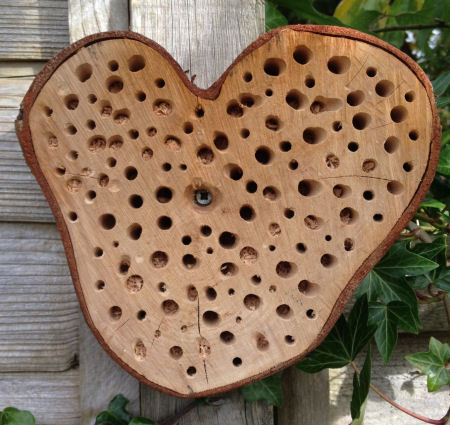 If you must buy new, can the item you need be made or sourced locally? Always buy the best quality you can afford, for longevity.
If you must buy new, can the item you need be made or sourced locally? Always buy the best quality you can afford, for longevity.
When it comes to waste, if the council cannot recycle something, you may be able to find someone who can through Terracycle.com.
Did you know the council will recycle clothes too worn to donate to charity shops? Simply place your rag in a tied bag in the black bottle box.
We've moved to reusable bags for our shopping. However new cotton bags have a surprisingly high carbon footprint. So I'll be running a bag making workshop for all on Thursday 11th July at Scholars from 11am until late afternoon. I've got lots of material, but do feel free to bring your own if you want to. Free of charge and all welcome.
Top tip – feeling cold? Don't turn up the heater. Put on a jumper!
10th April 19
On April the 8th I pledged to go single use plastic free for the day. It was surprisingly challenging! Here's how I fared.
At breakfast time I opted for porridge, with turmeric, honey and ginger. I would normally have raisins too, but these come in plastic. My usual tea was out of bounds as the box we buy has a cellophane wrapping, but I did have some Rooibosh. I had to hope there was no plastic in the teabag itself. I couldn't have oat milk so drank it black. However I was able to have ordinary milk from our milkman on my porridge. Although in a glass bottle Dad's homemade apple juice has a plastic top, so I had to boycott that. It did however make me think I should look into alternatives for Dad for the coming season.
I cleaned Millpool. We use cleaning products bought in bulk, many of which need to be watered down. The containers are refilled. However the 5 litre concentrate and soap containers are plastic, which generally are not reused, although they do get recycled. The flowers we use are cut fresh from the garden, so plastic is never a problem with these.
The pledge was a good excuse not to have any chocolate biscuits at crib time. Lunch was a little tricky, but I did have some home-made houmous, some salad left over from a friend's party at the weekend, and boiled eggs, as well as a cake bought from a stall at Hayle on Saturday that was wrapped in tin foil. I did wonder how far I should take it. Could I have humous when the bottle of lemon juice I used has a plastic top, as does the lid of the Tahini paste? Should I boycott brushing my teeth? (I decided against this).
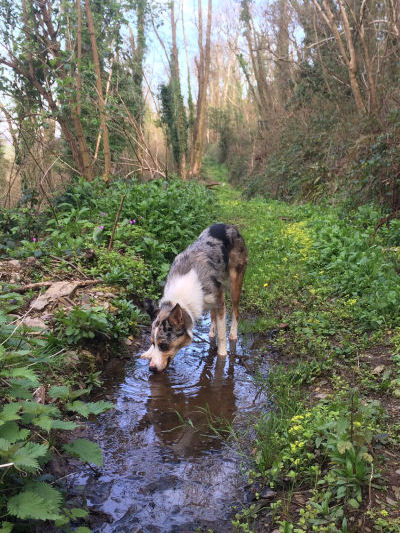 A friend had given me some delicious flapjacks made with bananas on Sunday, so I snacked on these liberally through the day.
A friend had given me some delicious flapjacks made with bananas on Sunday, so I snacked on these liberally through the day.
After lunch I was inspired to finally contact Keveral Farm to order a regular large box of vegetables.
I had my evening meal sorted in my head; yesterday's nut roast was made of items in jars (tahini, peanut butter), items bought loose in bulk (walnuts) bread in a reusable bag and unwrapped sweet potatoes. I would have an accompaniment of homemade quince and chilli chutney and leftover party spinach. However matters were taken out of my hands when I got in after walking Django (Dad's dog who is on sleepover) as Poppy had made tea. I had a choice; say yes to the deliciously steamy pot of vegan mince and pasta, both of which had come from single use plastic packets, or make my own meal. Okay. I failed. We finished with Sunday's homemade gooseberry crumble, which would have been plastic free had I used butter rather than sunflower oil.
My failed attempt to go single use plastic free was a useful experiment, and it certainly has left me pondering over ways I could reduce what we use. And I'm looking forward to enjoying a weekly box of organic vegetables in the future.
Articles (in date order): Parish Councils Declare A Climate Emergency | Shopping Locally | Cornwall Council Declare A Climate Emergency | Green Tips | Snowdrops | A First Article for The Nut Tree Magazine | Activism | On Apples | Railholiday Open Day | The Beginnings of a Snowdrop Walk | Remembering Frankie Lister | Business Membership of the Wildlife Trust | New Art for Harvey | Leaf Mould | Meadowland | A Flower A Day | Wildflower Hedges | A Plant Share Day | Tree Champions | Golanthaphilia | Wilding Our Gardens | Early Summer Musings | Flower Arranging | On Soil | Bug Hotels | On Autumn | A Recipe for Elderflower Champagne | Older articles...
5th April 19
It's been really wonderful to see our parish councils leading the way in declaring a climate emergency. Collectively their declarations will mean a greener, cleaner future for all of us.
And there are many ways we can support our councils. One of the most important things for wildlife is to have corridors; places where they can move freely from one haven to the next. This means long grass, pollinator friendly plants, a mix of trees, shrubs and bushes, water and food all year round. Can you make your garden a wildlife haven?
Importantly this also means using no sprays. Nature has a great way of balancing itself, given time. Ladybirds will eat aphids, birds will tackle snails, frogs will eat slugs. Areas of long grass will provide cover for small mammals, and in turn attract owls. A small hole in your garden fence will give hedgehogs the ability to extend their territory and a log pile will provide them with shelter.
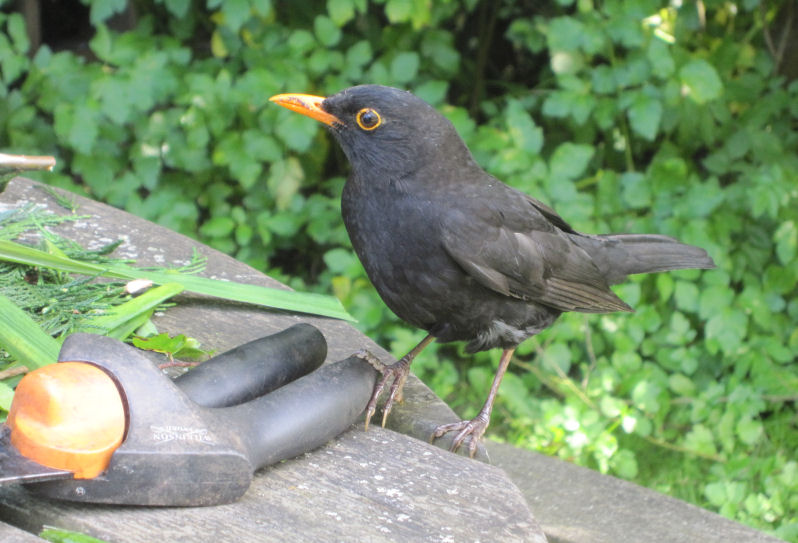
Now that our parishes have declared a climate emergency, we can look forward to longer grass verges, and all the additional interesting wildlife that comes with it; moths, butterflies, dragonflies, hoverflies, frog hoppers. Take a magnifying glass and sit for a while, you'll be amazed at what you see.
The living graveyards project is a fine example of what happens when nature is left to its own devices. I was at Hessenford churchyard last spring and felt overcome with how beautiful it was; filled with primroses, campions, bluebells and many other wild flowers.
So let's embrace the wild, take time to enjoy slow things, of which we are enormously blessed in this area; the sea, streams, rivers, beaches, and all the many life forms with which we are lucky enough to share our planet with.
On a tangent (and I make no apologies for repetition on this one), there is little better way of saving the planet than staying local. The less money spent, the less miles travelled, the smaller our carbon footprint becomes. Spending money within your community will keep it vibrant; slower forms of travel, such as walking and cycling, have the added bonus of lots of social interaction along the way.
And a big thank you to Deviock and St Germans councils for all the great work they do.
26th February 19
Last month I extolled the joys of planting trees, and it is still the season. Trees can be planted until their leaves start to come out in early April. Plant a little late and they may need slightly more nurturing in terms of water.
This month my focus is on local. Buying local is one of the easiest and most effective ways to reduce your carbon footprint.
One of the biggest problems is that we live in a system where success is measured by economic growth, and it's almost impossible to spend money without impacting on the environment . However we as consumers do have power to drive change. By buying local you can support local farmers, encourage food production that is beneficial and give a better quality of employment. By using local labour you are likely to have a network of tradespeople to call when you have a crisis.
We are very lucky in our parish to have a number of shops. This was especially handy when the snow came a few weeks ago. However in order to stay viable, they do need to be supported.
Although the bottom line price may seem cheaper, supermarkets are cleverly designed to assist us to part with our money. You may only intend to buy a pint of milk, but suddenly you find ten other things in the basket. A supermarket will employ one hour of staff time for every £200 spent. For a local shop it is £40. It is easy not to count the cost of time and fuel in getting to a supermarket.
Shopping locally is social. You will meet people, and people will be glad to see you. You can start to have a say in what is stocked, and if some exotic ingredient is required, then usually it can be sourced as a special order.
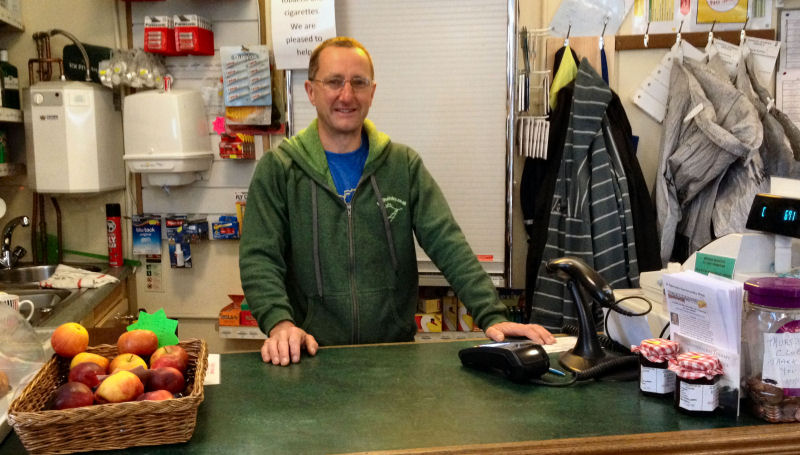
There's also the opportunity to volunteer in St Germans and Crafthole. We take it in turns to volunteer in St Germans shop on Sunday and it's great fun to play shopkeeper, which can involve giving tips on local practicalities, or the best recipe for soups and cakes, as well as catching up with friends old and new.
Tips for plastic free shopping: Take your own tupperware containers for meat and fish, net bags for vegetables and fruit. Choose unwrapped vegetables or order a weekly organic veg box from Keveral. Keep foldaway bags in your handbag and car, buy a reusable water bottle and a reusable mug for hot drinks. Have a litter bag to hand when you go to the beach or for a walk in the country. If you're on Twitter use the hash tag #TwoMinuteBeachClean.
Finally don't forget: switch to 100% renewable energy if you haven't already done so. Good Energy and Octopus Energy are worth a look.
27th January 19
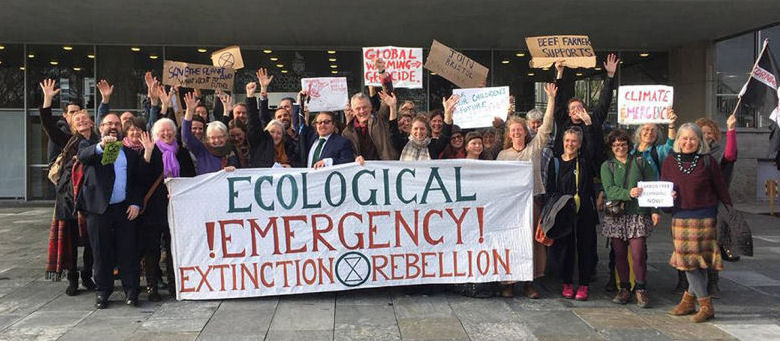
I had the priviledge on Tuesday of being there when Cornwall Council declared a Climate Emergency Declaration. It was inspirational to see councillors of all colours working together on something they all felt passionate about; our environment. But it is Cornwall, so I guess it seems logical to lead the way, as our natural beauty is something we are very proud of. We have decided as Railholiday to also declare a climate emergency, as we feel it will help us focus our efforts on continually looking at ways in which we can improve our carbon footprint - and that can only be a good thing. One of our pledges has been to write a regular article in our parish newsletter with simple ideas that can be carried out at home. My first article is on the 16th December blog. My second is below.
16th January 19
Green Tips for January
In last month's Green Tips I commented about Climate Change. Here are a few more suggestions for things you can do to help.
Tree and hedge planting. One of the most important protectors of the planet are trees. Not only do they absorb carbon from the atmosphere, but in heavy floods they also help reduce soil erosion. The UK has only 8% of tree cover, compared to 35% in mainland Europe.
Tree planting can be done any time until early April. Easy to grow and of good wildlife value are oaks, limes, willow, birch, cherry, apples, rowan and beech. Of course we don't all have space to plant trees, so a good alternative is to have others plant them for you. Becoming a member of the Cornwall Wildlife Trust or Woodland Trust will support the work they do.
Equally valuable to tree planting and something most of us can do, is to replace fences with wildlife hedges. These can make a most attractive garden border. Plant a wildlife mix of blackthorn, hawthorn, guelder rose, hazel, field maple, crab apple, wild cherry and dog rose and in years to come you can enjoy birds feasting on the fruits of your labours.
Want to green your web use? Switch to the search engine Ecosia. It works really well and uses its profits to plant trees. 46 million so far!
Finally some low carbon food tips from Mike Berners-Lee's excellent book How Bad Are Bananas?
“Eat what you buy. Ask people how much they'd like before you serve them. Eat the skins, clean the plates, pick the carcass, save the leftovers. Check what needs eating when you plan your menus. Keep vegetables in the fridge if you can. Rotate the contents of your cupboards so the old stuff is at the front. Eradicating waste is worth a 25% carbon saving for the average shopper.”
For further reading, visit Sustainable Food Trust
7th January 19
The snowdrops are coming out! We are very excited to see them, and this year they promise to be even more exciting as our new varieties become established. And we have beautiful handmade signs to accompany them, made by Dave.
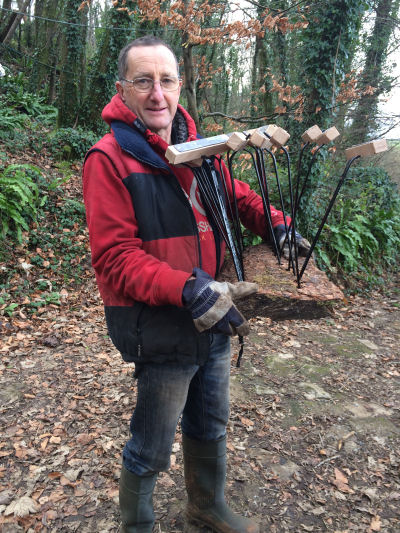
We've named the Cuttivett snowdrops Penelope, in memory of our loving but rather scatty cat.
We also have other varieties of native snowdrops, that are all subtly different, that come from different places. Most of them are named after the friends that have donated them, or memories of people we have associated with those places. Hence we have Heathcote (Penimble), Jago and Peregrine (Port Eliot), Emma West the elder (Higherland), the Ceramacist (Luckett) Molly Shannon (Broadmoor Farm) and Great Uncle John (Leominster).
Other named varieties of single snowdrops include Captain James Blackhouse, Sam Arnott and the galanthus elwesii Cedric’s Prolific.
Among the more unusual snowdrops is Frankie Lister, named after my mother, a tall, green tipped snowdrop. Then there are a few flora plena double snowdrops; a particularly short variety we’ve called Jean and Henry, from Coldrenick, near Menheniot, and one named after my grandmother Molly Shannon, that comes from Broadmoor Farm. Other traditional nivalis snowdrops include Lily Lanyon from Trerulefoot, Lilyman’s Pound, and Dave and Pat, from Pound Farm, Yelverton. Other doubles are the Greatorex varieties Ophelia, Cordelia, Hippolyta and Desdemona. Lastly are Merlin and Trym, which may or may not come up this year, as last year they seemed to have been eated by something during the snowy period.
There are also a couple of parties going on in the woods. In two places several varieties dance together. Most notable is the Boogie Round, which is for snowdrops who late in the season finally poke their heads above the ivy. I don't expect to see much until mid February in this area, but am hoping this year there will be a good show. I have not yet bought any snowdrops to add to the collection this year, but high on my list is Magnet, Galatea, Washfield Warham and Lady Beatrice Stanley.
For us snowdrop season starts now and continues until early March. Do come and see for yourself. We are offering short breaks from two days, and last year these were very popular in the peak snowdrop season. And if you would like to bring a new variety to add to the mix, we would be delighted, and very happy to do a swap.
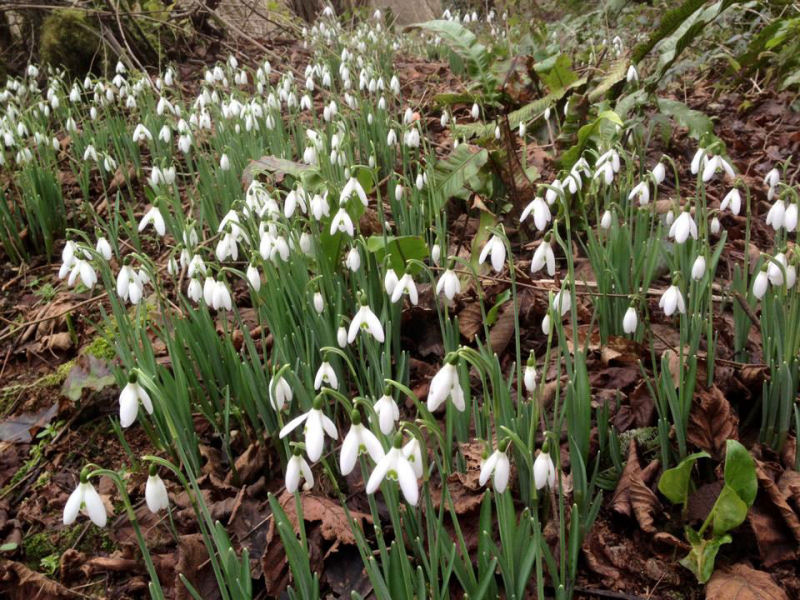
16th December 18
This month has seen my taking on a regular commitment to writing a green blog for our parish council newsletter, which I will also be replicating on this page, thus killing two birds with one stone, if you’ll pardon the rather gruesome proverb. Below are the key points from my first article, with a big thanks to Manda Brookman of Cafe Disruptif, as it has very heavily borrowed from one of Manda’s excellent leaflets.
Climate Emergency
Green Tips for December 2018
Many of you may have read the latest news about climate change, and it makes depressing reading. The Intergovernmental Panel on Climate Change said in the last few weeks that "Limiting global warming to 1.5 degrees centigrade will require rapid, far reaching and unprecedented changes in all aspects of society."
Reading this may give a feeling of hopelessness, but together we can make a positive difference. We can make our own changes, talk to others and make a big noise at big companies, our politicians and the businesses we use. Let's lead the way! Here are five actions to begin.
1. Switch to renewable energy providers and green your commute - walk or cycle if you can, use public transport or car share if you can't. We are lucky to have train stations in St Germans and Hayle, and buses through both parishes.There are timetables in each of the carriages.
2. Buy local food and buy more local vegetables - especially if they're grown in a good way, without chemicals (all of which use fossil fuels). Support your local small shops and not only are you doing your bit, but also keeping your money in the local economy.
3. Don't throw any food away! We waste so much - give yourself the challenge to waste nothing.
4. Get informed: start with the Friends of the Earth climate change Page
5. Join the many who are already writing to MPs in Cornwall - and they're replying! And join the Climate Vision Pledge Group: climatevision.co.uk/top-ten-pledges.
Then join the bigger movement! See if you can join a local Extinction Rebellion group, which is a rapidly growing activism group fighting for climate change reversal. Check out their website for more information.
4th December 18
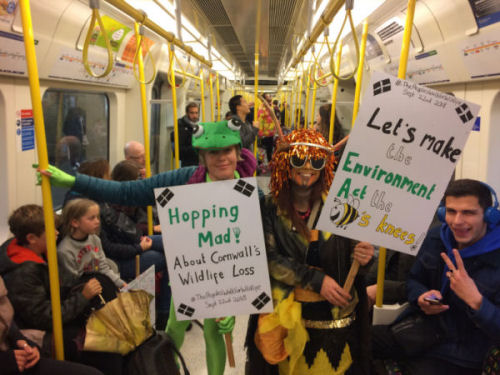 This year has been a year of deep thought, as increasingly signs look like we are failing to reach targets that would protect our wildlife in the future. This concern led to my dressing as a hornet and taking part in Chris Packham’s People Walk for Wildlife in London on the 22nd September.
This year has been a year of deep thought, as increasingly signs look like we are failing to reach targets that would protect our wildlife in the future. This concern led to my dressing as a hornet and taking part in Chris Packham’s People Walk for Wildlife in London on the 22nd September.
It has also sparked concern among others, with some groups forming to take action to try and bring the problem to wider notice. Extinction Rebellion is at the forefront.
The biggest problem is that the environment tends to get buried in short term problems, and we now do really need to sit up and act. So what can we do? A good place to start is to look at the site Project Drawdown, which has some useful suggestions and places different problems in perspective. Important things to do for the environment is worth a read.
For those of use who have failed in the first issue by having children, it seems all the more important we prioritise the other stages, for their future. And how to stay boyant through it all? Do read this excellent article Eco Anxiety and how to manage it.
25th October 18
The community orchard has survived remarkably well despite the drought, and produced a few apples. And it has been a bumper year for apples! One of my biggest jobs this autumn is to help my father press apples for his juice business Kerensa Aval, which means loving apple in Cornish.
Mum and Dad planted their orchard in the mid 90s with all types of Cornish varieties of apples. They come into season at different times, so that the harvesting is manageable, as it is spread over three months. The earliest apples, the sweet ones like Pig’s Nose and Pearapple are ready in early September, followed by Queenie and Ben’s Red. My personal favourites are Veitche&s Perfection, Cornish Mother and Cornish Aromatic, all of which are mid season, ripening in October. Cornish Aromatic will hold onto its apples right through to April, so is great for feeding the blackbirds. Right at the end of the season, ripening as late as November, is Tommy Knight, as small but delicious apple. The later apples keep well, so we box them up and they will last until late April the next year. Some trees, like Pendragon, with its burgundy leaves, cerise flowers and apple flesh that is almost purple, are grown for novelty and attractiveness, as they do not produce a large yield. Other apples like King Baird, will produce impressive sized fruit, which can be stewed and eaten throughout the year. One way or another, we are never short of apples!
The apple juice we press is part of our visitor welcome pack, so you can’t get much more local than that.
Railholiday open day 2018 from Railholiday on Vimeo.
8th April 18
Since writing my last blog. We have had a successful open day, which saw the sharing of pollinator friendly plants, and earlier this year planted a community orchard. We had a lovely time in March when we opened
our doors to celebrate the completion of Millpool.
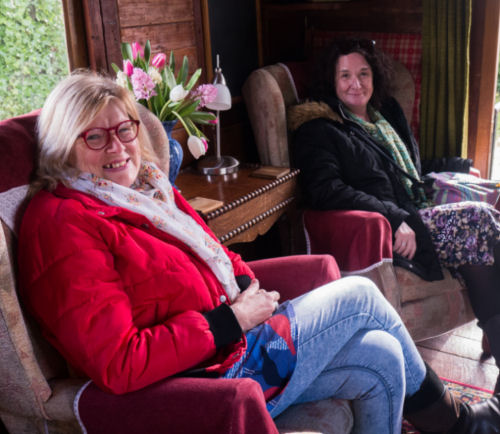 Oxana of Snakistan, Penzance, did a
fabulous cooking workshop on the food of the
great silk road, Dad brought along apple juice,
we had a plant swap stand, history exhibition
and Hessenford WI very kindly served
homemade cakes, pasties and drinks.
Oxana of Snakistan, Penzance, did a
fabulous cooking workshop on the food of the
great silk road, Dad brought along apple juice,
we had a plant swap stand, history exhibition
and Hessenford WI very kindly served
homemade cakes, pasties and drinks.
The day
was filmed by Plymouth College of Art student
Bernard, and can be seen on our Vimeo page;
simply search for Railholiday. A big thanks
to all those who helped and all who came.
30th January 2018
To me the best thing about planting is that each year gets better and better. This is certainly true of our snowdrops, which are becoming very well established in the woods now.
Some of the snowdrops arrived voluntarily; these common snowdrops (galanthus nivalis) I discovered by chance two years ago while clearing a derelict old track of brambles. This was the inspiration for creating a snowdrop trail.
Since then I have been delighted to have acquired more in a variety of manners; mostly from friend’s gardens (nivalis and flora plena varieties), but I also purchased four species snowdrops from Beth Chatto Gardens last year. I am pleased to say that these snowdrops (Ophelia, Cedric’s Prolific, Dionysus and Captain James Blackhouse) are all doing well. I intend to add to the varieties in March, when the flowering season is over, as this is the best time to plant snowdrops.
In the meantime Dave has made a lovely arch and begun some steps down to the new snowdrop walk. It has been a learning process for me too. I have discovered I will need to strim and clear before the snowdrops start to appear for best effect! So November this year will be busy - the perfect excuse not to spend the winter office bound.
1st November 2017 - Remembering Frankie
Throughout the year I have been mulling over all kinds of entry to this blog, but one way or another they have not made it onto the page. The reasons have been many; supporting Walter through A levels and getting another carriage up and running have been part of this, but also this year the rug was pulled from our feet when my much loved, super fit and always inspirational Mum suddenly became ill and died.
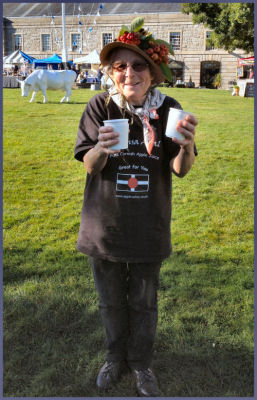 Mum, Frankie Lister, was a force to be reckoned with. Despite starting life with no background in farming, as a farmer’s wife she threw herself into learning with gusto. Always accompanied by a plethora of animals; chickens, geese, dogs, cats and various unridable quadrapeds (not to mention five small children), Mum also kept bees and grew vegetables and fruit.
Mum, Frankie Lister, was a force to be reckoned with. Despite starting life with no background in farming, as a farmer’s wife she threw herself into learning with gusto. Always accompanied by a plethora of animals; chickens, geese, dogs, cats and various unridable quadrapeds (not to mention five small children), Mum also kept bees and grew vegetables and fruit.
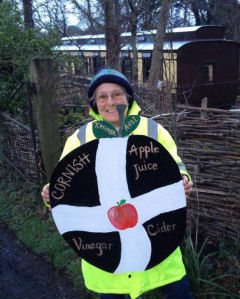 In 1990 she stepped down from her job as secondary school maths teacher and became a wildlife conservation advisor, firstly for FWAG, then later independently. In the mid 1990’s she and my father, Tony, bought about 30 acres of land at Cuttivett, near Landrake, where they planted an orchard of Cornish varieties of apple trees, bred Dexter cattle, created a network of wildlife ponds, and also established a plantation of walnut and cobnut trees, with everything managed for optimum wildlife benefit. They got a grant and bought bottling and pressing equipment from Vigo and set up an apple juice business called Karensa Aval (Cornish for loving apple), going on to make cider, cider vinegar and pickled walnuts as well as their organically grown Cornish apple juice.
In 1990 she stepped down from her job as secondary school maths teacher and became a wildlife conservation advisor, firstly for FWAG, then later independently. In the mid 1990’s she and my father, Tony, bought about 30 acres of land at Cuttivett, near Landrake, where they planted an orchard of Cornish varieties of apple trees, bred Dexter cattle, created a network of wildlife ponds, and also established a plantation of walnut and cobnut trees, with everything managed for optimum wildlife benefit. They got a grant and bought bottling and pressing equipment from Vigo and set up an apple juice business called Karensa Aval (Cornish for loving apple), going on to make cider, cider vinegar and pickled walnuts as well as their organically grown Cornish apple juice.
Throughout our journey Mum has been there offering advice and support.
I think there can be few better ways of honouring a really special life than by continuing the lessons we have been taught: yesterday I planted over 600 crocus and hyacinth bulbs at Cuttivett so the bees Mum loved so much will have early nectar. When I stopped for a break I sat by the largest pond watching two types of dragonflies and a hornet and understood; Mum and Dad will always live on in the landscape they have created.
I don’t think anything ever prepares you for the loss of a loved one, but keeping Mum’s passion for all things living seems a positive way of moving forward. I guess it’s my time to pick up the gauntlet.
30th January 2017 - A talk for the Cornwall Wildlife Trust.
I was lucky last week to be invited to talk at the Cornwall Wildlife Trust’s Wild Business Event. I discussed the merits of environmental growth and how it can help a business to be successful. So I thought I would share my tips below...
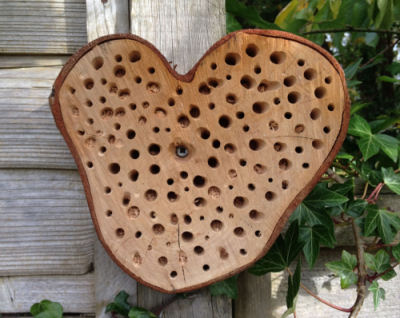 1. Work out what you can do simply and easily with what you already have. Environmental growth needn't be expensive. Ask friends for plants, establish a relationship with your local nursery, who will be able to advise on what to plant where, thus saving money in the long run.
1. Work out what you can do simply and easily with what you already have. Environmental growth needn't be expensive. Ask friends for plants, establish a relationship with your local nursery, who will be able to advise on what to plant where, thus saving money in the long run.
2. Use your environmental growth as a tool of communication on social media platforms; show pictures of insects, birds, flowers. These are always popular.
3. Find others in your local area who also are interested in environmental growth and work collaboratively.
4. Shout about what you're doing. Write newsletters, run a blog, talk to clients. Think communication and be proud.
5. Don't be scared to steal other people's ideas and adjust them to suit your own situation, but everyone likes an acknowledgement and always offer thanks where due.
6. Use your own images! It is easy to get carried away and find images on the internet to suit your purpose, but it is easy, as we discovered, to find yourself on the wrong side of copyright laws. Make sure you have permission for any images you use.
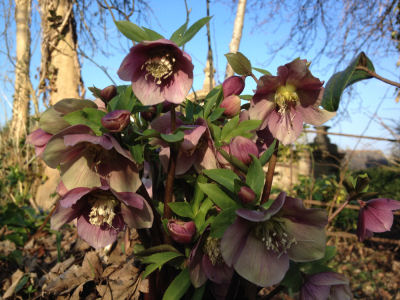
7. Think about which areas you need to improve in your business. Do you want year round tourism or are you shut during winter? Where can you add environmental gain that will give greatest benefit to your visitors or staff? Can you use the by product of environmental growth (eg flowers) as an added value to what you offer?
8. Be ambitious. Sometimes a risk can pay off. But always work within your financial restraints.
9. Join wildlife trust groups and other environmentally responsible organisations who will be able to give guidance. Follow them on Twitter and other social media platforms so you keep on top of the latest environmental thinking.
With the winter coming up, I’ve been packing seeds to send as Christmas presents. Another job that needed doing was a painted panel for the toilet in Harvey, so as a way of saving time, I combined the two to make a wildlife painting, all about bees. It was such good fun making it, I thought I would share it below. All the flowers on the panel are pollinator friendly. There is plenty of writing, so I have included quite a large picture here, but if you would like to see it in greater detail, simply click on the image.
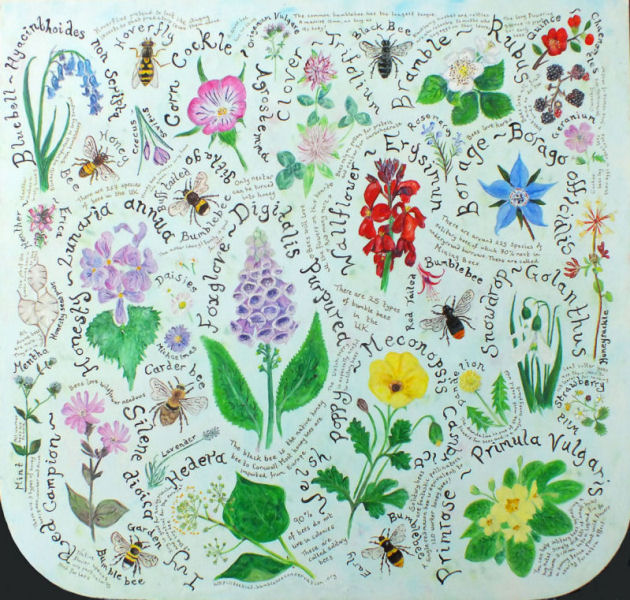
October 28th 2016 - Leaf Mould
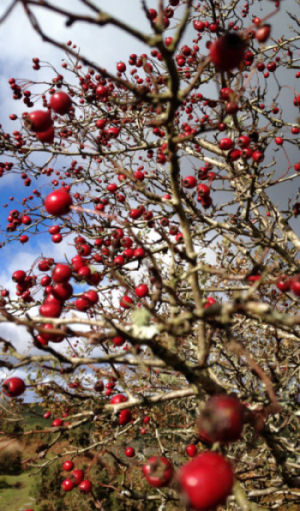 There are few things I love more than kicking through big piles of leaves, and in the last few years these leaves have felt like a real gift.
There are few things I love more than kicking through big piles of leaves, and in the last few years these leaves have felt like a real gift.
In Cornwall we have acidic soil that camellias and other ericaceous plants love. They also need feeding and mulching, and this is something that well rotted leaf mould is great for. It can be spread over beds to enrich soil and adds health to the garden. There are some places where it is appropriate simply to rake the leaves over the beds and leave nature to get on with it, but mostly we collect the leaves.
It is very easy to make a leaf mould container; just wrap some chicken wire around four poles to make a large open bin and let weather and time do the rest. Ideally then the leaves should be left for a year (or better still two) before being used. For this reason I have several bins tucked away in corners of the garden where they can be forgotten.
While spreading the leaf mould and seeing the birds go mad over the invertibrates and worms that inevitably make their home among the leaves, it made me think; how do we feed the birds when we are not around to put out seed and fatballs? This is something that has occupied me for a while, so we have put in wildlife hedges around our sites.
Few trees to me seem better than the humble hawthorn; beautiful in spring and bees love it, then an abundance of tasty haws in the autumn. They are happy to grow anywhere too. This is one self seeding shrub that we welcome into our gardens with open arms.
August 25th 2016 - Wildflower meadows.
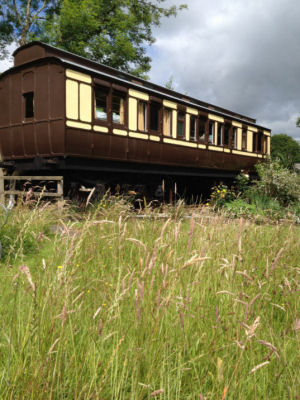 This year, as a continued plan for environmental growth, we’ve created a meadow outside Mevy, which has, for the most part, been rather successful. The long grass attracted lots of butterflies and we were delighted with the number of plant species that were inherently in the lawn. Lots of clover and plantain, a little ladies smock and other flowering plants.
This year, as a continued plan for environmental growth, we’ve created a meadow outside Mevy, which has, for the most part, been rather successful. The long grass attracted lots of butterflies and we were delighted with the number of plant species that were inherently in the lawn. Lots of clover and plantain, a little ladies smock and other flowering plants.
Disappointingly the yellow rattle I planted in autumn had failed to germinate, and the dog daisies haven't yet got established, but I am confident next year will see the diversity increase. I've collected seeds from hedgerows, which I will be scattering over the next few weeks; so would very much hope next year we will have scabious, knap weed, vetch and more.We cut the grass last week, but are going to continue to allow the back of the plot to be long, as shelter for small mammals, while the front will be kept shorter for the spring crocus bulbs to flourish.
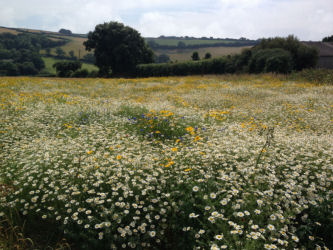 Our meadow has a very different look from that of a friends, with whom I planned a meadow on a grander scale in the corner of a stony field. This was firstly ploughed and then planted with a meadow seed mix, including various chamomiles and cornflowers. A few wild poppies have sneaked their way in, but essentially at the moment it is a fairly white, yellow and blue mix. I think you will agree from the photographic evidence from last week that it looks splendid, even in this first year. Looking forward to seeing how it develops...
Our meadow has a very different look from that of a friends, with whom I planned a meadow on a grander scale in the corner of a stony field. This was firstly ploughed and then planted with a meadow seed mix, including various chamomiles and cornflowers. A few wild poppies have sneaked their way in, but essentially at the moment it is a fairly white, yellow and blue mix. I think you will agree from the photographic evidence from last week that it looks splendid, even in this first year. Looking forward to seeing how it develops...
June 2nd 2016 - Learning from others about planting for wildlife.
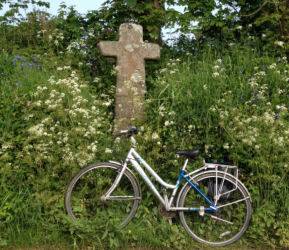 Last year I went to one of the most inspiring places I have ever visited for wildlife. Lethytep, near Lanreath, is 52 acres of vast wildflower meadows, ponds, woodlands, all designed to give the greatest benefit to wildlife. Lethytep is opening in aid of the Cornwall Wildlife Trust on the 26th June and I would highly recommend a visit if you can.
Last year I went to one of the most inspiring places I have ever visited for wildlife. Lethytep, near Lanreath, is 52 acres of vast wildflower meadows, ponds, woodlands, all designed to give the greatest benefit to wildlife. Lethytep is opening in aid of the Cornwall Wildlife Trust on the 26th June and I would highly recommend a visit if you can.
The hedgerows are peaking with cow parsley, campions, buttercups, bluebells, stitchwort, honeysuckle and vetch all vying for attention. I like to get out on my bike at this time of year, as it is a great way to appreciate the beauty of the area.
Looking closely into the hedges also leads to surprises; wild orchids and even ocassionally some rare Bastard Balm. Traditionally Bastard Balm was used as a diuretic, blood purifier, astringent, for wound healing, and as a sedative. It also has anti spasmodic properties, but is such a rare treat it should always be left undisturbed and unpicked.
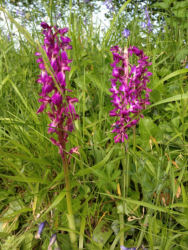 The advantage of seeing hedges from a bicycle is that it is then easy to spot when plants are running to seed. This year I shall be collecting native bluebell seeds to broadcast around the woods (these will come from the bluebell glade at the end of the woods, thus ensuring I have the most natural varient of bluebells). I've also noted where there are large numbers of orchids, which I'll scatter into our patch of meadow in front of Mevy. Orchids should always be undisturbed, and I shall be careful to only take a few seeds from each plant, to ensure lineage continues.
The advantage of seeing hedges from a bicycle is that it is then easy to spot when plants are running to seed. This year I shall be collecting native bluebell seeds to broadcast around the woods (these will come from the bluebell glade at the end of the woods, thus ensuring I have the most natural varient of bluebells). I've also noted where there are large numbers of orchids, which I'll scatter into our patch of meadow in front of Mevy. Orchids should always be undisturbed, and I shall be careful to only take a few seeds from each plant, to ensure lineage continues.
Finally it is Chelsea Chop time; when autumn flowering plants like sedums are pruned to encourage later flowering and bushy plants. I have stuck all my sedum cuttings into soil, after taking the lower leaves off first, so in theory may well have in excess of fifty new plants to give away later in the year. Let me know if you would like one! I've left the tops on some and pinched out the growing tips of others, so will be interested to see which do best.
May 10th 2016 - A flower for every day of the year
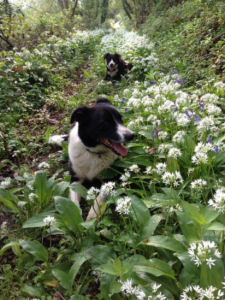 What a lot of time has elapsed since writing. This is not because I have been idle, but have been spending time creating another wildlife facility on Pinterest. Last year I decided it would be a good idea to profile a different plant in flower for each day of the year and chose to host this on our Pinterest page, where it can be shared easily. You can see my journal for the first three months here. At this time of the year the job becomes much easier and I'm faced with a choice of new flowers, as more and more open each day as we head to peak flower time in June.
What a lot of time has elapsed since writing. This is not because I have been idle, but have been spending time creating another wildlife facility on Pinterest. Last year I decided it would be a good idea to profile a different plant in flower for each day of the year and chose to host this on our Pinterest page, where it can be shared easily. You can see my journal for the first three months here. At this time of the year the job becomes much easier and I'm faced with a choice of new flowers, as more and more open each day as we head to peak flower time in June.
Another joy of this time of year is nettle tops, sorrell and wild garlic. These make a great soup when combined with potatoes, salt, pepper and a stock cube if you want it. Alternatively nettles and garlic are a good accompaniment to feta cheese and pine nuts when wrapped in pastry and sprinkled with a little nutmeg.
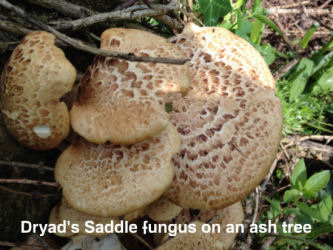 The hedges are filled with edible delights at this time of year, and some of course that are not so edible; Dog's Mercury, Cuckoo Pint (Lords and Ladies, Jack’s in the Green), Foxgloves etc are poisonous, but the latter two hold a dear place in my childhood memories; writing on the back of our hands with the stamen, and wearing foxgloved fingers. Hence the strict requirement to always wash our hands before eating!
The hedges are filled with edible delights at this time of year, and some of course that are not so edible; Dog's Mercury, Cuckoo Pint (Lords and Ladies, Jack’s in the Green), Foxgloves etc are poisonous, but the latter two hold a dear place in my childhood memories; writing on the back of our hands with the stamen, and wearing foxgloved fingers. Hence the strict requirement to always wash our hands before eating!
Thanks to Reddish Vale Country Park for the following information about Cuckoo Pint; "The Cuckoo Pint has an interesting way of being pollinated, flies can go into a hidden chamber in the flower, but an arrangement of hairs prevents them from flying out again. However this is not meant to be a death trap, but a simple way to ensure that the insects stay for the night to pollinate the flowers. The next day the stamens will mature and shed pollen on the flies. This process results in the withering of the hairs and the insects are free once more to fly off to find another similar hotel room for the night. Later on in the year, all that remains of the plant is the fruiting stalk with bright orange-red berries. These berries are very poisonous to people and can result in death if eaten." A sobering thought indeed!
January 6th 2016
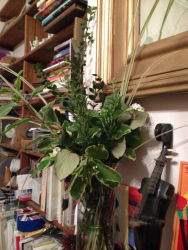 Now we're formally in the depths of winter (and what a mild, wild and wet one this year is turning out to be), it may seem that fresh flowers would be hard to find. However a turn around the garden shows lots of things flower at this time of year; rosemary, dwarf comfrey, daphne, bergenia, vincas, hellebores, quince, candy tuft, primulas, lungwort, viburnum tinus, winter honeysuckle, wintersweet, grape hyacinths, crocuses, mahonia, to name but a few. Many of these are good for our bees, which with the mild weather are flying out of season and need all the help they can get to return to their hives. The first of the snowdrops are out and daffodils are budding up ready to flower in the next couple of weeks too.
Now we're formally in the depths of winter (and what a mild, wild and wet one this year is turning out to be), it may seem that fresh flowers would be hard to find. However a turn around the garden shows lots of things flower at this time of year; rosemary, dwarf comfrey, daphne, bergenia, vincas, hellebores, quince, candy tuft, primulas, lungwort, viburnum tinus, winter honeysuckle, wintersweet, grape hyacinths, crocuses, mahonia, to name but a few. Many of these are good for our bees, which with the mild weather are flying out of season and need all the help they can get to return to their hives. The first of the snowdrops are out and daffodils are budding up ready to flower in the next couple of weeks too.
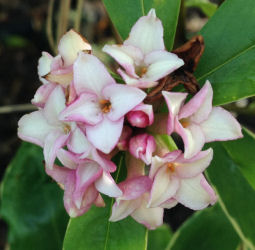 Vases still need to be filled; often winter flower arranging is easier than summer; there really should never be a need to spend money on shop bought flowers. Rather than pick precious pollen providing flowers from the garden, there are some fabulous greenery shrubs that will last for ages in water; rosemary, myrtle, euonymous, lonicera nitida. Add a few sprays of viburnum tinus and the room will smell beautiful. The flower arrangement shown here has lasted nearly a fortnight and still looks good. Red spears of phormium or strands of variegated pampas grass leaf finish the vases with style.
Vases still need to be filled; often winter flower arranging is easier than summer; there really should never be a need to spend money on shop bought flowers. Rather than pick precious pollen providing flowers from the garden, there are some fabulous greenery shrubs that will last for ages in water; rosemary, myrtle, euonymous, lonicera nitida. Add a few sprays of viburnum tinus and the room will smell beautiful. The flower arrangement shown here has lasted nearly a fortnight and still looks good. Red spears of phormium or strands of variegated pampas grass leaf finish the vases with style.
December 8th 2015
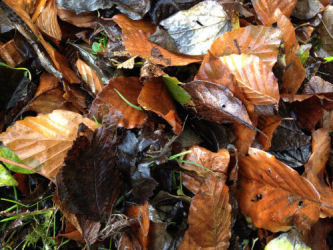 ’Tis the season to be jolly...but also to make leaf mould if you haven’t already done so. Leaf mould is brilliant stuff for feeding the soil, mulching, or adding to compost. It is particularly good for ericaceous plants and each year I feed our camellias with a good thick wadge.
’Tis the season to be jolly...but also to make leaf mould if you haven’t already done so. Leaf mould is brilliant stuff for feeding the soil, mulching, or adding to compost. It is particularly good for ericaceous plants and each year I feed our camellias with a good thick wadge.
We make our own leaf mould stores; it is very easy - all you need is a bit of chicken wire or similar. Form this into a bin shape, fill it with leaves, leave it for a year and allow the worms and rain to do their thing and hey presto you’ll have some lovely rich food. It is a good idea to have two bins; one for this year and one for last. If you don’t have the space, just fill a black bin bag with leaves, punch in a few holes and leave it in a shady corner where you can forget about it. I have not used this method, but the experts at Gardener’s World say it works equally well.
November 12th 2015 - Bug Hotels
Today’s blog is a continuation of Septembers...I have been busy making bug houses, and I think you will agree that my bug people make the perfect presents. So with the rapid marching of December, here is a visual demonstation. 1. Cut out some rings of wood. I use sweet chestnut, because it lasts forever. 2. Draw on your face. 3. Drill out the facial features with different sized drill bits, from 2-10mm. 4. Add a way of fastening to a surface - I made the eyes wider, then drilled smaller holes through the wood so I could screw it in place. 5. Add hair. 6. Enjoy!
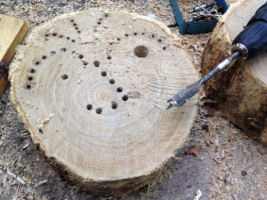
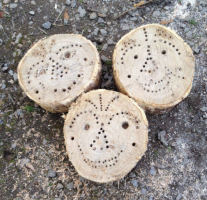
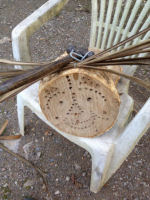
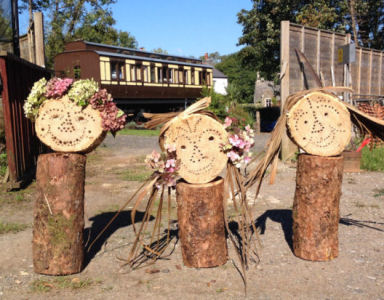
October 23rd 2015
Here is our video made for the Cornwall Sustainability Awards showing our carriages and gardens. We are rather pleased with it - being quite a novice with video editing. It was filmed on an ipad mini using a camera tripod Dave has adapted.
September 9th 2015
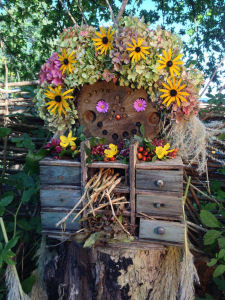 With autumn rapidly approaching, now is the time to become busy and prepare shelters and logpiles for hedgehogs and other hibernating mammals. It’ also a good time too to make a bug houses to help bees and other flying insects and invertibrates get through the winter. Here is some advice on how to go about it all. I shall certainly be putting in some new houses this autumn; they are great fun to make.
With autumn rapidly approaching, now is the time to become busy and prepare shelters and logpiles for hedgehogs and other hibernating mammals. It’ also a good time too to make a bug houses to help bees and other flying insects and invertibrates get through the winter. Here is some advice on how to go about it all. I shall certainly be putting in some new houses this autumn; they are great fun to make.
The great thing about bug hotels is that they can be as simple or complex as you wish; it is very easy to use a favourite theme as a subject (eg train...) as the basic components are pretty simple.
What you need is a series of tubes, or holes drilled in wood. The optimum size is between 2mm and 10mm; any larger and these aren’t any good for bees. They ideally need to be as smooth as possible. You can have a mixture of tubes and wood with holes, this would work well. You can buy bee sized cardboard tubes online; try Wildlife World or Bird Food - replacement mason bee tubes
Clay bricks with holes drilled in provides another habitat, as does cardboard and straw, which can be stuffed into terracotta plant pots. Bee ready clay bricks are available from Waitrose online, or at Green and Blue
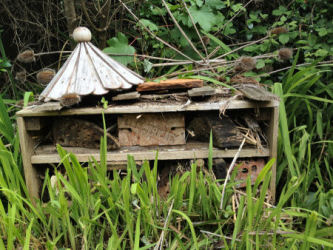 Another option is wall mounted hotels. What we have done works well, simply pieces of chestnut with holes drilled in them; you can make faces, trains, or whatever you like. When we do more we’ll make the holes much smaller; in our current hotels, the smallest holes have been used but the bigger ones have not.
Another option is wall mounted hotels. What we have done works well, simply pieces of chestnut with holes drilled in them; you can make faces, trains, or whatever you like. When we do more we’ll make the holes much smaller; in our current hotels, the smallest holes have been used but the bigger ones have not.
I love this video from Organik Mechanic for instruction on how to make simple small wall mounted hotels; DIY Insect Hotels - 4 different designs for hanging in trees and on walls
Ideally you should try to plant near a bed with bee friendly plants; for a year round display I’d recommend rosemary, crocus, dwarf comfrey, sedum, lavender, Michaelmas daisies, cosmos, phlox, mint and marjoram.
September 8th 2015 - Wildlife Gardens
It's been a shockingly long time since I wrote anything in this blog, but it is not because we have been idle; we have been to and fro excitedly watching the pond in Hayle taking shape (and learning as we have gone along). The wood has had new signs and I’ve made a treasure hunt for the children, which we had a go at last week, which was great fun. I have also made a page all about our wildlife gardens, which you can read here.
June 12th 2015 - Celebrating Business Membership of Cornwall Wildlife Trust
 Hurrah! We are now officially business supporters of the Cornwall Wildlife Trust. Here’s our speech!
Hurrah! We are now officially business supporters of the Cornwall Wildlife Trust. Here’s our speech!
We are proud to be Business Members of Cornwall Wildlife Trust. As Cornwall’s leading local wildlife charity, the Trust carries out vitally important conservation and educational work throughout the county. Our support helps the Trust manage 57 nature reserves, providing refuge for nationally rare and endangered species. Cornwall Wildlife Trust runs a number of conservation projects across the county, on land and in our seas. We are very happy to help raise much needed funds for the Trust, so it can continue to protect Cornwall’s wildlife and wild places, now and for the future.
June 1st 2015
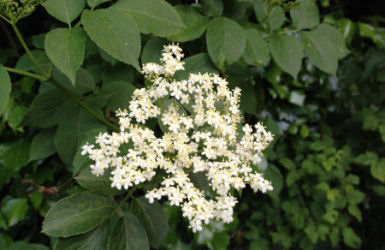 The elder flowers are out. The elder has a long history of medicinal purpose. This woody shrub with its scented lacy flowers and edible berries is a must for any wildlife garden. And even better, at this time of year you can make Elderflower Fizz, the taste of my childhood summers. This recipe is one I’d like to say was handed down in a passage of ritual by my mother, but actually I smuggled it from her kitchen bookshelf a few years ago and luckily she knows it so well she’s not yet asked for it back. This is from a copy of Farmers Weekly, July the 11th 1975.
The elder flowers are out. The elder has a long history of medicinal purpose. This woody shrub with its scented lacy flowers and edible berries is a must for any wildlife garden. And even better, at this time of year you can make Elderflower Fizz, the taste of my childhood summers. This recipe is one I’d like to say was handed down in a passage of ritual by my mother, but actually I smuggled it from her kitchen bookshelf a few years ago and luckily she knows it so well she’s not yet asked for it back. This is from a copy of Farmers Weekly, July the 11th 1975.
Take four heads of elderflowers, 1lb 8ozs sugar (675g), 2 tablespoons white wine vinegar, 1 gallon cold water, 2 lemons. Put everything in a bowl; squeeze the juice from the lemons then quarter them. Leave to stand for 24 hours. Strain (through a sieve is fine) and bottle. We use plastic bottles, as the tops can then be loosened from time to time when the pressure rises. It is best to leave them for two weeks, but the fizz can be drunk after a few days.
May 25th 2015 - A New Pond for Harvey
Our pond at Harvey has begun. We’ve cleared part of the drainage ditch to make a really good sized pond. The balance is always between safety and aesthetics; we wanted to have a completely natural look without the interruption of a grid over the top, so have decided to place a safety grill a few inches below the surface of the water, and put up a small fence with a padlocked gate to toddler and baby proof the area. This inevitably has added quite a lot of extra work, so summer Saturdays are going to be busier than ever this year!
May 16th 2015
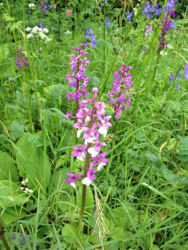 Cycling through the countryside at this time of year is a complete assault on the senses. It has been the best of years for violets and primroses, which have now bowed to the bright pinks of campions, blue bells, and the airy white of cow parsley. I've even seen lesser spotted orchids in the hedges by Bake and Ince castle. These pretty but fairly rare plants dislike being moved.
Cycling through the countryside at this time of year is a complete assault on the senses. It has been the best of years for violets and primroses, which have now bowed to the bright pinks of campions, blue bells, and the airy white of cow parsley. I've even seen lesser spotted orchids in the hedges by Bake and Ince castle. These pretty but fairly rare plants dislike being moved.
One of the joys of stopping beside a Cornish hedge is waiting for the rustle of movement. Many birds nest in hedges. The following comes from the RSPB Hedgerow Management Advice Page.
"In areas with few woods, many species of birds depend on hedgerows for their survival. At least 30 species nest in hedgerows. Many of these, such as bullfinches and turtle doves, prefer hedgerows over 4 m tall, with lots of trees, whereas whitethroats, linnets and yellowhammers favour shorter hedgerows (2-3 m) with fewer trees. Dunnocks, lesser whitethroats and willow warblers prefer medium or tall hedgerows with few trees. In winter, hedgerows can be feeding and roosting sites for birds.
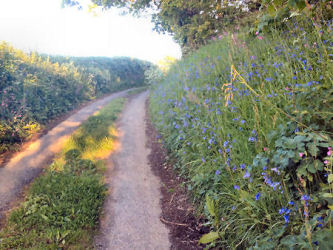 Wrens, robins, dunnocks and whitethroats usually nest low down, but song thrushes, blackbirds, chaffinches and greenfinches nest well above the ground level. Grey partridges use grass cover at the hedge bottom to nest. It is therefore very important to manage for a range of hedge heights and tree densities and to maintain a grassy verge at the base of the hedge.
Wrens, robins, dunnocks and whitethroats usually nest low down, but song thrushes, blackbirds, chaffinches and greenfinches nest well above the ground level. Grey partridges use grass cover at the hedge bottom to nest. It is therefore very important to manage for a range of hedge heights and tree densities and to maintain a grassy verge at the base of the hedge.
Grassy hedge bottoms and field margins provide nesting material and insect larvae for chicks to feed on. Wild flowers and grasses growing up into a hedge also help to conceal nests from predators. In winter, hedgerows can be feeding and roosting sites for resident birds and winter visitors such as fieldfares and redwings."
Do you know your finches? While I was routing around to check the difference between a chaffinch and a bullfinch I came across this Finch Quiz site, which was fun. I have to admit my score could have been improved!
May 6th 2015 - Soil
On the 28th March I had the pleasure of attending a soil day at Little White Alice organised by the amazingly energetic Manda Brookman as part of the Coast Project’s ReBoot scheme. It was fascinating day; I never knew there were 27 different types of earthworm, or that they passed their burrows from one generation to the next and that it can take up to 20 years to create a burrow (and just a few minutes of spade work to destroy one). Did you know there are many ways we can keep nutrients in the soil? Not digging, adding a mulch of cardboard and woodchip, or garden compost, letting our grass grow slightly longer before cutting it; all these things help. You can read more on Coast’s Soil PageApril 10th 2015 - Bumblebees
Browsing the Coast Reboot’s site I found the following link to a webpage, Bumblebee Conservation Plant Finder, where you can test the effectiveness of your pollinator planting. I was pleased that in St Germans our garden scored 6594 and 4577 in Hayle, both of which count as excellent scores for the size of the plots and well above the regional average of 2161. However with a top score in the South West of 8624, there is still room for improvement... I've got a list of plant suggestions to work on, so watch this space!March 24th 2015 - Plant Share Day
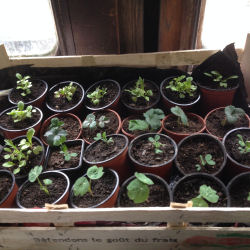 Now that the spring is coming, it is a good time to divide and share plants. Here at Railholiday we are celebrating the success of our first plant share day, that I hope will become an annual event.
Now that the spring is coming, it is a good time to divide and share plants. Here at Railholiday we are celebrating the success of our first plant share day, that I hope will become an annual event.
Inspired by the Coast Environmental Growth Reboot scheme, the aim was to get as many pollinator friendly plants into other people’s gardens as we could. In this I was assisted by the generosity of our good friends Rob and Fiona Sneyd, who have the most beautiful estate garden and who kindly allowed Lil and I to dig bucketfuls of snowdrops, vincas, geraniums, shasta daisies and forgetmenots. Added to our collection of dwarf comfrey, primroses, ajuga and herbs and all that our guests bought along, we had a fine selection of plants to share.
Our wonderful neighbourly chef Andy Keatings of Andy’s Travelling Diner donated burritos and goat cheese tarts, lots of cakes were bought along and we even raised a total of £96 for the Cornwall Wildlife Trust. Fiona and Rob’s garden at Coldrenick, near Menheniot, is open in aid of the Cornwall Wildlife Trust on Sunday the 12th July from 1‐5pm.
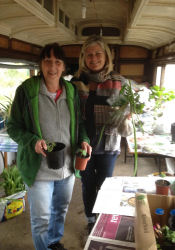
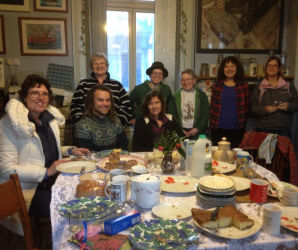
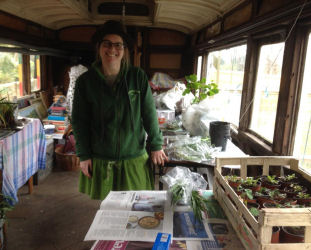
March 2nd 2015
Once again it’s time to give some thought to what to plant for our tree champions, who have all paid a £25 to plant a tree or hedge to offset their holiday carbon footprint. I felt that more hedges would be appropriate, so have planted another 200 odd whips, this time around the woods, of hazel, hawthorn, blackthorn, crab apple, bird cherry and dog rose. Digging was considerably easier this time; no decades of stone and rubble to contend with as there is in the new site and at Hayle, just beautifully soft leaf mould.
You can read about the trees that have been planted on our Tree Champions Page.
February 22nd 2015 - Golanthophilia
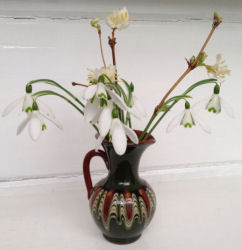 It’s galanthophile season, and Railholiday are finally biting the bullet and getting into the spirit of snowdrop accumulation. To quote from Wikipedia; "The term galanthophile was probably invented by the noted British plantsman and garden writer E. A. Bowles (1865 to 1954) in a letter to his friend Oliver Wyatt, another keen collector of bulbs, whom he addressed as "Dear Galanthophil".
It’s galanthophile season, and Railholiday are finally biting the bullet and getting into the spirit of snowdrop accumulation. To quote from Wikipedia; "The term galanthophile was probably invented by the noted British plantsman and garden writer E. A. Bowles (1865 to 1954) in a letter to his friend Oliver Wyatt, another keen collector of bulbs, whom he addressed as "Dear Galanthophil".
Wyatt may have been the first person to whom the term was applied but he was by no means the first galanthophile; as well as Bowles himself there had been keen collectors of snowdrops since at least the mid 19th century. Many galanthophiles are commemorated in the names of snowdrop species or cultivars. Nurseryman James Atkins (1804 to 1884) of Northampton was one of the earliest, and the tall, early-flowering, robust Galanthus 'Atkinsii' is still widely grown: Canon Ellacombe of Bitton distributed 'Atkinsii' widely."
We’ve had several small patches for many years; a few naturalised in the woods and some in our garden planted in the millennium. However after reading there are over 1700 varieties, this year I've been begging bulbs from friends, with the hope they may be just subtly different. Hence a trip to Coldrenick woodland for some exquisite, tiny double snow drops, and then on to more friends’ gardens in Trerulefoot, St Germans, Saltash, Downderry, Tideford Cross with trowel in hand. The plan for next year is to have a snowdrop walk in Colgear plantation, with clear clumps of different strains along the way. However, I suspect many of them may prove to be the same type! Still they do look rather lovely in vases...
December 2nd 2014
Can’t quite believe it has been so long since I last updated this blog! The fabulous autumn Michaelmas Daisies and Rudbekia have now gone over and we are into the season of periwinkles, Mahonia and Viburnum Tinus.

We have tried very hard over the last few years to improve the lot of our wildlife. This means more berried shrubs, more fruit and nut trees and of course flowers at all times of the year. By having flowering plants our pollinators will always have nourishment to keep them active, and given that we rely on them for our food, this is extremely important.
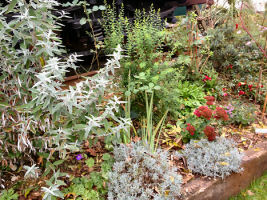 Today I went to a fabulous workshop arranged by the eco guru Manda Brookman of Coast, which really got me thinking about what we can all do to play our part in helping our pollinators. Cheryl from Cornwall Wildlife Trust suggested five things which I thought I’d share; log piles; ponds (even the size of a dustbin lid is enough if you only have a small garden); planting mixed sizes of plants from perennials and shrubs to trees; providing simple wildlife habitat - eg. pieces of wood with holes drilled in for insects, bird boxes; finally keep a little patch (or bigger if you can spare it) of longer grass for shelter for small mammals and hibernating insects. It was fascinating to hear from Cheryl about the positive benefit of wildlife gardening in the city as well as the countryside - we can all make a difference.
Today I went to a fabulous workshop arranged by the eco guru Manda Brookman of Coast, which really got me thinking about what we can all do to play our part in helping our pollinators. Cheryl from Cornwall Wildlife Trust suggested five things which I thought I’d share; log piles; ponds (even the size of a dustbin lid is enough if you only have a small garden); planting mixed sizes of plants from perennials and shrubs to trees; providing simple wildlife habitat - eg. pieces of wood with holes drilled in for insects, bird boxes; finally keep a little patch (or bigger if you can spare it) of longer grass for shelter for small mammals and hibernating insects. It was fascinating to hear from Cheryl about the positive benefit of wildlife gardening in the city as well as the countryside - we can all make a difference.

Some bumble bees need larger scale help, and this is where natural wildlife paths play their part. If we all join up our little bit of wildlife planting with our neighbours, then everyone can be happy. And what is more it can look completely stunning. We were delighted to win a prize from Caradon in Bloom for the Best Wildlife Garden last month.
September 29th 2014 - Autumn
It's been a few months since I last blogged, and there’s been plenty happening with the wildlife here in St Germans and Hayle. One of the most exciting events was the use of the nest box outside Harvey's kitchen window by a family of blue tits. Much time was wasted in late May watching the tiny birds practicing their flight that should have been spent painting the carriage.
>

This has led me to the thought of how do we feed these birds now that winter approaches? We put out fat balls, but that is only effective whilst someone is there to fill the feeders. Over the last few years I've given this an increasing amount of thought and concluded the soundest method is to let nature provide food. I've planted more hawthorn, crab apple, guelder rose, elder, dog roses and hazel, which should all help.
In St Germans the wildlife hedge is shortly to be complimented by the addition of a pond, which will attract small insects to stand on the bottom rung of the food chain. Piles of cuttings and wood trimmings have been placed around each site so there should be a plentiful supply of woodlice and spiders, as well as winter shelter for small animals. The ivy is just about to flower and I look forward to the bees and other flying insects gorging on the late summer nectar; as the berries mature so they provide further feed for the birds. Then the time spent filling feeders can instead be frittered away on a sunny bench watching the wildlife...
May 7th 2014 - Early Summer Musings
The hedgerows at the moment really do excel themselves; bluebells, stitchwort, campion, cow parsley, violets, alexanders and vetch putting on a superb show. Cycling in the lanes has been a real treat.

Summer is well and truly on its way - the swallows arrived a few weeks ago (pretty early this year) and the oak is out before the ash, always a good sign for a hot summer! We’ve been busy in the woods with the big fell of Japanese larch well underway, allowing the young native saplings to sprout from the undergrowth with enthusiasm. The remainder of the larch will have to wait until the winter; we’re glad to see no signs of the Sudden Oak Death that is killing so many of our conifers in Cornwall.

We had a lovely walk on Bodmin moor on the 27th April. Although it can sometimes seem like an inhospitable place, it is sometimes surprising to discover the range of wildlife on the moors. The children were delighted to discover tadpoles in the old mine tracks (oddly enough there didn't seem to be any in the larger pools) and while we were admiring them, we spotted a sheep giving birth on a high quarry ledge. We could see how she got there, but did question the logistics of how she might move her lamb to safety. On the way back it was lovely to buy free range eggs from a cottage on the edge of Minions and smell the honey of gorse in full blossom.
March 4th 2014
The rain and winds have continued, but the weather has been mild, so spring is now well and truly underway. Port Eliot House and gardens are open to the public, The Long Gallery Tea Rooms is serving afternoon tea and cakes and our gardens in St Germans and Hayle are positively flourishing.
I love the way at this time of year the daffodil buds take such a wide variety of shapes, our pale narcissi emerging from a nobbly extraterrestrial skin. 2014 is going to be the year our hellebore collection really comes into its own. Hellebores are a fascinating genus; there are so many of them and they hybridise freely. Last year I invested in a number of plants and we have a wonderful array of deep purple, yellow, mottled white and baby pink plants, all producing delicate flowers that will stay on the stem well into the summer.
The mild and windy weather has meant a noticeable decline in the number of birds needing our feeders. However the owl population has been as active as ever. It's never the trains that keep us awake at night (there aren't usually any), but the owls do a pretty good job! Nothing beats standing out in the evening and listening to the conversations between the trees and a few days ago I was rewarded by a beautiful barn owl flying directly above. A magnificent sight!

February 2nd 2014
What a wet time we’ve been having! However because it has been so mild, the daffodils are very nearly in flower, the snowdrops and hellebores are in full bloom and our bird feeders have been quieter because there is still plenty of food in the fields.
The fungi in our woodland continues to be interesting - the images above show a bright red Elf Ear fungus, and beside it a jelly fungus, Auricularia auricula-judae, traditionally used in medicine for complaints including sore throats, sore eyes and jaundice, and as an astringent. This fungus is a popular food in China, but here it is making the most of an elm tree that has succumbed to disease. We’re also still seeing plenty of moths - December and winter moths, and above left a rather interesting mottled umber that stayed for several days.
Work has started in earnest in our woods as we begin the mighty larch felling session. This we hope will reduce the chances of getting Phytophthora ramorum or, for ease of conversation, Sudden Oak Death. Misleadingly it is far more of a problem to larch than oak; English oak seems to have good resistance. The plan is to re-plant with mixed native broadleaf species; lime, rowan, oak, beech, ash, sycamore and cherry among others. A lot of regeneration is already in place: an open canopy will allow our few stunted oaks to survive, so while our woodland is starting to look rather scruffy in a few years the work should pay dividends.

December 17th 2013
As we head towards the shortest day it is so mild it still feels like the season of mists and mellow fruitfulness. There are roses in bloom and even the holly is holding on to a few berries - the birds have usually stripped them by late November. We had one night that was a little frosty towards the end of November that persuaded the walnut to shower its leaves, but there are still a number of trees holding on to their autumn coat and giving a glorious show of colour. From the woods the village elms are a distinctive luminescent yellow.
John the moth man is visiting less frequently now. We've had a spattering of November and December moths. It's been a very good year for moth spotting - John was excited earlier in the season to see a vestal moth and there's been a number of uncommon species, although this year the tiger moth has been sparse.
I'm always glad of greenery this time of year as the flowers become harder to find. We made our wreath from rosemary, bay, ivy, holly, verigated viburnum, lonicera nitida 'Baggesen's Gold' (evergreen shrub of the honeysuckle family, sometimes called boxleaf honeysuckle) and two different varieties of euonymous, which come into their own at this time of year. I constructed the hoop from willow from the garden and tied it all together with a skein of jetsam wool I'd found on Portwrinkle beach, which reminds me that now is the season for beachcombing - wild seas, empty coves ... what better way to spend a winter's day.

November 29th 2013
It's been quite an extraordinary season for fungi. A few of them are illustrated above, including quite the most startling coral fungi I've seen. This bright orange yellow antler fungus was photographed during a cycle ride on the Tamar mining trails, which was a great place to go for unusual flora. The other fungi is just a small selection of the species we have had in our garden this year in St Germans. The dog phallus (or dog stinkhorn) toadstools are uncommon, but certainly distinctive. They are enjoyed by insects, which they depend upon for reproduction. The large mushrooms that seem like field mushrooms came with a bit of a warning - when the stem was split the flesh was very yellow, giving away its true identity - the toxic yellow stainer.

October 16th 2013
What a glorious summer - and this year we've been rewarded by a glut of apples and blackberries. However now it's time to start making preparations for hibernating small animals. I always find Gardeners' World a great source of inspiration for wildlife projects and so really enjoyed making the hedgehog house above out of scrap material from Mevy. Our gardener Dave, who installed the toad shelter, made the observation that a hedgehog might well be more tempted by the large woodpile clad in wild clematis, but it was fun to do.
I also really enjoyed making the bug hotel - a great way of using old Alexander stems, wood trimmings and hydrangea heads. As I pulled the Alexanders from the ditch they were writhing with woodlice and small spiders. It was a comfort to think they were being relocated from a home that would soon be underwater. There are lots of sites offering guidance on insect hotels - here's one I found earlier; Building an Insect Hotel.

August 24th 2013
After all the rain and a slow start to the season, this year’s wildlife spotting looked like it would be disappointing. However the sun came out in June and July and we've had a bumper year for interesting moths and lots of butterflies. We’ve had lobster moths, buff tips, dingy and four spotted footmen, tiger moths, black arches, white ermines and many more. I've put up the occasional posting on the Facebook Page Butterflies and Moths Uk, which I would recommend for anyone with an interest in wildlife.
One of the reasons this blog has been so quiet over the last few months is that we've been extremely busy with several projects to improve our wildlife habitat, and I'm really pleased to report they’ve been successful. There’s now a lovely lavender bed in front of Mevy, which is swarming with bees and the butterflies have loved the buddleias and sedum, which were divided and re-distributed in the spring. I've planted a herb and butterfly bed in Hayle and although it struggled in the very dry weather, it is now looking great - the garden there is a sun trap and our signal box playhouse/bird house has a balcony for butterfly viewing. I have to say it was bliss sitting in the signal box eating lunch and watching the un-suspecting blackbirds in the hedge.

March 5th 2013
Has February really been and gone already? It was a great month for bird watching, both at Hayle and St Germans. We've had a pair of nut hatches, lots of different tits, blackbirds, robins and even a chiff chaff. Work has been going on at Hayle in the newly renamed Harvey's garden. We've fenced off an area for a herb and butterfly garden and spotted a brown mouse while we were doing so. We've also put up a number of bird boxes - my very knowlegable brother Richard used off cuts from the fence and has designed different styles for the different birds. These can be watched from the comfort of a carriage compartment - lets hope they see some action this year!
In early February the first of the snowdrops, daffodils and crocuses came up and now the gardens are flushed with colour; anemones, hellebores, haiacynths, winter jasmine, heather, mahonias and camellias have all joined the show. The almond blossom is also out - so we're keeping our fingers crossed there won't be any late frosts.
January 7th 2013
It would be difficult to pretend that at this time of year the garden is as blooming as it is in June. However among the winter hibernation there are a number of flowers quietly opening to brighten the landscape and make my job of flower arranger a little easier. Here is a list of those that I spotted today; Winter Jasmine, Greater Perriwinkle, Camillia Sasanqua (Rainbow), Quince - Crimson and Gold, trailing Rosemary, Crocus (just one at the moment but lots to follow), Dog Daisy, Heuchera, Heather, Mahonia, Japanese Anenome, Primula, Roses, Viburnum Tinus, Hebe, Wintersweet, Wild Strawberry, Wall Flower and Campanella. Of all of these the Jasmine and Mahonia have the most impact, with great sprays of yellow flowers. The snowdrops are not yet out, but are showing signs of life, as are the hellebores and daffodils, which should put on a lovely show this year - fingers crossed for no frosts!
January 2nd 2013
Whilst I've been busy catching up on office work, the outside world has been active. Our feeders continue to attract a lovely selection of birds and the ones under the Macrocarpa tree in the Old Luggage Van are especially popular - in constant need of more nuts and seeds. I thought today would be a good time to do a top ten for plants of 2012, but have found it harder than I thought - not enough numbers! Where do I put the asters, sweet william, wallflowers, fennel, crocus, roses, teasel ...? Perhaps another list beckons!
10. Sage - In the spring it was lovely to see our bushes covered in mating ladybirds. The plants we put in five years ago have suffered from an ants nest at their root and have become somewhat woody, so this sping will be due for renewal.
9. Viburnum Tinus - providing lovely scented flowers throughout the winter, from November to May.
8. Apples - Cornish Aromatic, Cornish Gillyflower - normally these would come fairly close to the top, with their lovely spring blossom and delicious fruit. 2012 hasn't been a good year for fruit but the birds have enjoyed a few spoils and the blossom looked lovely in spring
7. Escallonia - this has provided a dense hedge for the birds in the site at Hayle, and is never quiet - there's always a shuffling of wings going on.
6. Hawthorn - this has kept the birds fed in Hayle where we aren't able to keep a regular food table supplied.
5. Victoria plum - one of our trees did really well this year and what we couldn't eat ourselves was much enjoyed by wasps and mice.
4. Mint - not only does it reproduce prolifically and is useful in the pot, but was much appreciated by both bees and butterflies.
3. Lavender - this was covered in bees in the late summer when the sun finally came out, and I was still able to pick the odd head in December.
2. Japanese Quince - this was nearly the number one as it's been such a star performer, covered with flowers, and laterly fruit, since the first of January. This year there hasn't been a day without the cheerful red flowers adorning the fence and the buds covering the limbs indicate the season is just about to go into overdrive again.
1. Oak - the birds have loved perching here for shelter and pecking at the lichen, and the leaves have been a valuable source of food for moths, which shelter on the building wall. The acorns have all disappeared, so I imagine they've provided food for the smaller creatures. I've chosen this to top the charts as it is host to many things we can't see or don't notice much - tiny invertibrates and all sorts of lichen.
October 12th 2012
The birds are very much enjoying the feeders now. We've had stone chats, blue tits, sparrows, robins, great tits and several other small birds. Among the moths spotted recently we've had Angle shades, 2 common carpets and a green carpet today. Our lovely friend John who comes and identifies moths at our house recommended an excellent site for moth identification Uk Moths. Over the last month we've watched a Tiger Moth feasting on our mint, the lavender swarming with bees and many different butterflies enjoying the September sunshine - Speckled Wood, Red Admiral and Peacock to name a few. The lovely Brimstone moth came and stayed for a few days too, keeping company with a Black Arches.

August 23rd 2012
The weather has set fair and at last we've been able to enjoy butterflies, moths, bees and other flying insects enjoying our garden. Early in August we spent a few days with friends in Brittany and I was amazed at the wealth of butterflies there. We were staying in rural farm land, with few cultivated gardens but a wealth of wildflowers; hemp agrimony, birds foot trefoil, knapweed, ragwort, willowherb, bramble, poor man's weather vane, broom and vetch. This has led to a spot of research on the best garden plants to attract flying insects, in particular moths, as we have noticed a big decrease this year in the numbers we've seen. A posting on the wonderful environment advice site Coast - One Planet Tourism came up with the following advice;
From Charlotte Dancer of the Tamar Valley AONB;
"I've been chatting with our bat & moth expert, Martin Summers, and he recommends that you plant anything nectar-bearing, such as early flowering honesty, ice plants (sedum), Michaelmas daisies, centaurea (knapweed), teasels or honeysuckle."
From Steve of Explore In Cornwall
"Quite a few moths love Tobacco plants and night-scented flowers like Evening Primrose, Night-Scented Stock, Jasmine and Honeysuckle, a Cornish favourite is the six spot burnet which likes bird's foot trefoil, the less common 5 spot burnet likes Greater bird's foot trefoil - both native plants."
Elephant hawk moths go for Rosebay willow herb and Puss moths like willow. Humming bird hawk moths are migrants but lay their eggs here on lady's bedstraw which is easy to grow as it is so abundant naturally here.
A quick search for Lady's Bedstraw images found me on a site specialising in Moth and Butterfly breeding. The Lepidoptera Breeders Association where they sell a variety of butterfly and moth friendly plants, including dock and dandelion!
My brother Richard also sent a posting on Facebook, which was useful. He writes;
"Willowherb, Ragwort!! (Maybe not), Mulberry, Oak all good for moths...I don't think Willowherb is too invasive, but it will colonise open ground (during WW2 it grew well on the sites of bombed buildings) Elephant Hawkmoths love it. Good idea to leave Ragwort out of garden, as is quite toxic. Honeysuckle is good for Hummingbird hawk moths, as well as other insects and birds, but I think you have plenty of that. Ivy also seems to provide food and shelter for lots of creatures, but spreads rapidly. Good for covering a shady wall perhaps.(The ivy covering the wall in our garden grew from seed). Heather attracts Emperor moths, but may be hard to grow enough in your garden, and these moths are mainly found on moorland. Hawthorn in hedges also supports several species, including Magpie moths. Most tree species seem to have their own specific species of moth, as well as others which feed on several. Enjoy the planting and see what comes along!!"
Of the moths spotted this month we've had Yellow Brimstone, Black Arches, Jersey Tiger, Double stiped pug and several other small unidentified moths. We also have seen a rather magnificent Southern Hawker dragonfly.
August 1st 2012

There's been lots to watch these last few weeks as wildlife activity hits its peak. At Hayle I was delighted to see a frog who surprised me with his rustling through the undergrowth and today saw a tiny frog in our garden in St Germans. We took a trip to Cuttivett to pick up an old mower blade and were amazed at the invertibrate town beneath it - an extraordinary ants nest, with two slow worms and a mouse as company. In the woods we were delighted when a buzzard landed on the table outside our work retreat. There's also been plenty of activity in the way of butterflies - this lovely small white was hovering around the cabbage that we grow for butterlies.

On interesting wildlife plants we've had wild carrott and hemp agrimony and the pear tree I've been waiting for eight years to fruit has finally produced an apple! (I have a feeling it may have come from the lucky dip stand at Trago...) We had a visit from the Forestry Commission to check the health of our woodland, which was thankfully given a thumbs up, but we will need to consider a management plan for thining our larch as sudden oak death is rapidly encroaching the area and we want to do all we can to save our sweet chestnuts, which are also affected by the plant pathogen Phytophthora ramorum.
July 13th 2012
It's certainly been a wet few weeks - great for my hedge, but not so good for everything else. I was heartened to see bees on our catmint today during a brief interlude of sunshine. Poppy and I spotted three bullfinches from the station footbridge and tonight there are a number of moths beneath the canopy, where they are always glad of shelter. I've not seen our moth man John much over the last few weeks as it has just been too wet and windy, but if the weather settles he'll come and name them for us.
Woodlice seem to be doing very well in our garden - it's a race for the ripe strawberries! We've noticed an increase in mice activity - the small herbs I've been planting; parsley, thyme and sage; have disappeared overnight. I noticed a bird's nest in the Millpool coach the other day although I've not yet noticed a lot of action there.
The Sweet William are now in full flower and the roses have been bedragled but magnificent. I was delighted to see a number of my semi ripe cuttings taken last autumn are showing good signs of growing into strong plants. I've just put in 36 plug plants of lavender (thank you Gardener's World!) which will be perfect in two years for our sensory butterfly garden that is in the planning. The quince has set a number of fruits, although the other fruit trees aren't so good - barely any apples or pears. There wasn't a late frost, but I do wonder whether the gale force winds and rain earlier in the season may have played their part - still it's a rest year, so hopefully next autumn will yield a bumper crop, and we do have quite a few plums on the newest of our trees to look forward to. It's also been the best year for raspberries - and without having to do any watering at all - what a change from last year!
May 29th 2012
The first cuckoo was heard on April the 26th and a week later on a walk on Bodmin Moor we heard another calling away. Now that we're approaching June the garden is truly blooming - the first roses opened on Thursday 24th May. The garlic in the woods is going over, but the bluebells are still fabulous and the show this year is the best ever. We've seen a number of orange tipped butterflies, cabbage whites and peacocks. A huge number of ladybirds congregated on our sage bush earlier this year and as always we are inundated with friendly blackbirds among the rose beds. Amazingly the quince that first came to flower in January is still looking stunning now. The wallflowers have performed sterlingly, the hedge is becoming well established and the camellias are full of new growth. Now just to keep on top of the weeds!

April 23rd 2012
The first swallows were spotted on the 14th April. We've seen evidence of deer in the local woodland and are waiting for glimses of baby badgers in our woods, who are often less shy than their parents.
Everything is bursting into life - there's now too much to name that is in bloom - exchordia, camellias, primroses, viburnum burkwoodii, spirea, hellebores, wallflowers and much more. The daffodils splendid show is coming to an end, but many of the late narcissi are holding their own. Buds are forming on the roses already, so we may have some early flowers. The treat at this time of the year is the fabulous show of wild garlic in our woods, which will soon be followed by the bluebells, always a little later. Mulching has kept me busy, but I'm now reaching the bottom of our woodpile. We've had plenty of rain, which has been great for the hedge, but not so good for our guests!
March 1st 2012
Our wildlife hedge is now almost complete. We have planted a mixture of hawthorn, blackthorn, crab apple, hazel, field maple, guelder rose, bird cherry, spindle, beech, dog rose and an occassional rugosa rose. Now it's just a case of keeping it well mulched, weeded and watered and having patience.
The garlic is coming up in force in our woods, and at the end bluebell leaves are taking the fore. Today as I refill the peanuts it gives great pleasure to take stock of the wide variety of birds we've had visiting; blue tits, robins, blackbirds, bullfinches, sparrows, goldcrests and many more. The woodpigeons nest in the trees and enjoy the ivy, of which there is plenty.
Yesterday John, our moth spotter, visited. It's a little early yet for anything of any significance, but his visit did inspire us to think that spring will soon be here.
Flowering today; Many different varieties of camellia, Viburnum tinus, daffodils and Narcissus, including the pretty tete a tete, hayacinth, osmanthus, hellebores, wallflowers, crocuses of many species, which are brightening up the Luggage Van garden, wood anemone, winter jasmine, and a Burgundy Ice rose that has been completely fooled by the mild winter.

Back to TOP
Contact Railholiday by email at office@railholiday.co.uk or by phone on (+44) 01503 230783. ©





